Allison Collection Photos
January, 1943
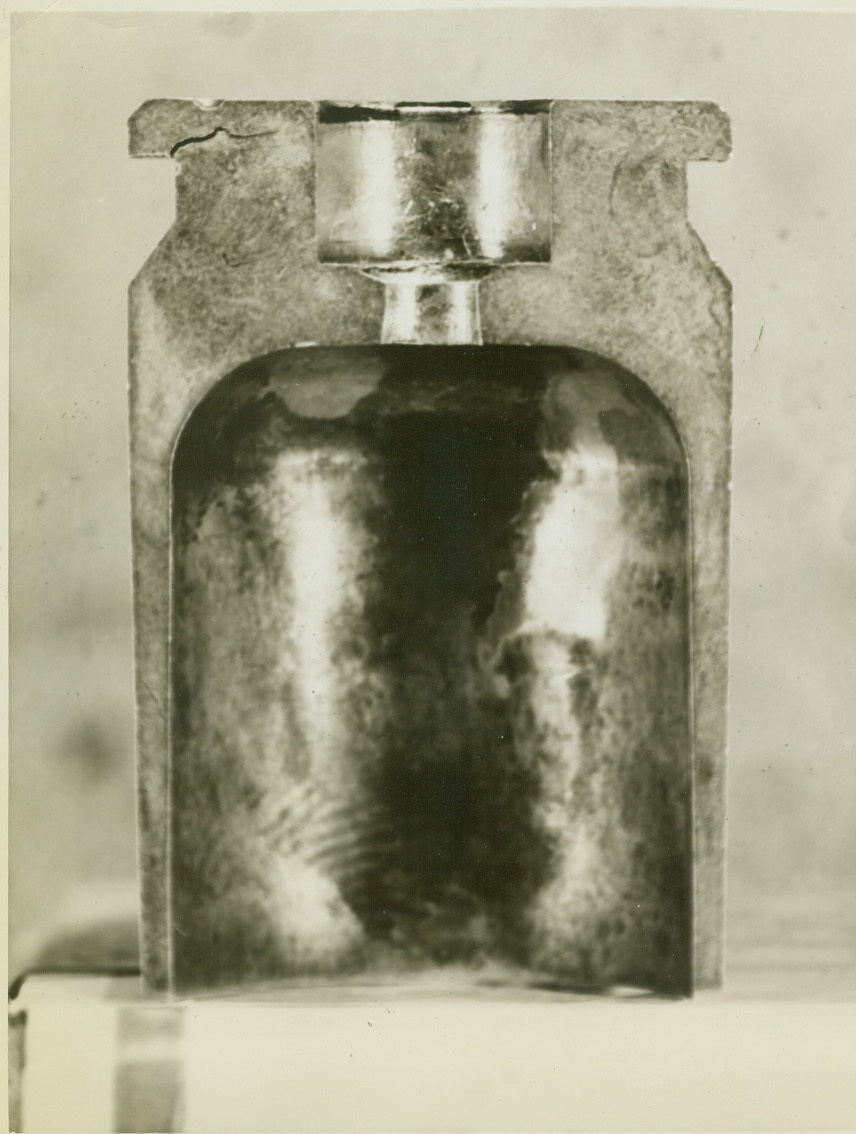
ALLEGEDLY DEFECTIVE, 1/5/1943. ST. LOUIS, MO. – Cartridge case produced at St. Louis Ordnance Plant, showing a crack in upper left corner. Inspectors charge that too large a proportion of these cases are defective. Credit: ACME;
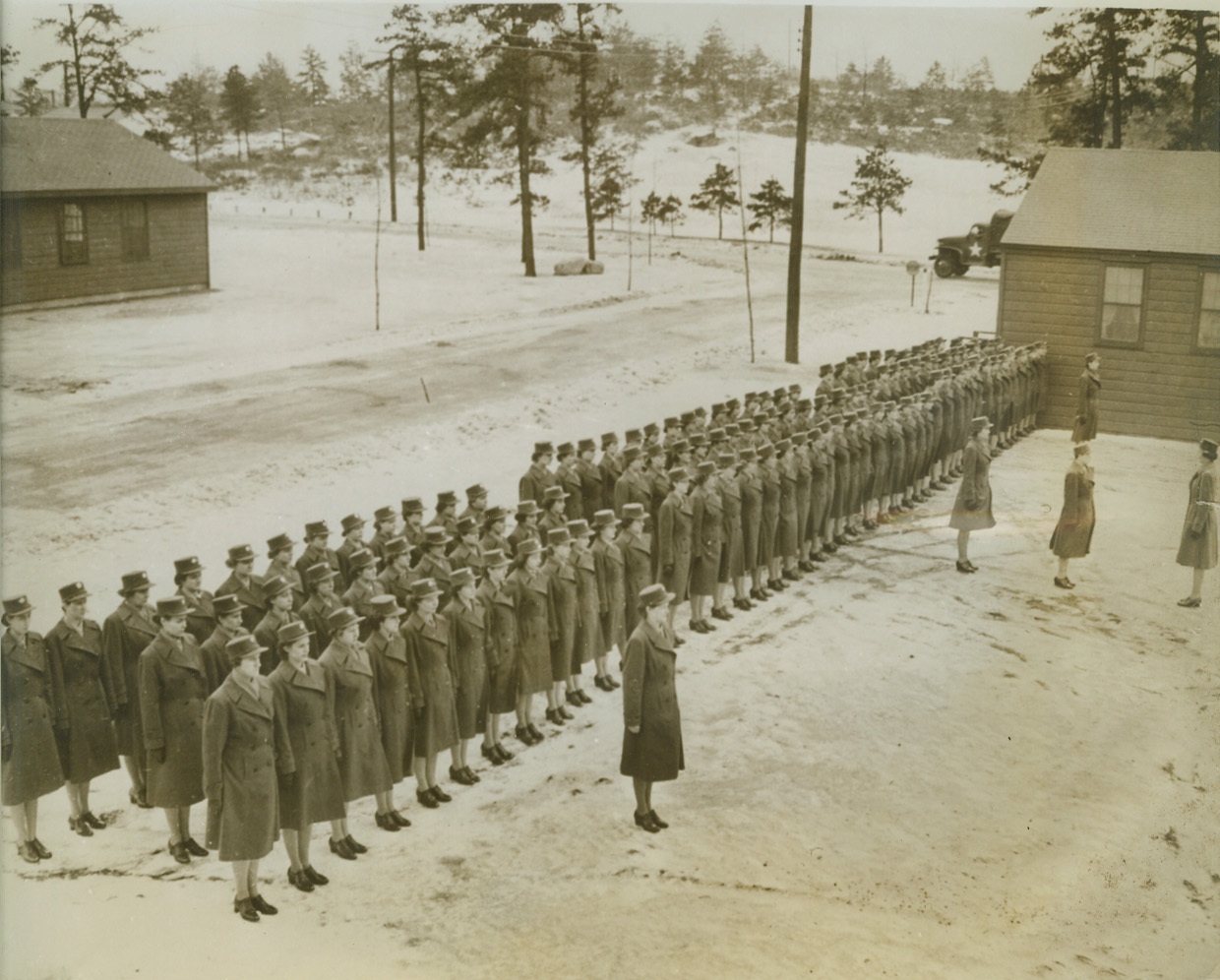
ROLL CALL FOR THE WAACS, 1/3/1943. FORT DEVENS, MASS. – The entire company of WAACS stationed at Fort Devens, assemble for roll call on the snow-covered grounds of the Fort, and a mighty fine-looking group of soldiers they make. Credit: Signal Corps photo via OWI Radiophoto from ACME;
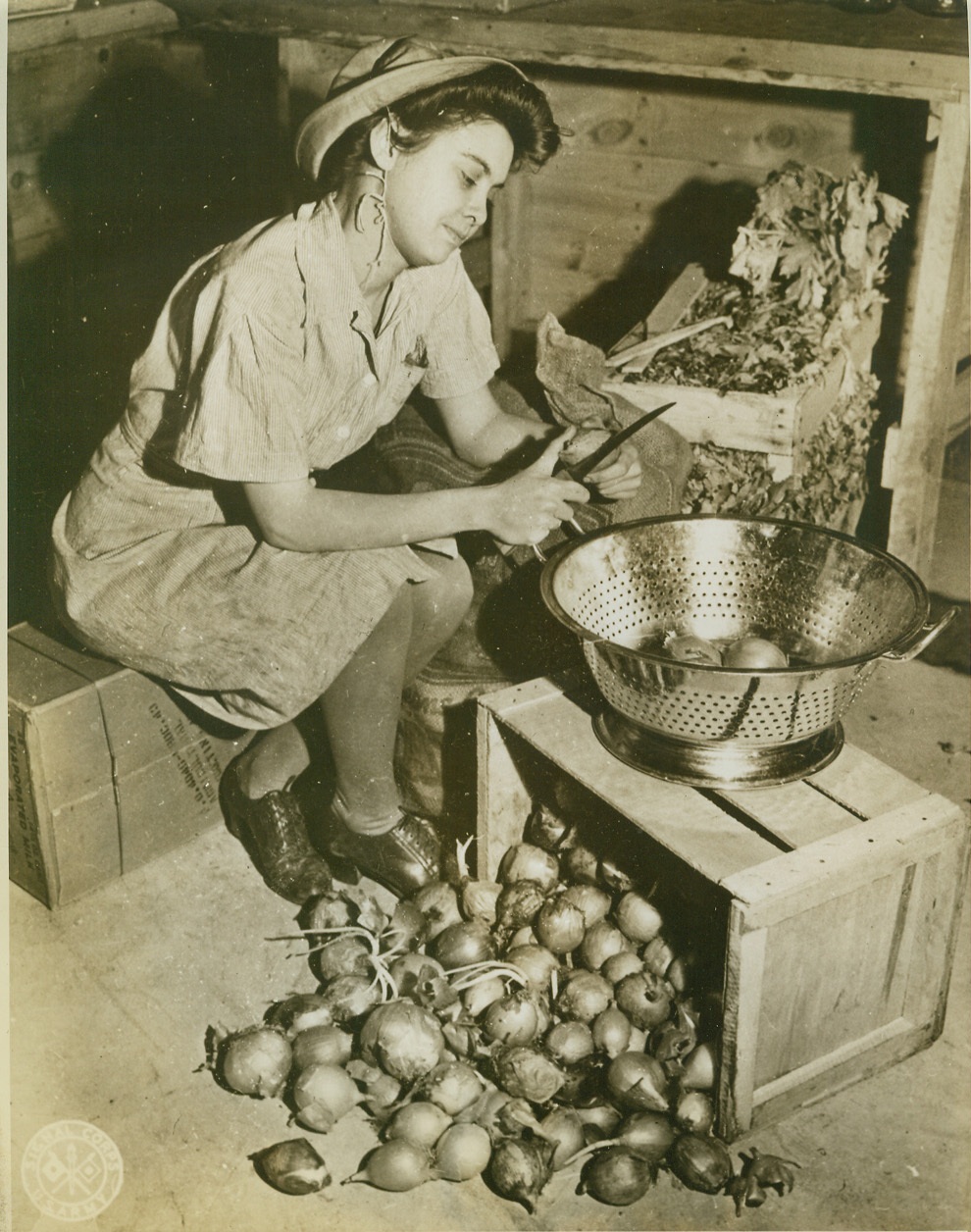
DON’T CRY, LITTLE GIRL, 1/3/1943. FORT DEVENS, MASS. – If there are tears in WAAC Ruth Ballard’s eyes, blame it on the onions. If she joined the Army to escape the kitchen, tho’, she’s a mighty disappointed young lady, because she drew a KP assignment during her first day on duty at Fort Devens. Credit: Signal Corps photo from ACME;
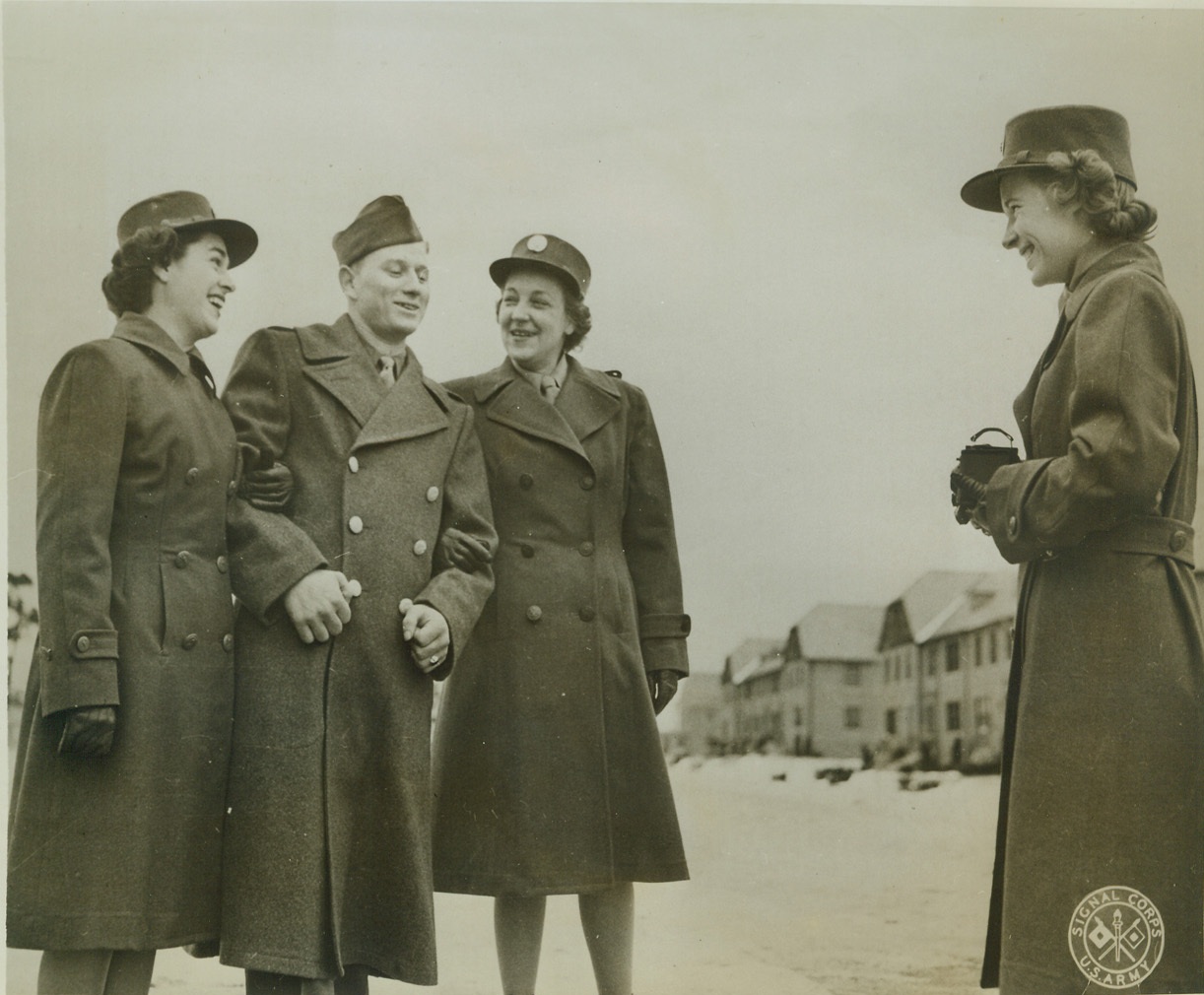
FOR THE FOLKS BACK HOME, 1/3/1943. FORT DEVENS, MASS. – Private Aime Courmier of Westbrook, Me., poses for a photo to send to the folks back home with WAACS Mary Welsh (left) of Vincennes, Ind., and Rebecca Carey of Durham, N.C. Alice Games of Boise, Idaho, takes the picture on the grounds of Fort Devens, where the girls have been assigned to duty. Credit: Signal Corps photo from ACME;
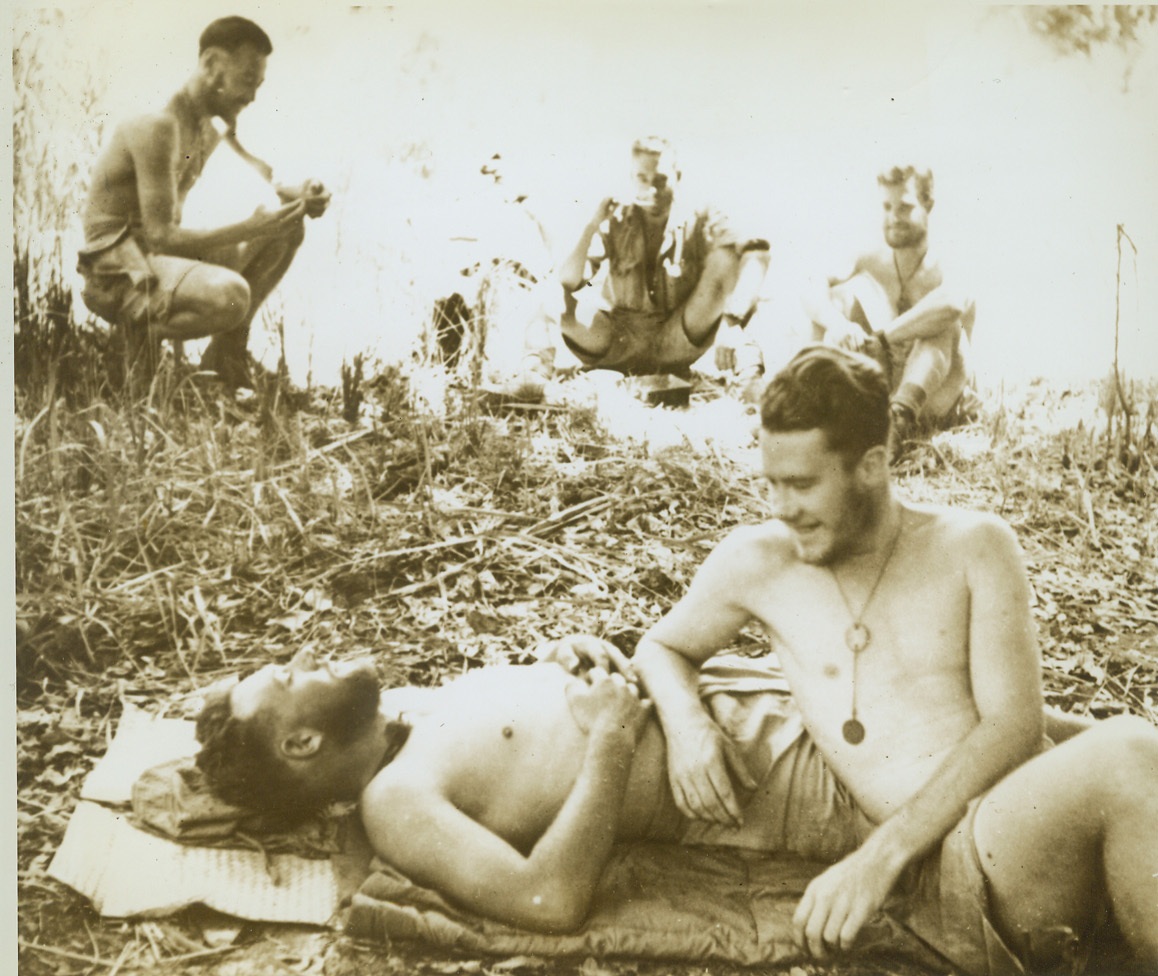
TIME OUT FROM SNIPING, 1/25/1943. TIMOR ISLAND – Australian guerillas rest in their jungle hideout on the Jap-held island of Timor. These Aussie snipers live virtually in the midst of the enemy and are as annoying to the Nips as a deluge of red ants. (Passed by censors.) Credit: ACME;
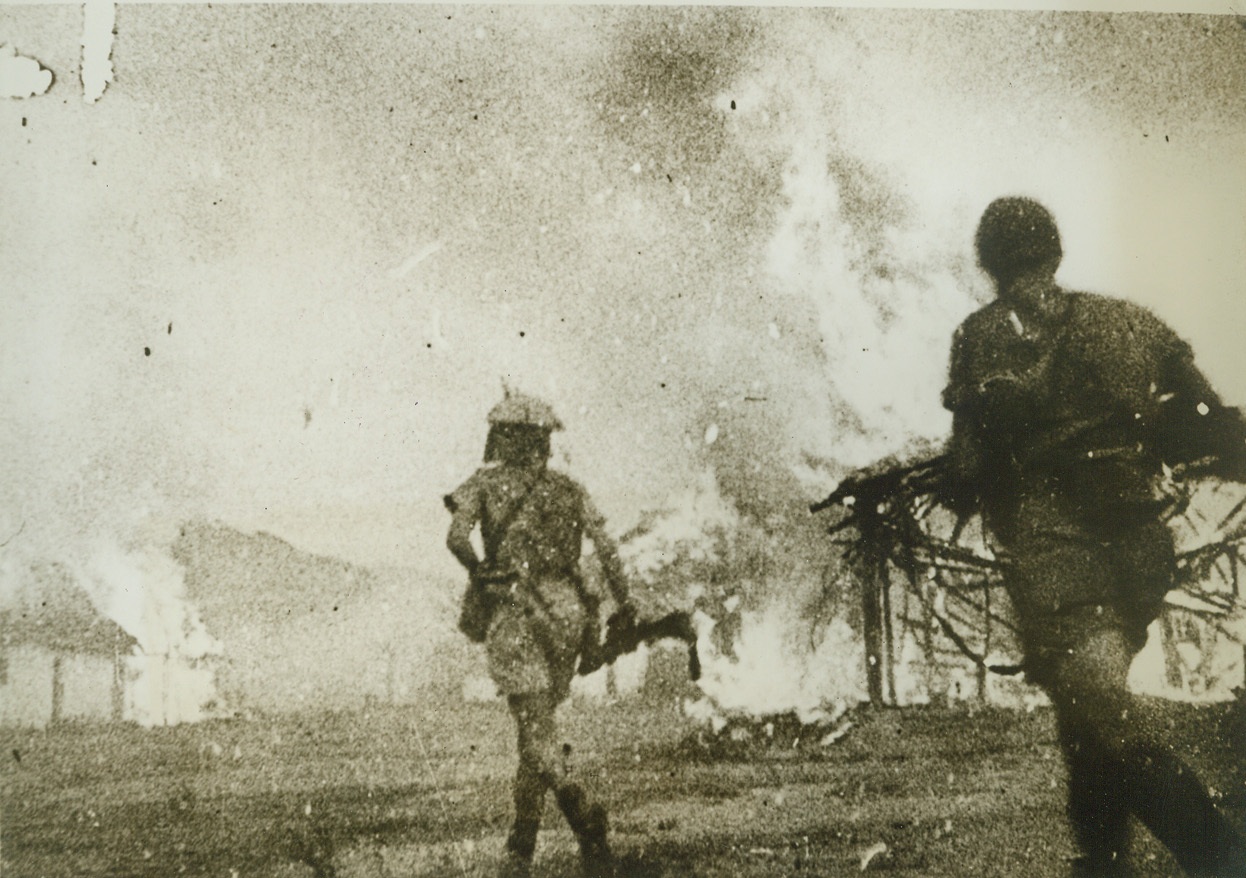
AUSSIES THWART JAPS ON TIMOR, 1/25/1943. TIMOR ISLAND – Two Aussie guerilla fighters take it on the lam after setting fire to the native village of Mindello, on Timor Island, which the Japs were planning to use as an air base. Aussies paid Timor natives to build quarters and are on the best of terms with the dark skinned people whose home the Japs have invaded. (Passed by censors.) Credit: ACME;
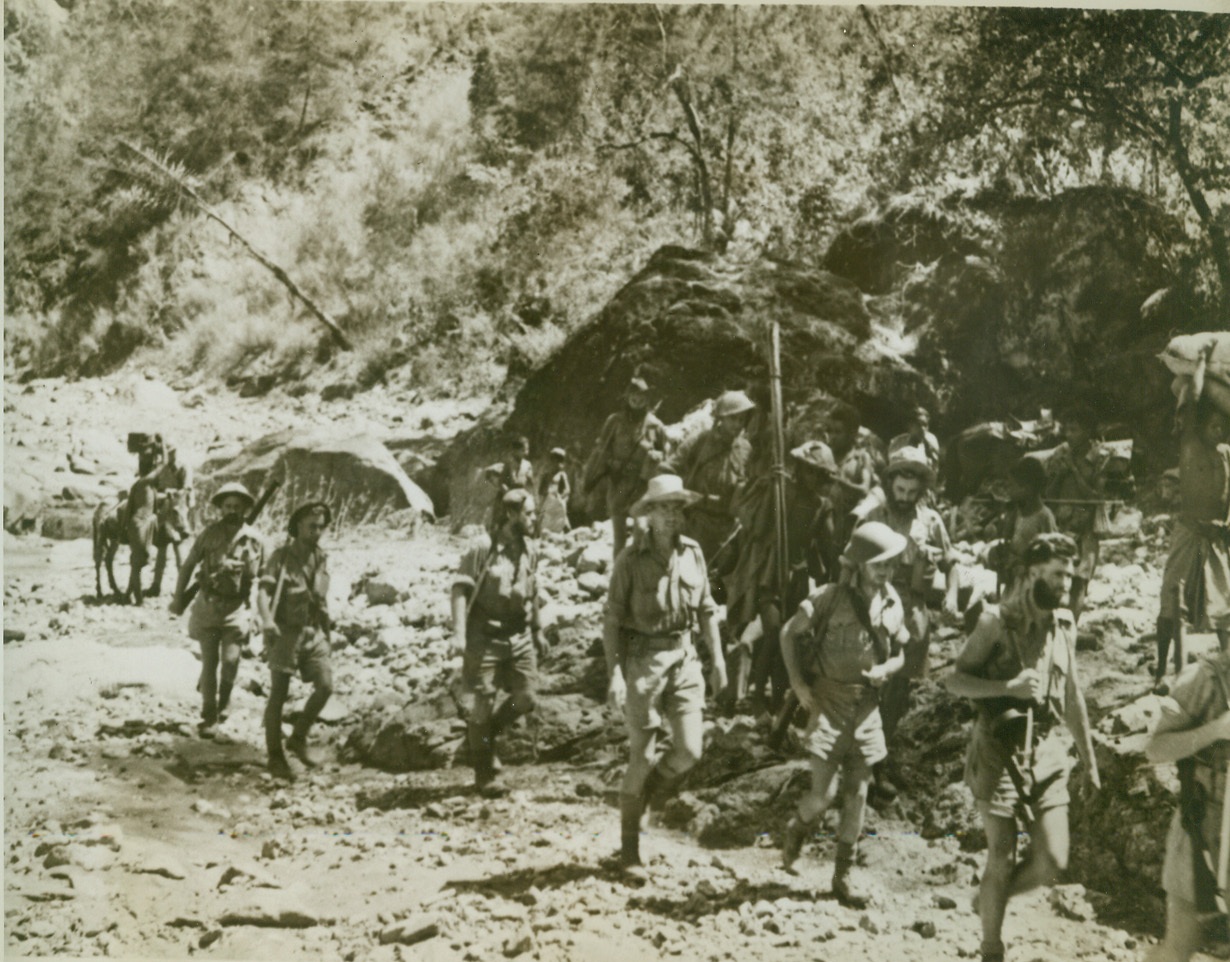
AUSSIE GUERILLAS SWAT – THEN DODGE, 1/25/1943. TIMOR ISLAND – A Battery of Australian Guerillas move on, after accomplishing a lot of dirty work on Nips and their strongly entrenched installations on Timor Island. The Aussies, living on Timor Island with the enemy, use hit and run tactics against the forces which vastly outnumber them. Credit: ACME;
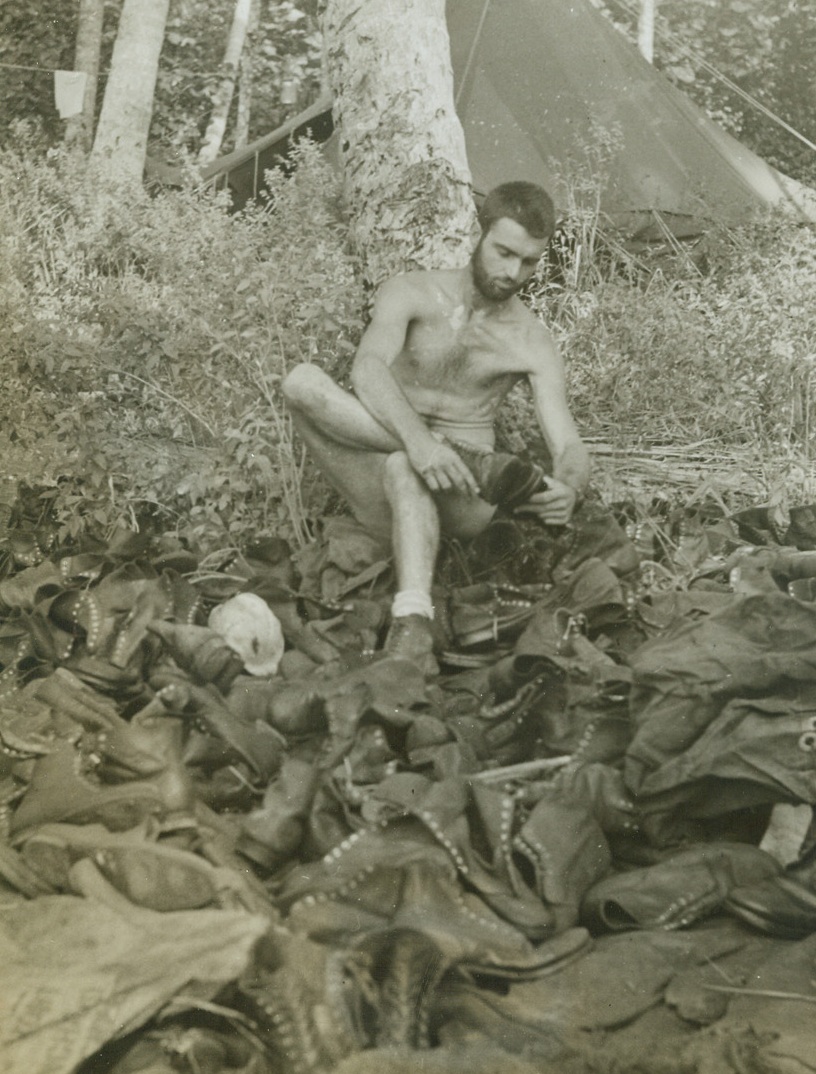
Seek And Ye Shall Find, 1/4/1943. NEW GUINA—SGT. George Brownell of Platterville, Wis., is looking for a pair of shoes in a salvage dump in a native village in New Guinea. This photo was taken at the start of the American offensive to retake Buna.Credit ACME;
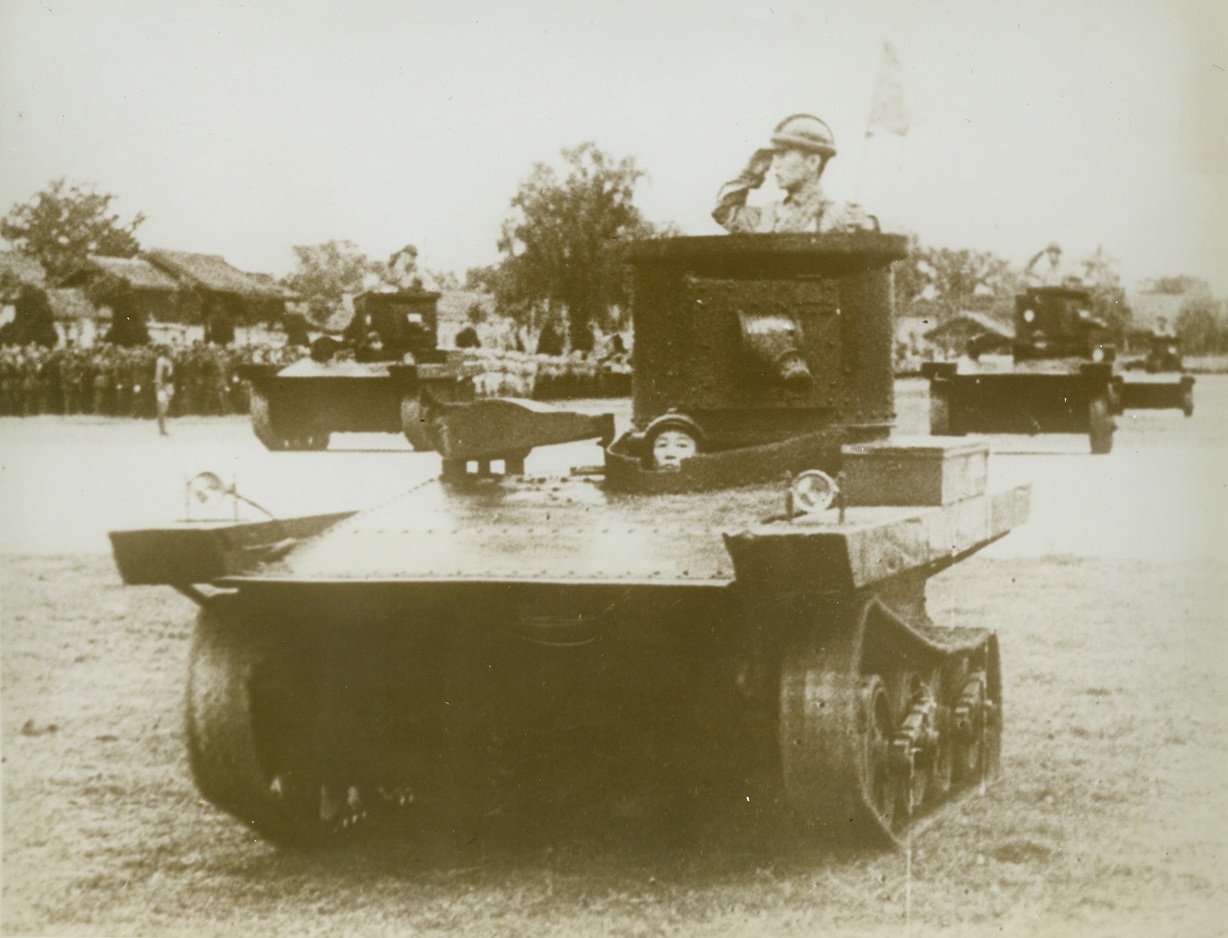
Chinese Tanks On Parade, 1/6/1943. CHANGTU, CHINA—Light Tanks of the Chinese Army pass in review in a parade held in Changtu. The parade was held in commemoration of the 31st anniversary of the Chinese Revolution and the birth of the Chinese Republic. Credit: ACME;
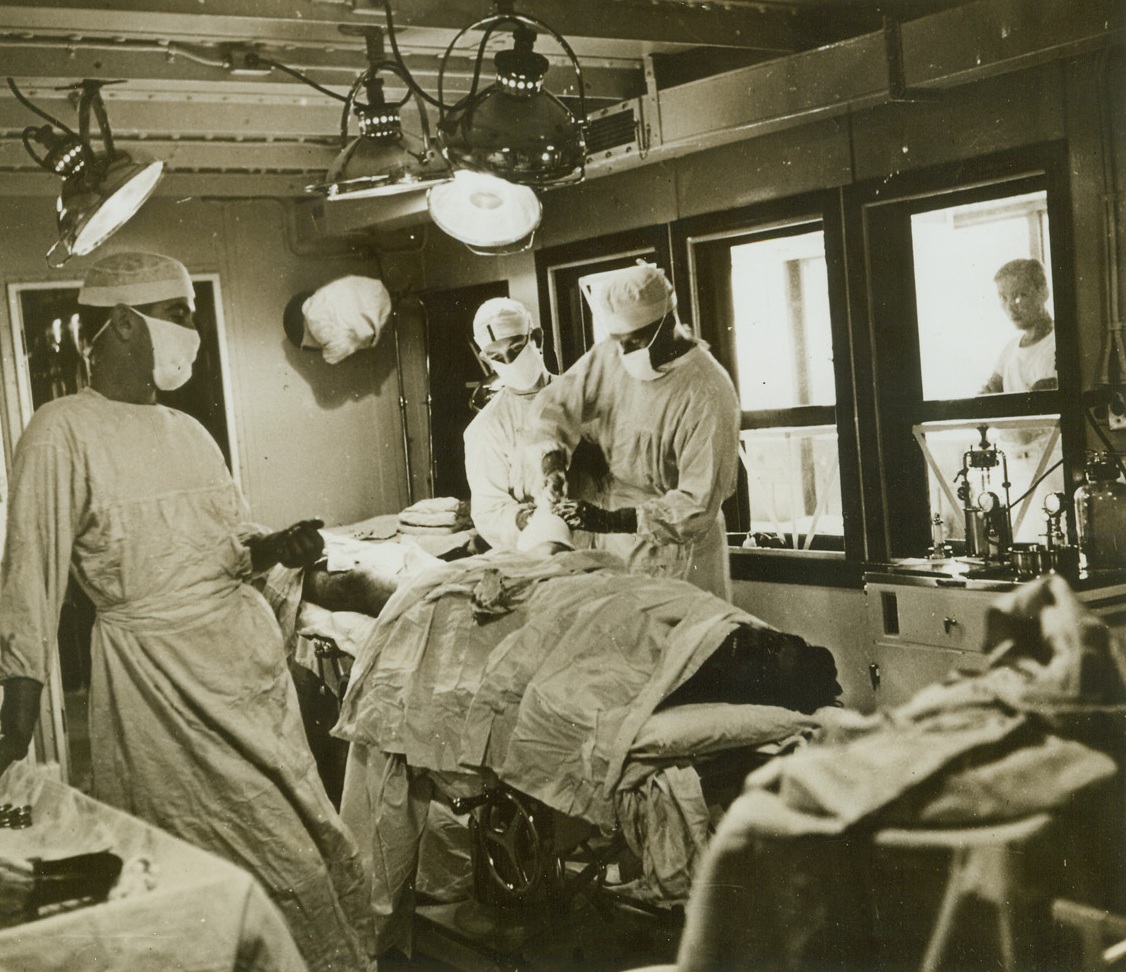
HAPPY PATIENT, 1/1/1943. ABOARD THE U.S.S. SOLACE—This patient doesn’t seem to mind it a bit as the doctor puts a cast on his fractured leg. Equipment aboard the Solace, navy hospital ship, is as complete as in any hospital in the U.S. It is a converted passenger liner that used to run from New York to Miami. Now it travels alone, unarmed, with no passengers, and only guns aboard are a few 45’s for internal protection. It is the only ship in the Navy painted white with a green band around the sides and a red cross on either side and on the smoke stack.Credit: Acme;

ATTACK ON AXIS CONVOY, 1/4/1943.

United Nations Convoy Reaches Malta, 1/12/1943. MALTA – A battery of arc lights illuminates the unloading by night of a British convoy at Malta. Ashore, the population of the battered island celebrate the landing of several months’ supplies. By winning back Libyan air bases, the British have been able to protect a series of convoys, some of which reached Malta unmolested. All arrived unscathed. Credit Line (Acme);
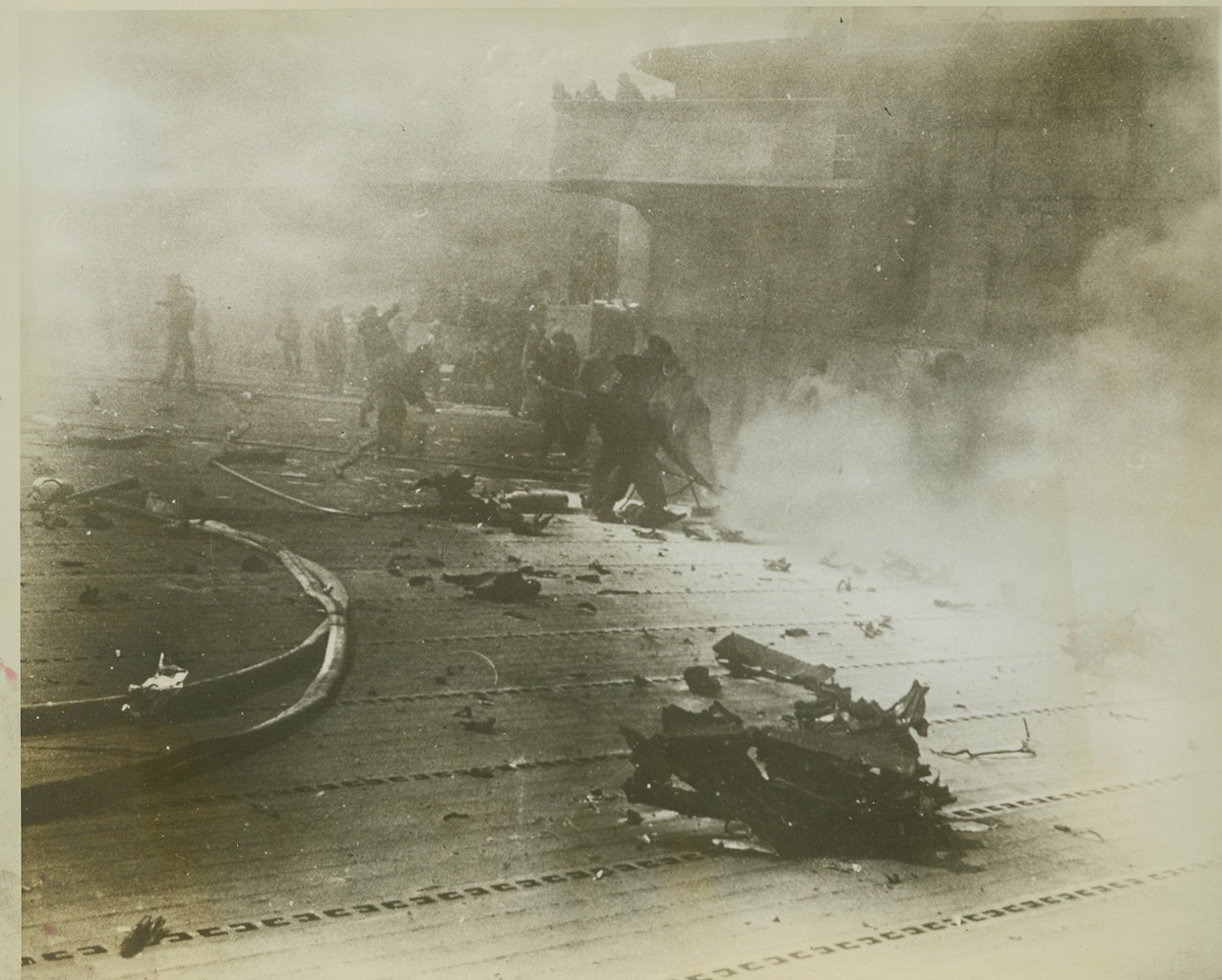
After Jap Plane Hit "Hornet's" Deck, 1/12/1943. Crew members of the U.S. aircraft carrier Hornet, battle desperately against long odds to put out a fire started when a Jap bomber suicide-dived into the warship's signal bridge, in this photo released by the Navy in Washington today. Wreckage from the bomber covers the ship's flight deck. Picture was taken during the battle of the Santa Cruz Islands, Oct. 26, 1942, when the carrier was so badly damaged it later had both sunk by other American warships. Credit: (U.S. Navy Photo from ACME);
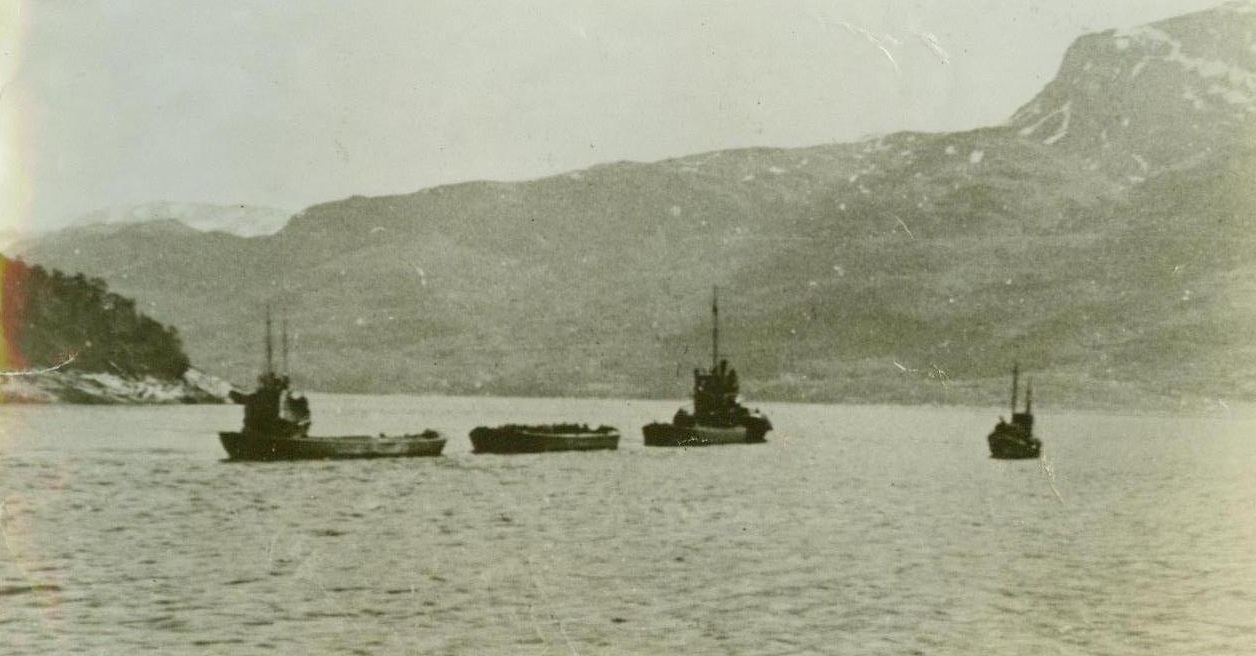
Nazi Mass Murder In Norway, 1/23/1943. In June 1942, 900 Serbian Prisoners of War arrived at Breisfjord in Ofoten. Many of them were suffering from Typhus, and they were shot by the SS-Guard. The prisoners were then moved in small barges to Treldal and from there to Jernmannet by the Osot-Railway not far from the Swedish border. There from two to three hundred were shot because they were suffering from Typhus. Photo shows- the arrival of the prisoners at Treldal. 1/23/43 Photo Norwegian Embassy From ACME;
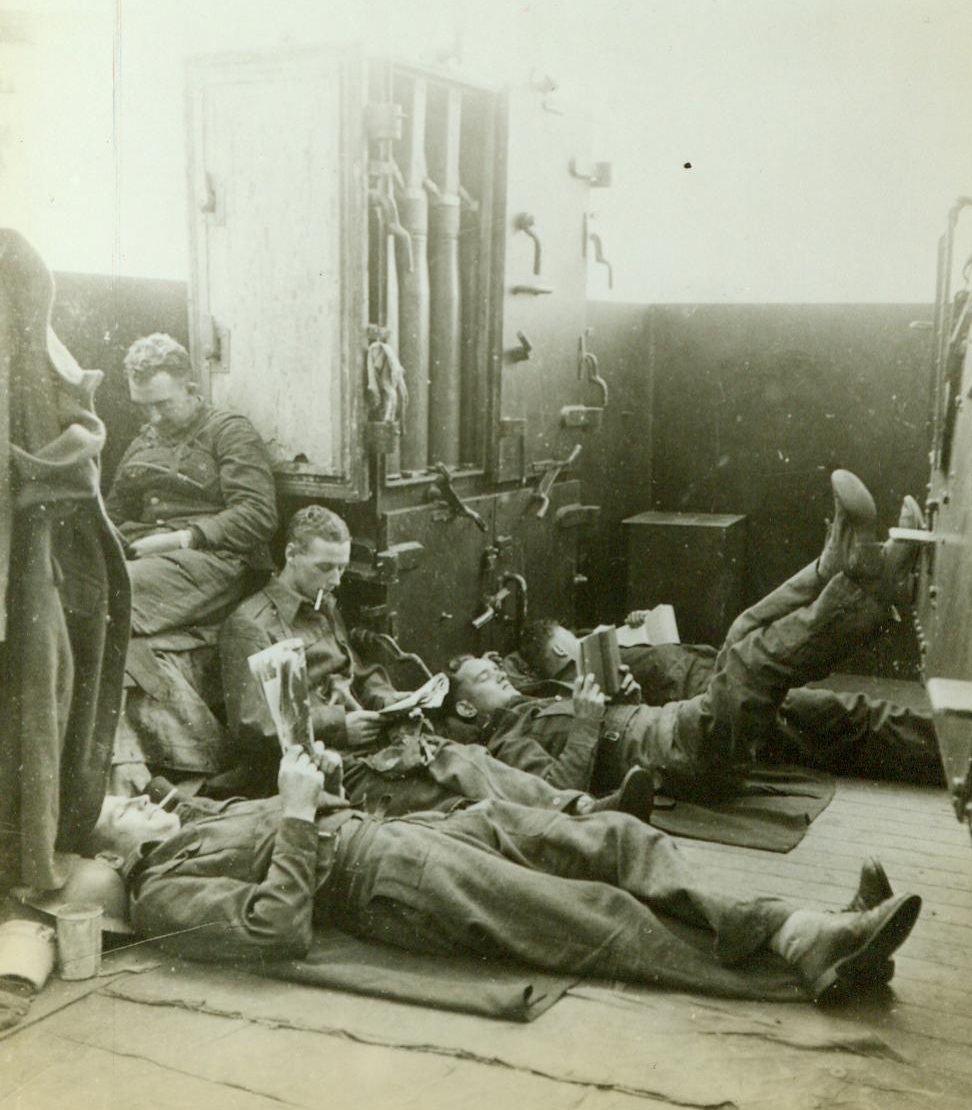
Taking It Easy, 1/17/1943. Aboard A British Cruiser – Men aboard a British cruiser that accompanied a United Nations convoy to Malta take time out for a bit of relaxation and reading during a lull in enemy activity 1/17/43 Credit Line (ACME); Aboard A British Cruiser – Men aboard a British cruiser that accompanied a United Nations convoy to Malta take time out for a bit of relaxation and reading during a lull in enemy activity 1/17/43 Credit Line (ACME);
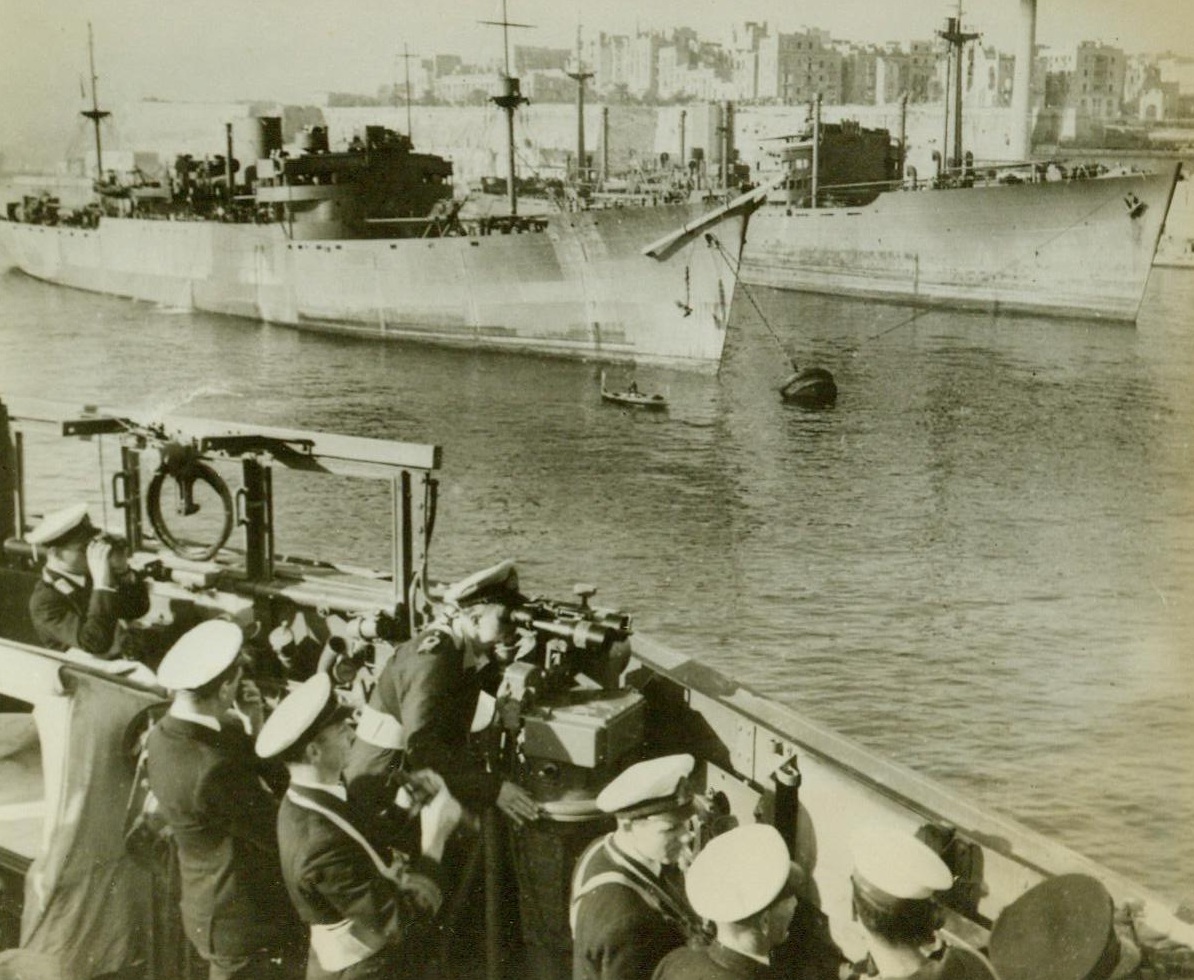
Convoy Reaches Malta, 1/17/1943. Aboard A Royal Navy Cruiser – The ships of a Malta- bound convoy anchor in the harbor as they reach their destination safely. Photo was made aboard a British Cruiser that accompanied the convoy. 1/17/43 Credit Line (ACME);
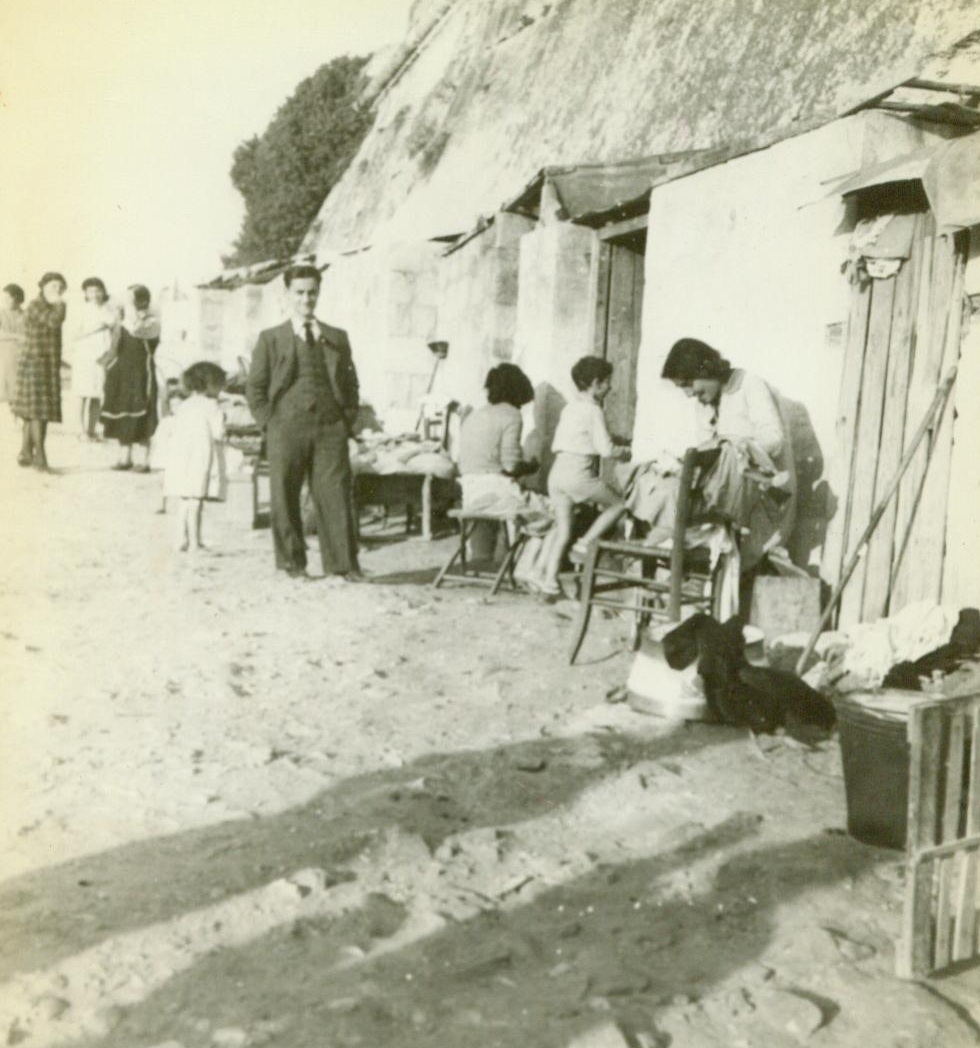
Happy Homes – And Safe, 1/18/1943. Malta – Although there is little left of Malta’s cities after innumerable bombings, but piles of rubble, the Maltese have retained their fine spirit. Here, in front of homes hewn out of the walls of an old fort, people of Malta go happily about their daily tasks in the warm sunshine. Several Maltese in background, seem amused at having their picture taken. 1/18/43 Credit Line (ACME);
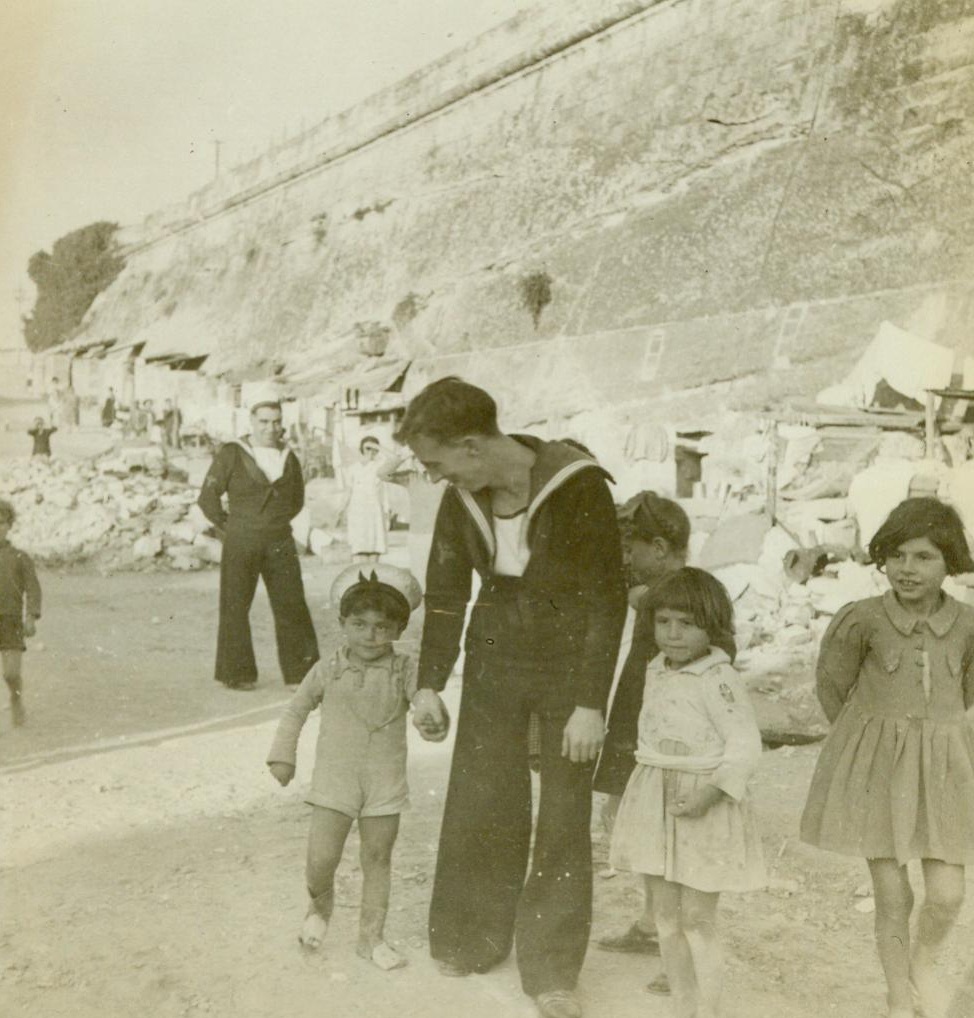
Malta’s Children Can Still Smile, 1/18/1943. Malta – In spite of the fact that the island of Malta has been bombed more than any other place on earth, its people still can smile. Here, Maltese children enjoy a few moments with British Sailors. In background, is an old fort where homes and tunnels have been hewn from the walls for use as shelters during air raids. 1/18/43 Credit Line (ACME);
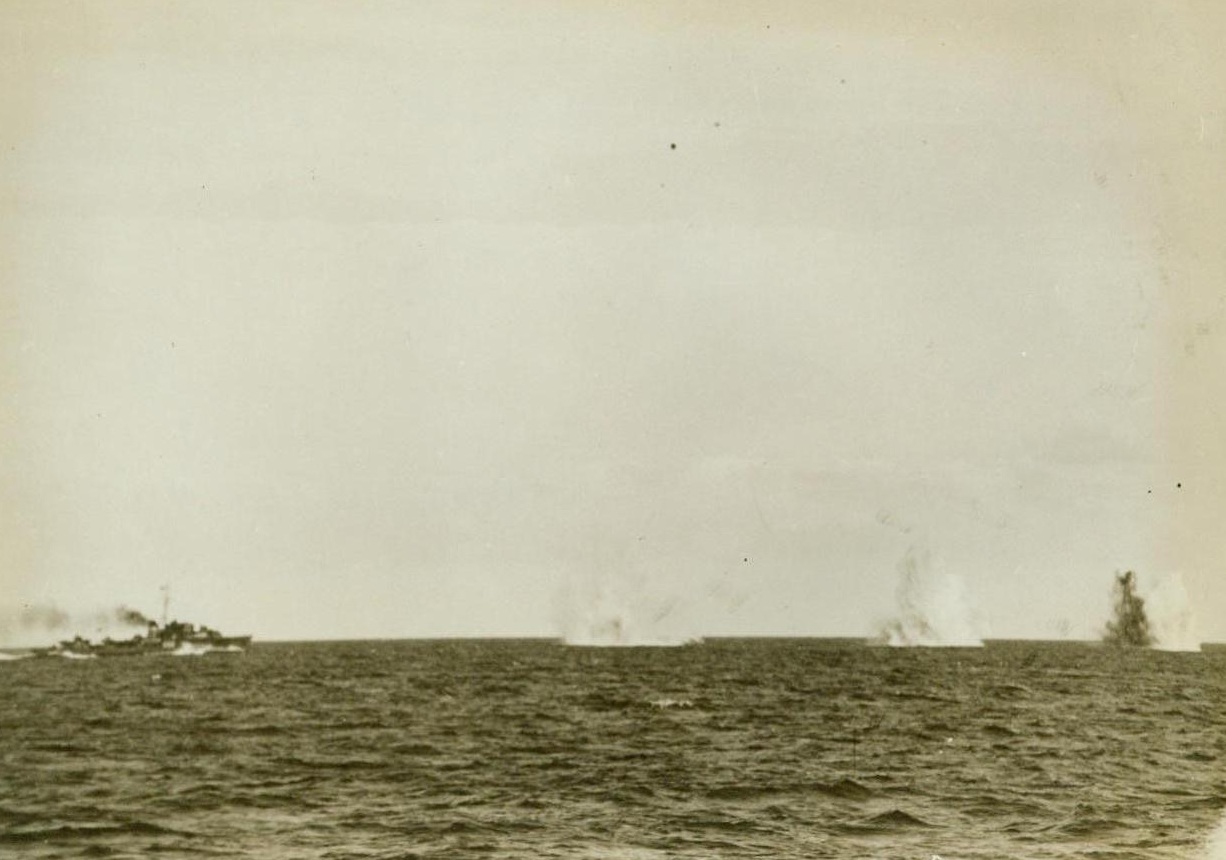
Triple Miss, 1/17/1943. Aboard A Royal Navy Cruiser – An Axis plane, attacking a convoy bound for Malta, misses its target three times, raising triple geysers as the “eggs” hit the water/The “misses” fell short of the destroyer at right of photo. Photo was made aboard a British cruiser that accompanied the convoy. 1/17/43 Credit Line (ACME);

LOOKOUTS, 1/26/1943. GUADALCANAL, S.I.—Lookouts on a hill overlooking Grassy Knoll, 4 miles west of Henderson Field, keep constant watch as the Army launches an offensive on Jap lines, entrenched along the hillside and in the forest below. Latest reports indicate that six important elevations were captured and 110 Japs were killed in the battle. Credit: Acme;
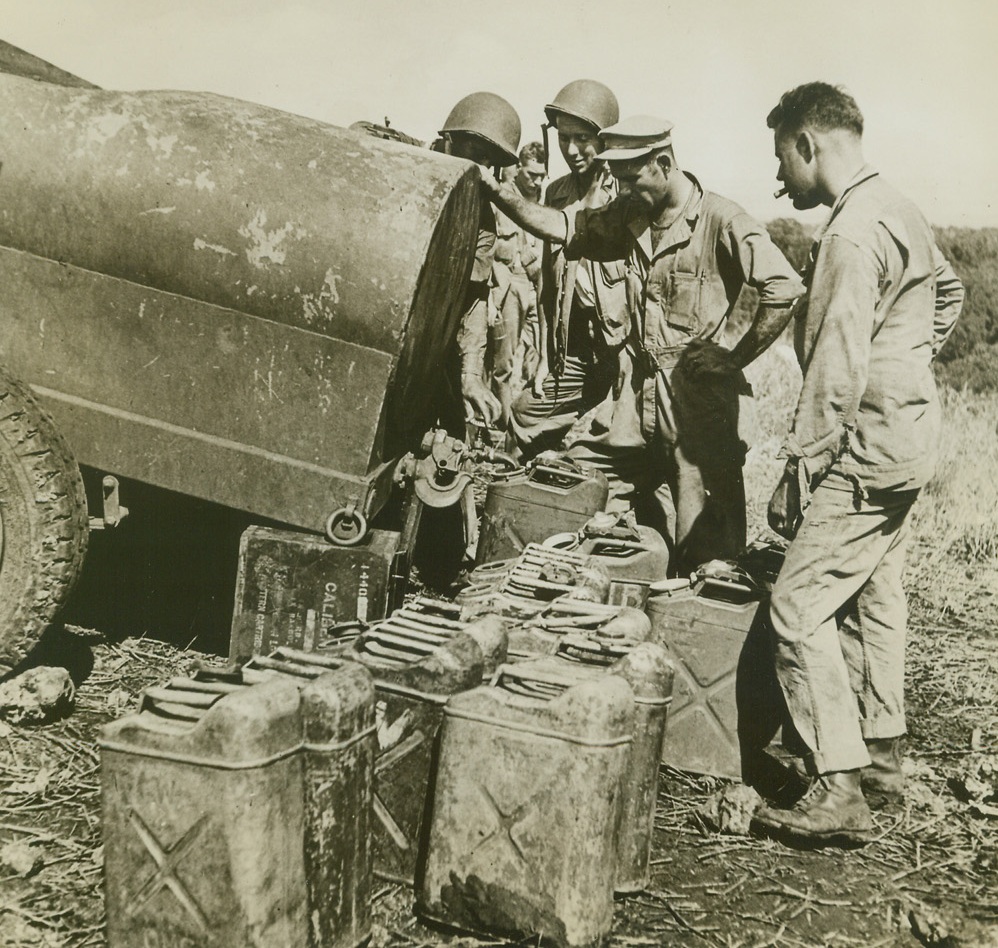
WATER FOR THIRSTY U.S. FIGHTERS, 1/26/1943. GUADALCANAL—Five gallon cans are filled with water at this last outpost—the end of the jeep trail on Guadalcanal. The cans are then carried forward to combat areas, where U.S. ground forces are battling the Japs. Today, American troops wiped out 293 more Nips and consolidated their position at Kokumbona. Credit: Acme;
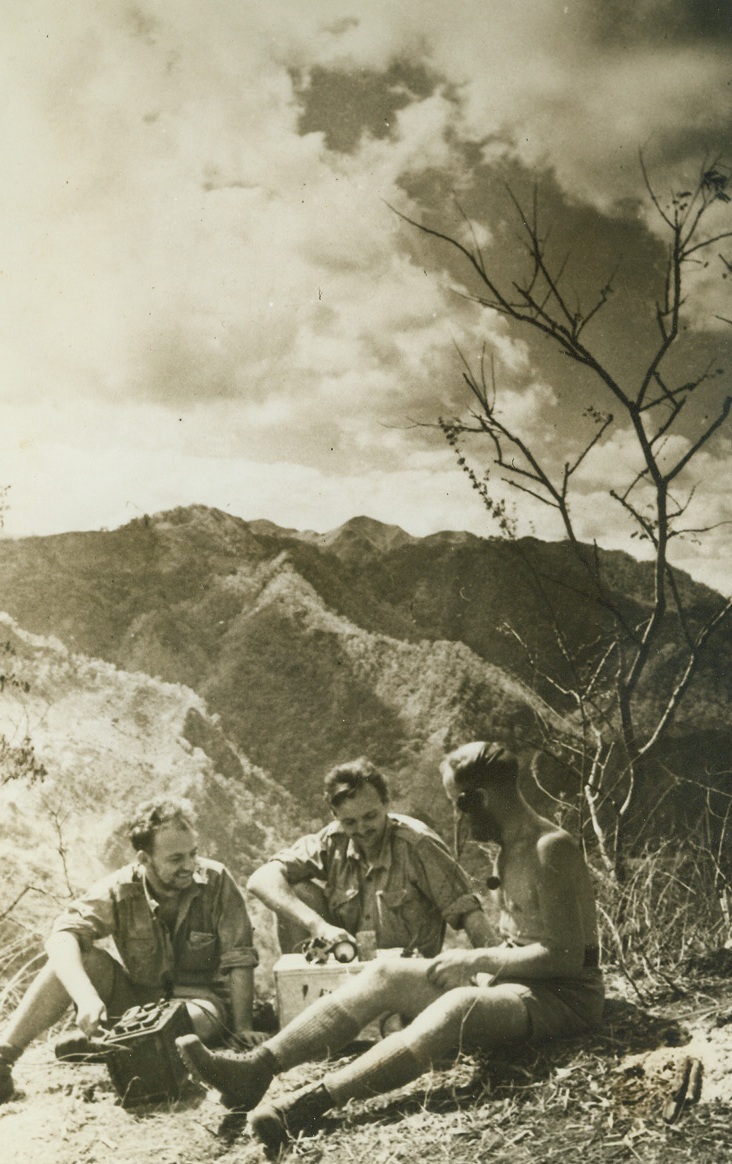
BRAVERY AMAZES HOMELAND, 1/25/1943. TIMOR ISLAND—Three Aussie signal corps men gather ‘round the set they constructed on the Jap-held island of Timor. To show that they were working in the camp of the enemy as guerilla fighters they sent a message to the mainland. Their superiors sent back the message, “What is the Christian name of Jack Sargent’s wife?” The trio of snipers returned the correct answer: “Kathleen” and the contact was established. Credit: Acme;
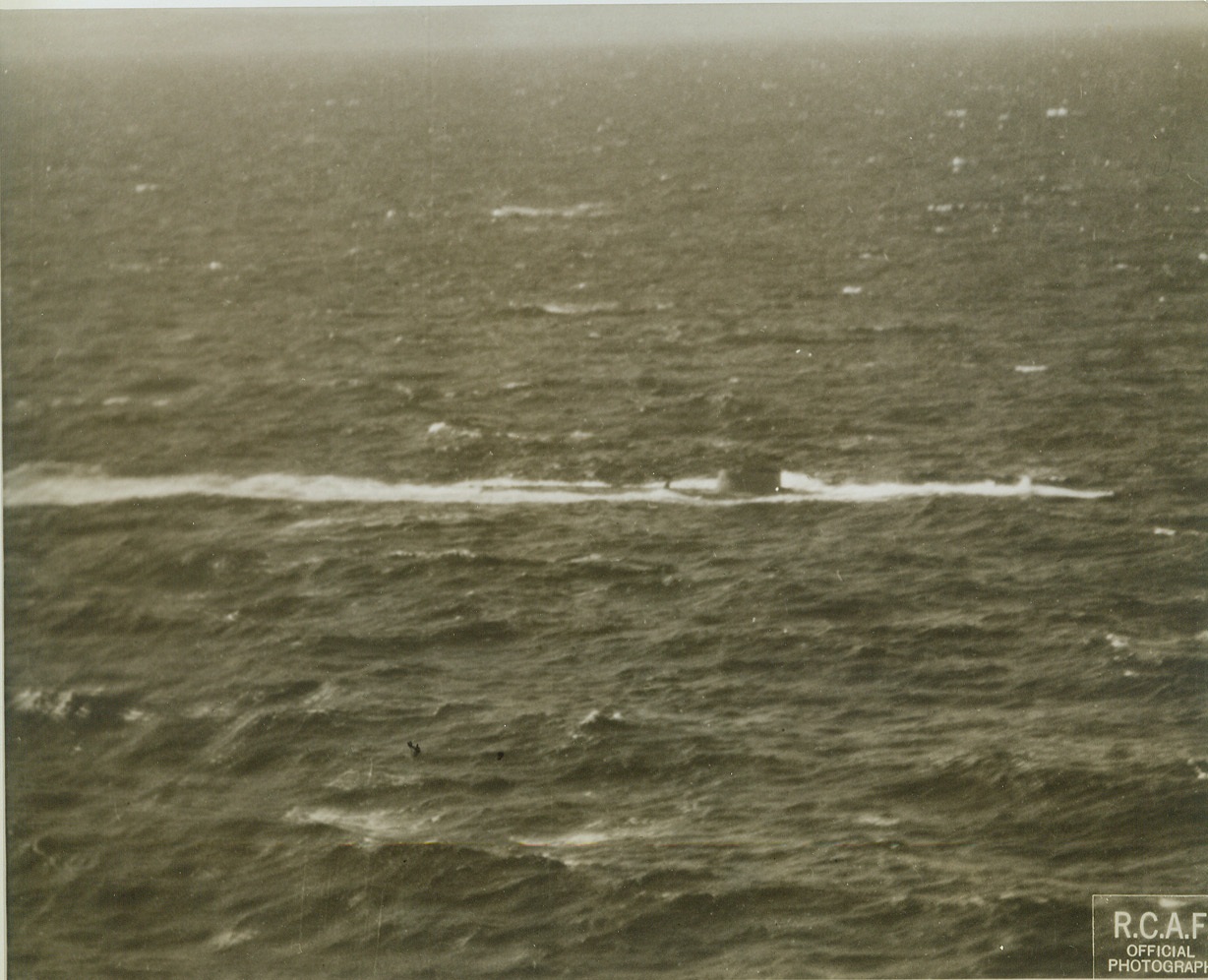
U-Boat Ducks, 1/7/1943. SOMEWHERE IN THE ATLANTIC -- The conning tower and a section of the afterdeck of a Nazi sub can be seen as the U-boat ducks to avoid an attack by an RCAF Atlantic coastal patrol bomber. A few moments later, bullets rattled on its hull and depth charges from the plane churned the water all around it. Credit: (ACME);

Off to Meet the Japs, 1/10/1943. Port Moresby, New Guinea – A new fighter group with their speedy P-38s is now on the job at Port Moresby. Here four of the planes, of the type which recently knocked out 77 Jap fighters in the convoy battle off Lae, speed out to smash the enemy. (Passed by Army Censor).Credit: ACME;
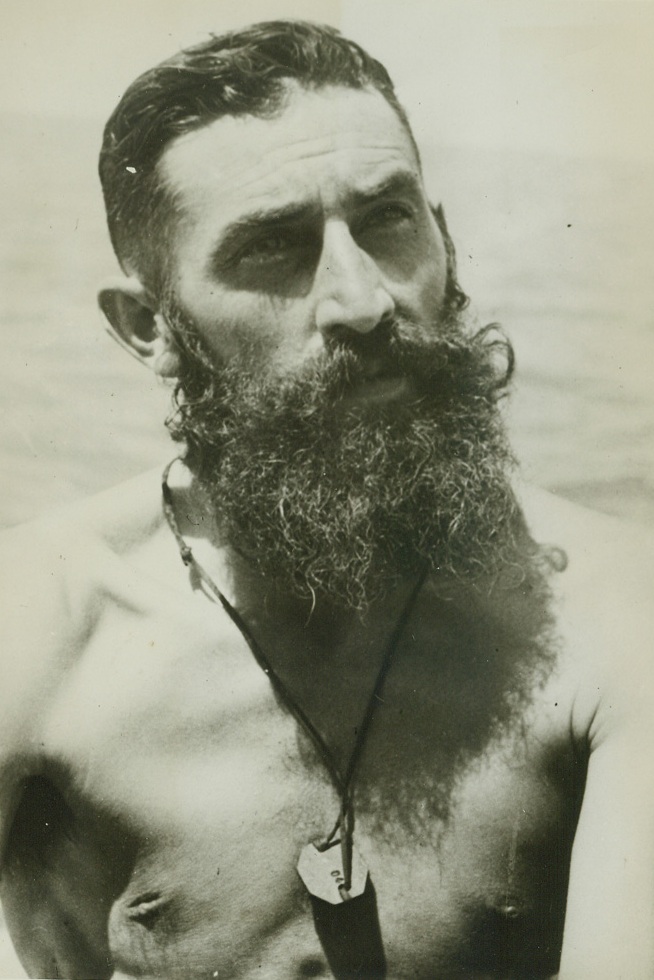
Aussie Sniper Wears Natural Camouflage, 1/25/1943. Timor Island – Corp. J. Haire, Perth, Australia, lives up to his last name as he hides behind a bushy beard when he goes sniping against the Japs on Timor Island. He is one of a small force of Guerilla fighters who have managed to entrench themselves virtually in the camp of the enemy.Credit Line (ACME);
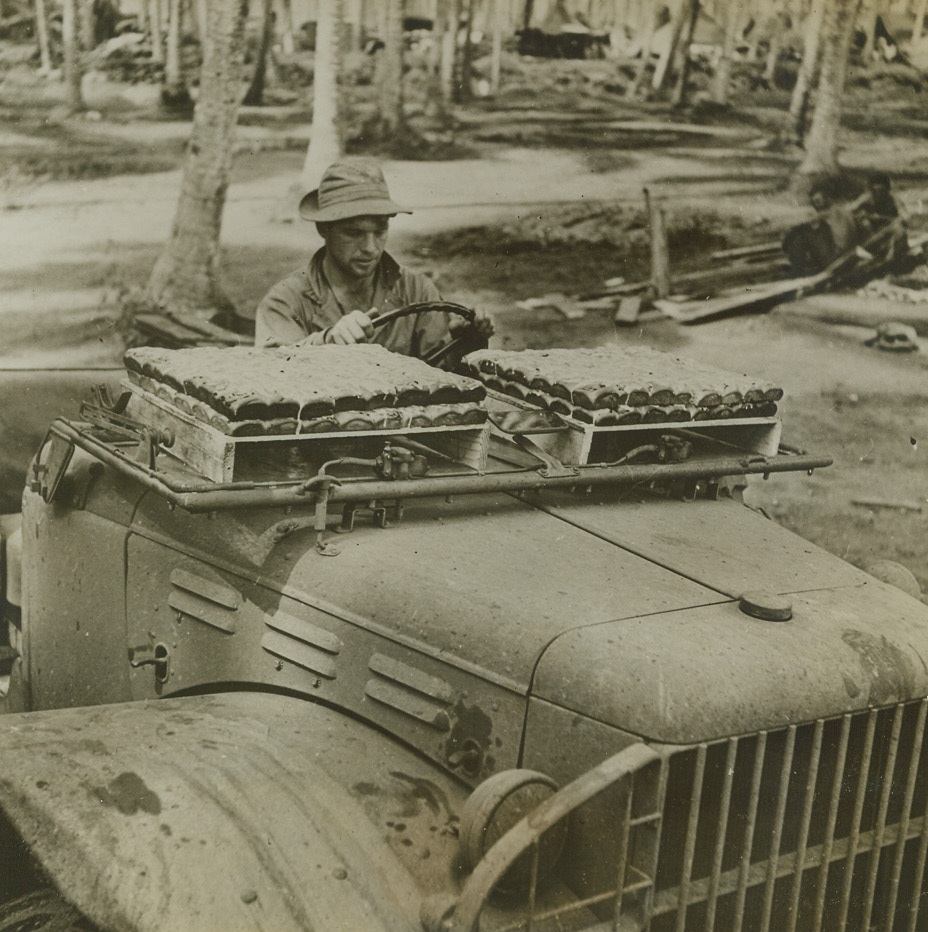
Guadalcanal Baker Boy, 1/29/1943. Guadalcanal - - Sweet rolls stacked on the windshield of this U.S. Army truck, are rushed from the bakery to hungry American fighters on Guadalcanal. Today, U.S. ground forces on the island consolidated their position at Kokumbona, killing 293 more Japs.Credit Line (ACME);
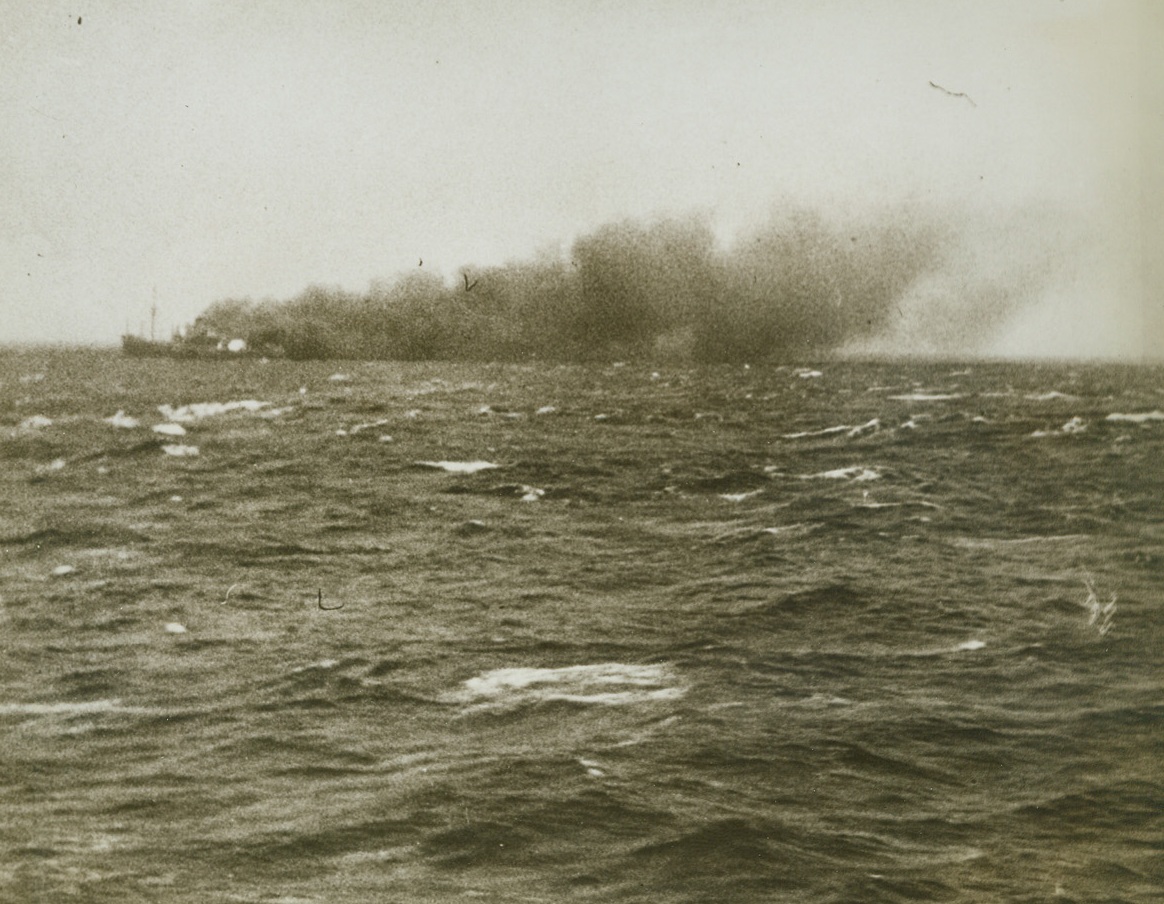
Nazi Ship Burns and Sinks, 1/17/1943. Bay of Biscay – A German blockade runner slowly sinks in the waters of the Bay of Biscay, leaving a trail of black smoke from her burning deck behind her, after being shelled by the H.M.S. Scylla. Heavily laden with raw materials for Germany, the blockade runner was first sighted by a Wellington of the R.A.F. Coastal command, which attacked, unsuccessfully, in bad weather. A Sunderland was then sent to guide the Scylla to the Nazi vessel, and the British ship sent her to the bottom as she neared the last lap of her journey.Credit Line (ACME);
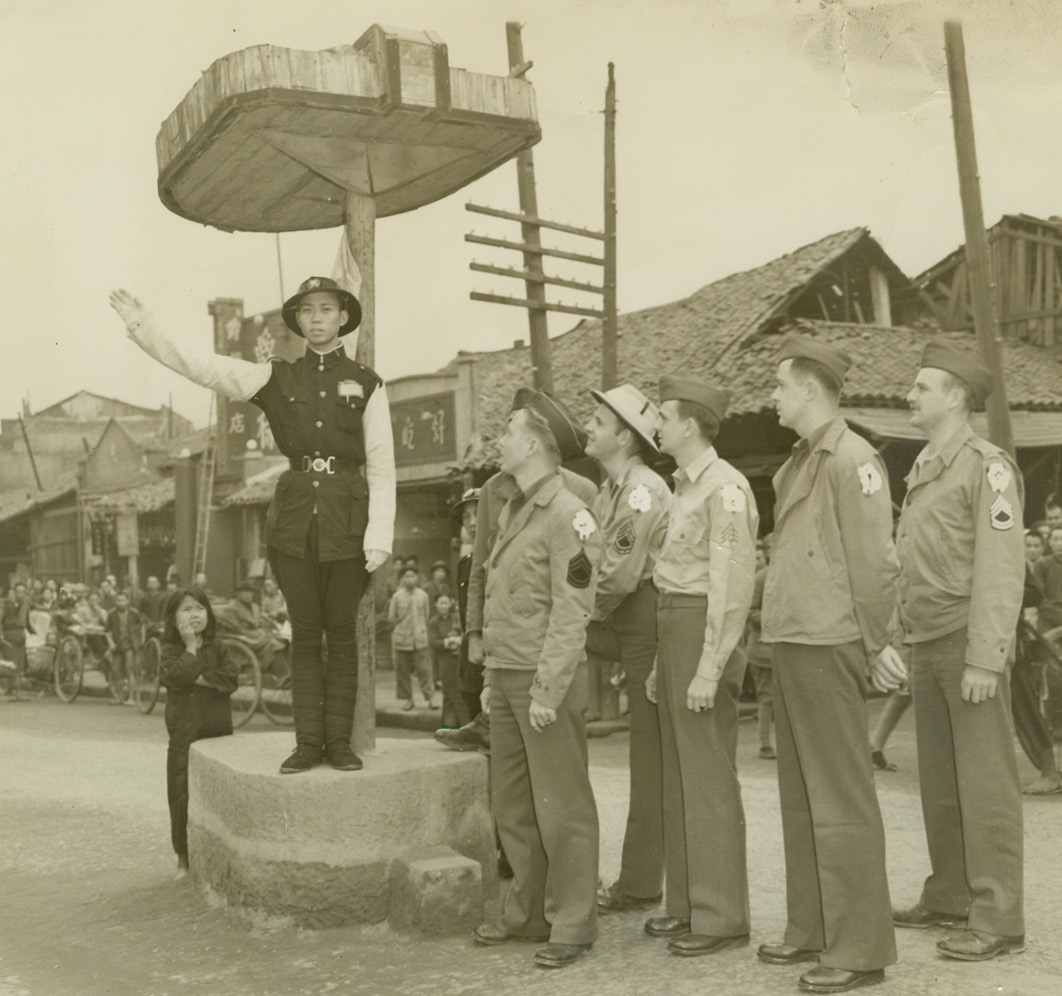
The Traffic is Terrific, 1/12/1943. Somewhere in China – American soldiers admire the efficiency and neat dress of a Chinese policeman who directs traffic at a “busy” intersection. Soldiers (left to right) are: Sgt. Ivan O. Stanberry, Pomona, Calif.; Claude J. Smith, N.C.; Sgt. Robert Wigglesworth, Wisc.; Sgt. Andrew Chemsakm PA.; and Sgt. Charles M. Janes, Calif. The little Chinese lady is as fascinated as the Americans. Credit: ACME;

Close Shave, 1/13/1943. New Guinea: Lt. Harold Evans, of Robersonville, N. Car., keeps his bayonet razor sharp, so Lt. Henry Gibbs, of Morehead City, N. Car., felt just like he was getting a shave from a home-town barber. Both boys are seeing plenty of action on the Buna Front. (Passed by Censor) Credit: ACME;
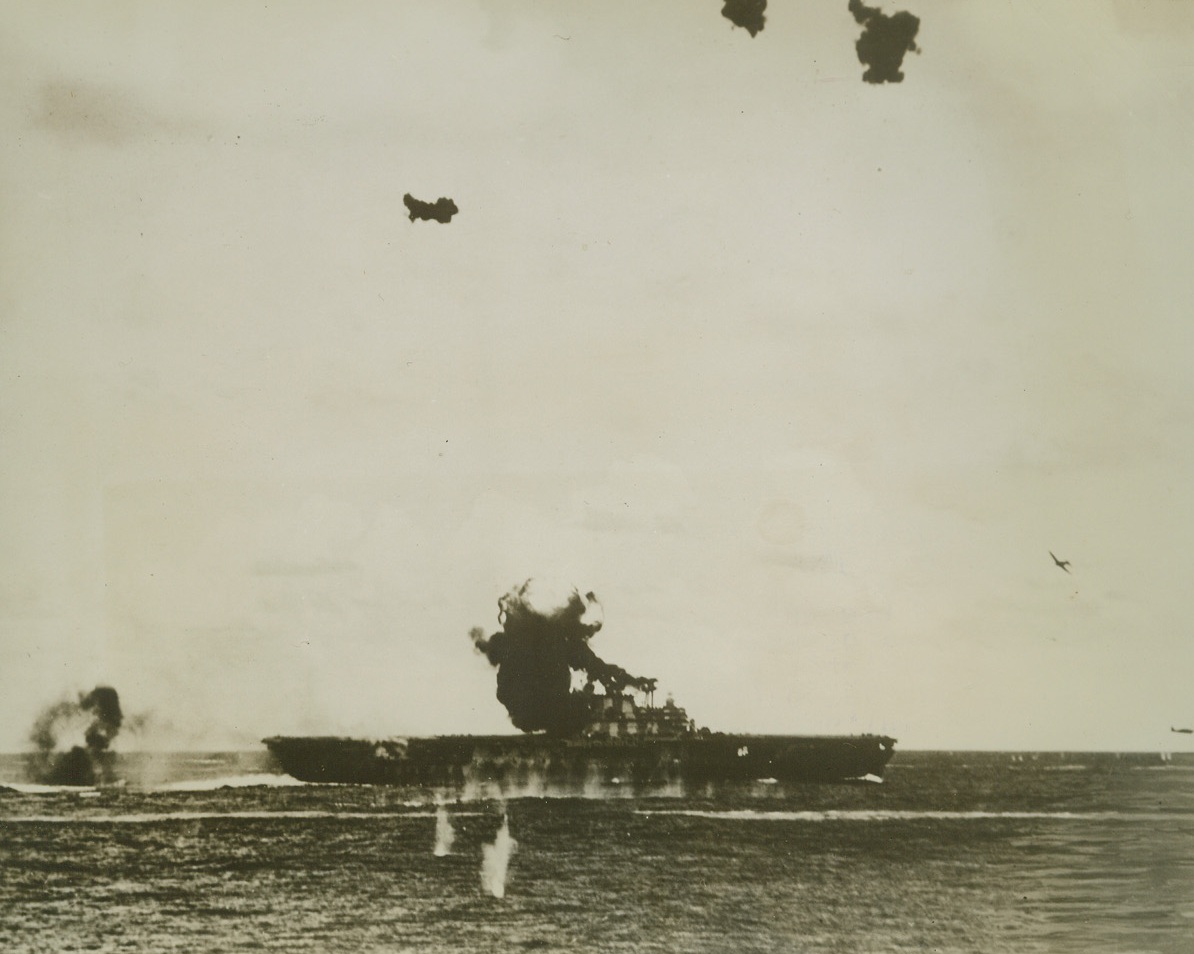
Jap Suicide Dive Catches “Hornet”, 1/12/1943. A huge ball of flame and smoke rises from the spot on the signal bridge of the U.S. Aircraft Carrier Hornet where a Jap bomber crashed after a suicide dive, in this photo released by the Navy Department in Washington today. Note other Nip Torpedo and Dive Bombers circling, (right, in photo). Action took place during the battle of the Santa Cruz Islands, Oct. 26, 1942, in which the carrier was so badly damaged that it was abandoned and the vessel sunk by other American warships. Credit: U.S. Navy photo from ACME;

Smoke Marks the Spot, 1/14/1943. Smoke and flames mark the spot where three Japanese torpedo bombers, shot down by anti aircraft fire from American warships off Guadalcanal, last Nov. 12th, crashed to a watery grave. The U.S. destroyer, (to right of smoke columns), helped beat off the Nip torpedo and dive bomber attack. This phto was released by the Navy in Washington Today. Credit line (U.S. Navy photo from ACME);
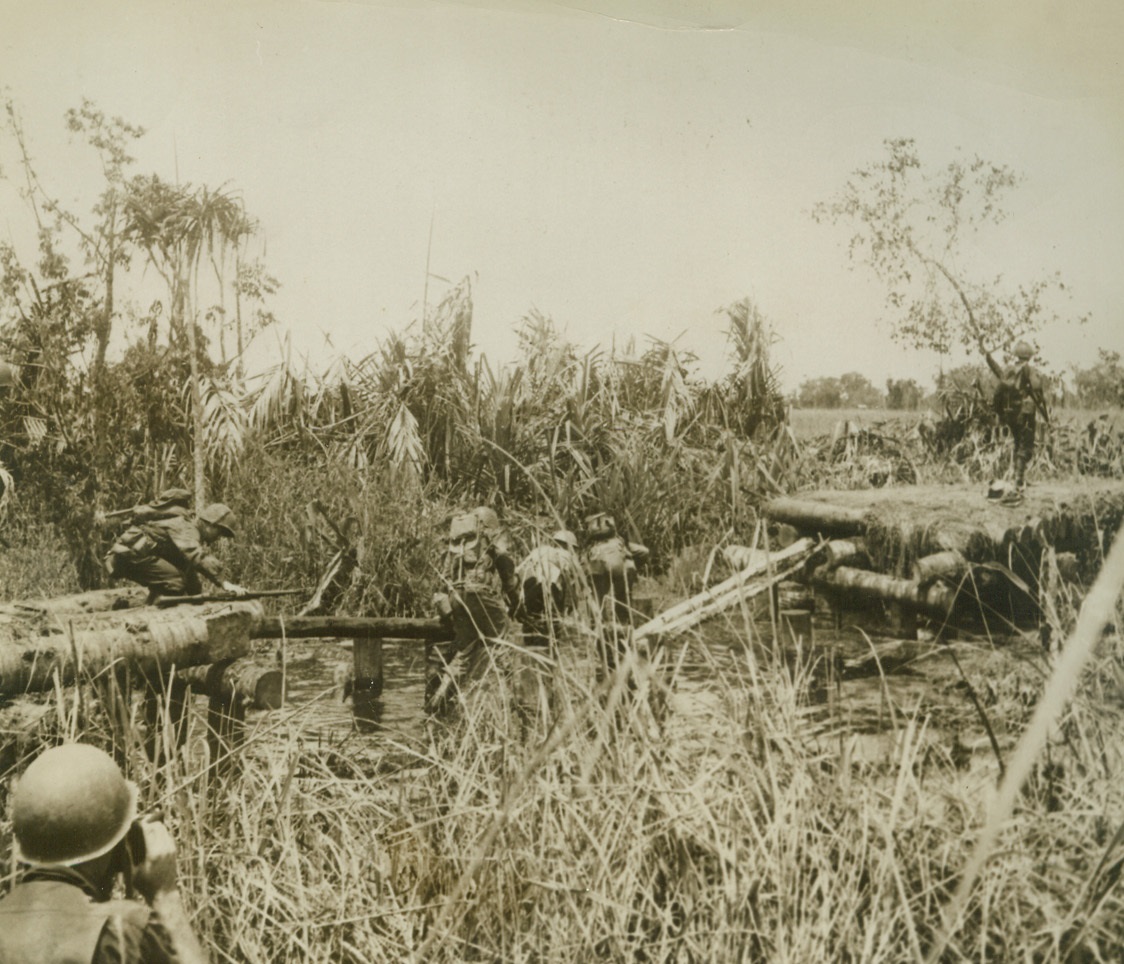
Yanks Move Forward, 1/13/1943. New Guinea: - Just ten minutes before this picture was taken, Japanese forces covered this wooden bridge over Simemi creek with baking machine gun and artillery fire from the right bank. The attack by the American forces pushed the Japs back, and here you see the Yanks scrambling across the remains of the bridge. It was one phase of the attack to take Simemi creek on the Buna front. Credit line (ACME);

Deadly Flowers, 1/14/1943. Looking like flowers blooming in a garden a cluster of bomb explosions bracket a Jap cargo ship, (center of photo), during a heavy attack by U.S. Army flying fortresses in the Buin sector near the Southeast tip of Bougainville island, in the Solomons last Nov. 18th. Another cargo vessel, (top left), frantically swings out of the target area, while other Nip ships, (lower right and left) are “cold turkey” for the U.S. Airmen. This photo, taken by a U.S. Navy cameraman, was released in Washington today. Credit line (U.S. Navy photo from ACME);
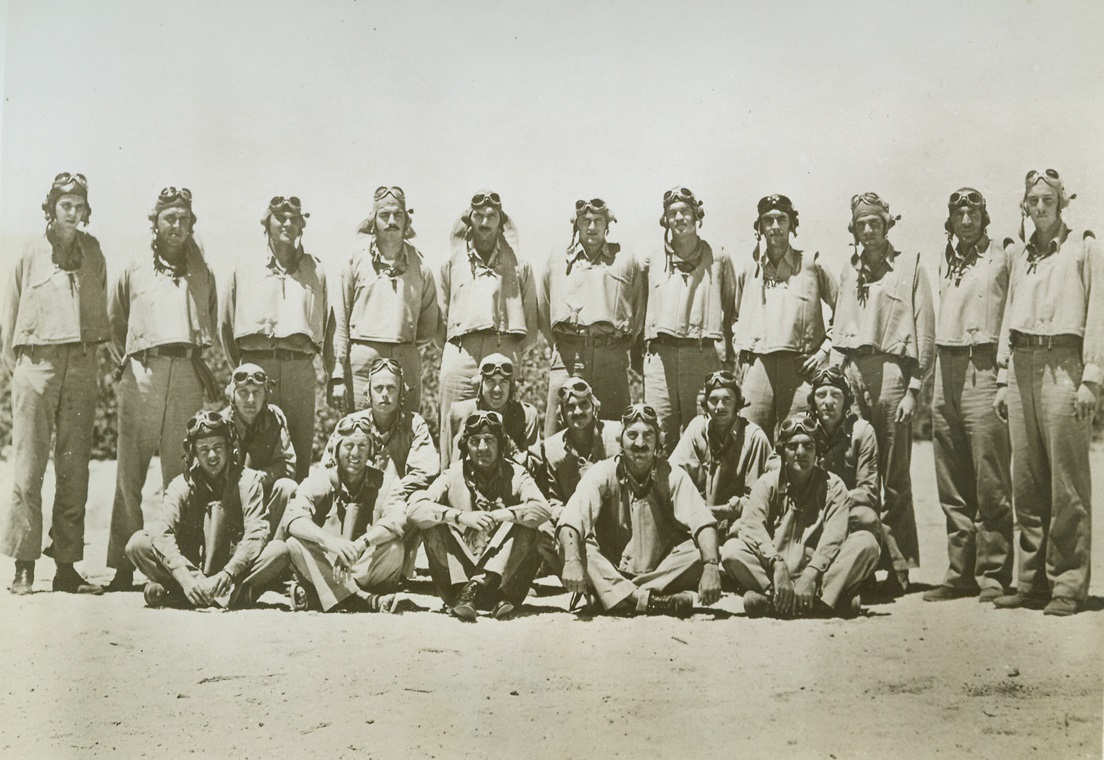
They Served Their Country, 1/10/1943. Midway Island – Gathered on the sands of Midway, shortly before the battle that ended in a great American victory last June 4-6, are these pilots of Marine Scout Bombing Squadron 241, part of Marine aircraft group 22. All but two of the men shown here participated in the engagement, and were the first to hit the Jap carriers. The squadron paid heavily in casualties, and many of its members are listed as “missing in action” and presumed lost. All of the pilots and aerial gunners of squadron 241 have been decorated for their heroic achievements in the battle of Miday. (Note: (M) indicates missin, and (w) indicates wounded) left to right: (first row) Second Lt. Albert W. Tweedy (M); Captain Bruce Proesser; Major Lofton R. Henderson (M); Major Leo Smith (did not participate); Captain Elmer Glidden, Jr. (Second row) Second Lt. Thomas J. Gratzek (M): Second Lt. R.W. Vaupell (W); First Lt. Daniel Iverson, Jr. (W); Second Lt. Jesse D. Hollow, Jr.; Second Lt. Howard G. Schlendering (W); Tech, Sgt. Clyde Stamps; (rear row) Second Lt. M. A. Ward (m) Captain R.L. Blaine (W): Second Lt. S.H. Whitten; Second Lt. T.F. Moore, Jr. (w); Captain A.H. De Laeio (w); Second L. Bruce H. Ek (M); Captain L.M. Williamson; Second Lt Bear; Marine gunner Howard Fraser; and Second Lt. Bruno P. Hagedorn (m). Last man in rear row is unidentified. Credit Line (U.S. Marine Corps photo from ACME);
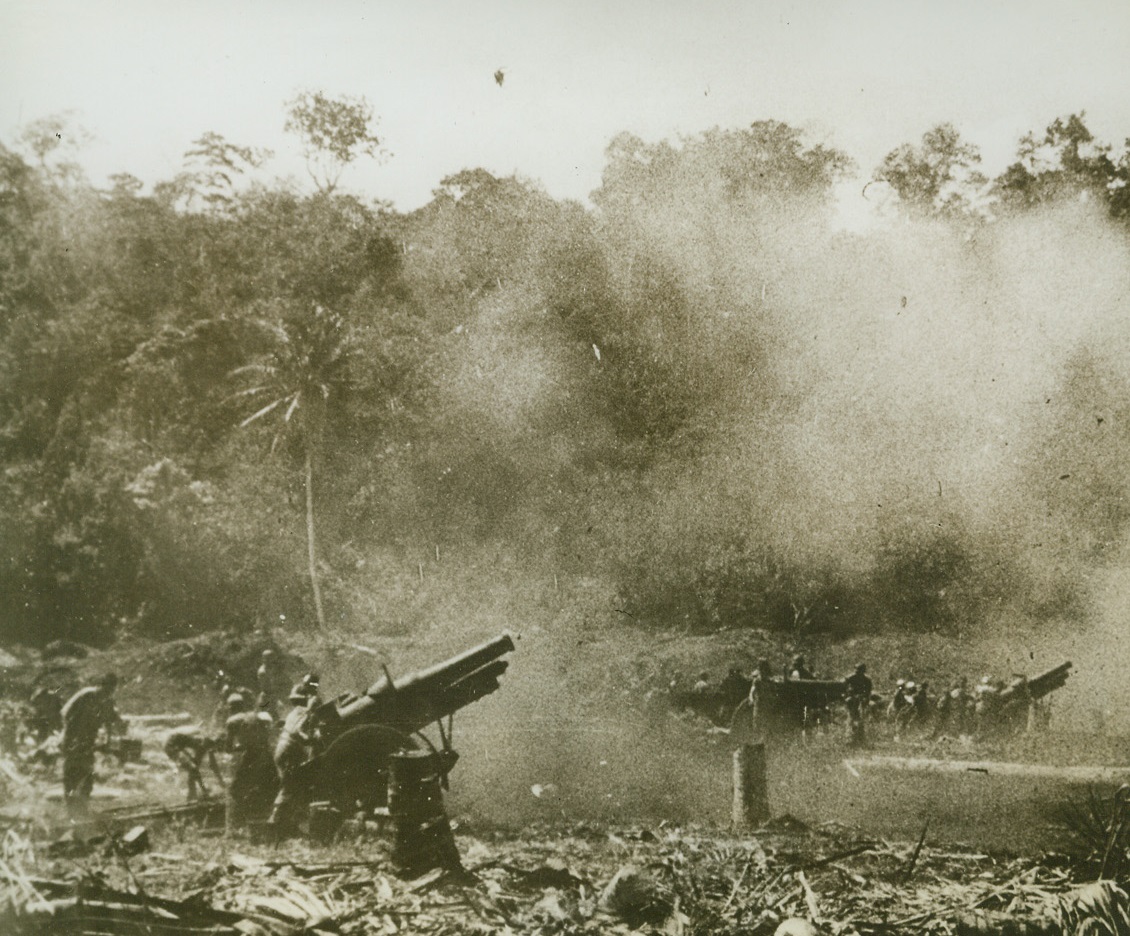
Artillery in Action on Guadalcanal, 1/19/1943. Guadalcanal: - 155 mm howitzers pour shells on enemy lines from advanced positions in Guadalcanal, where U.S. Marines are leading the attack on Jap forces. Latest reports state U.S. ground forces on the island continue to mop up pockets of enemy resistance. This photo is from a Marine Corps’ newsreel. Credit (U.S. Marine Corps newsreel photo – ACME);
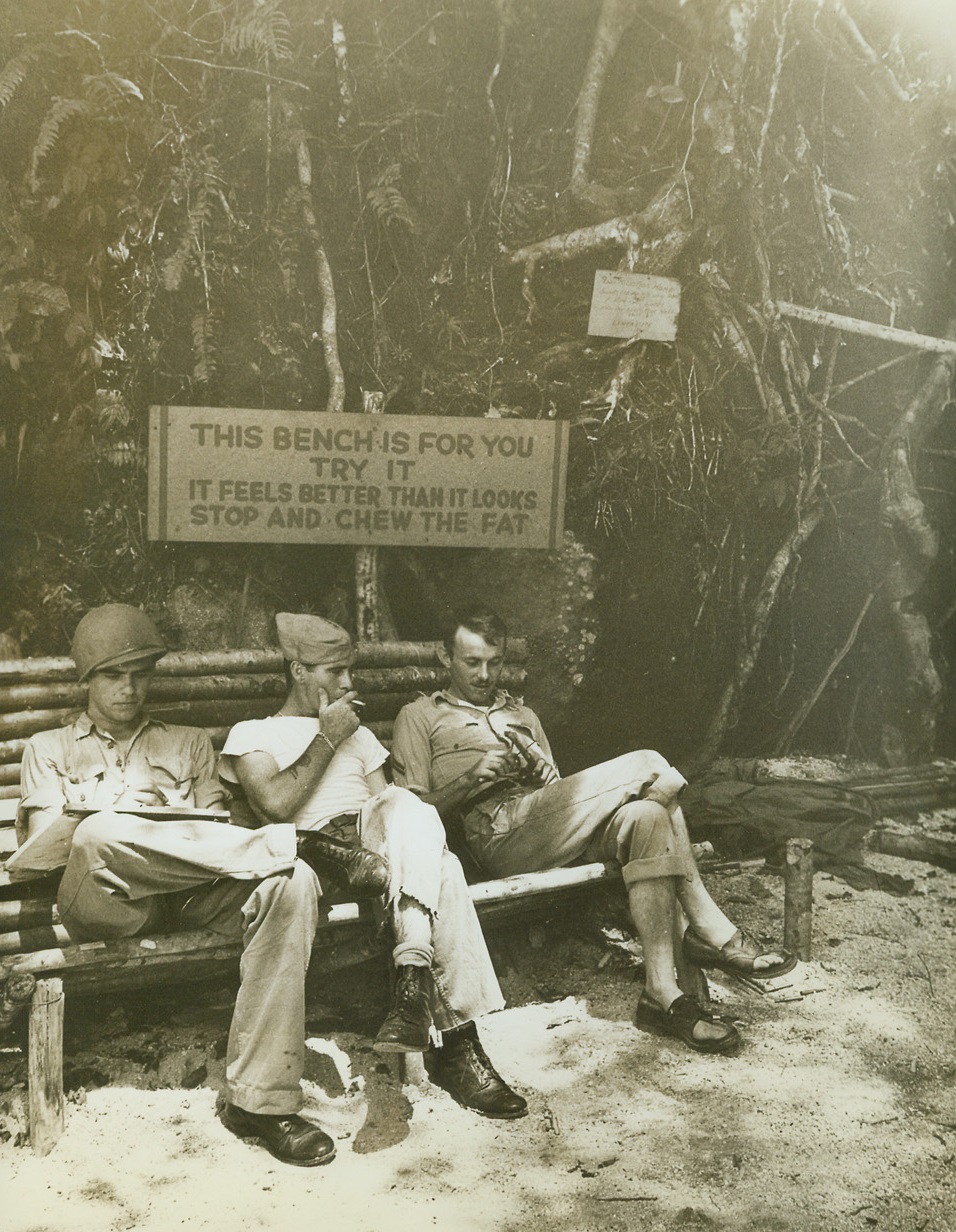
Bench and Sales Talk, 1/16/1943. Guadalcanal – These three Leathernecks were convinced by the sales talk tacked above the bench on Guadalcanal. One writes a letter home, another just smokes, and the third whittles – in a pain of comfortable air-conditioned shoes. They’re all enjoying a brief moment of relaxation in the tough tropical fighting zone. Credit line (US Marines Corps);
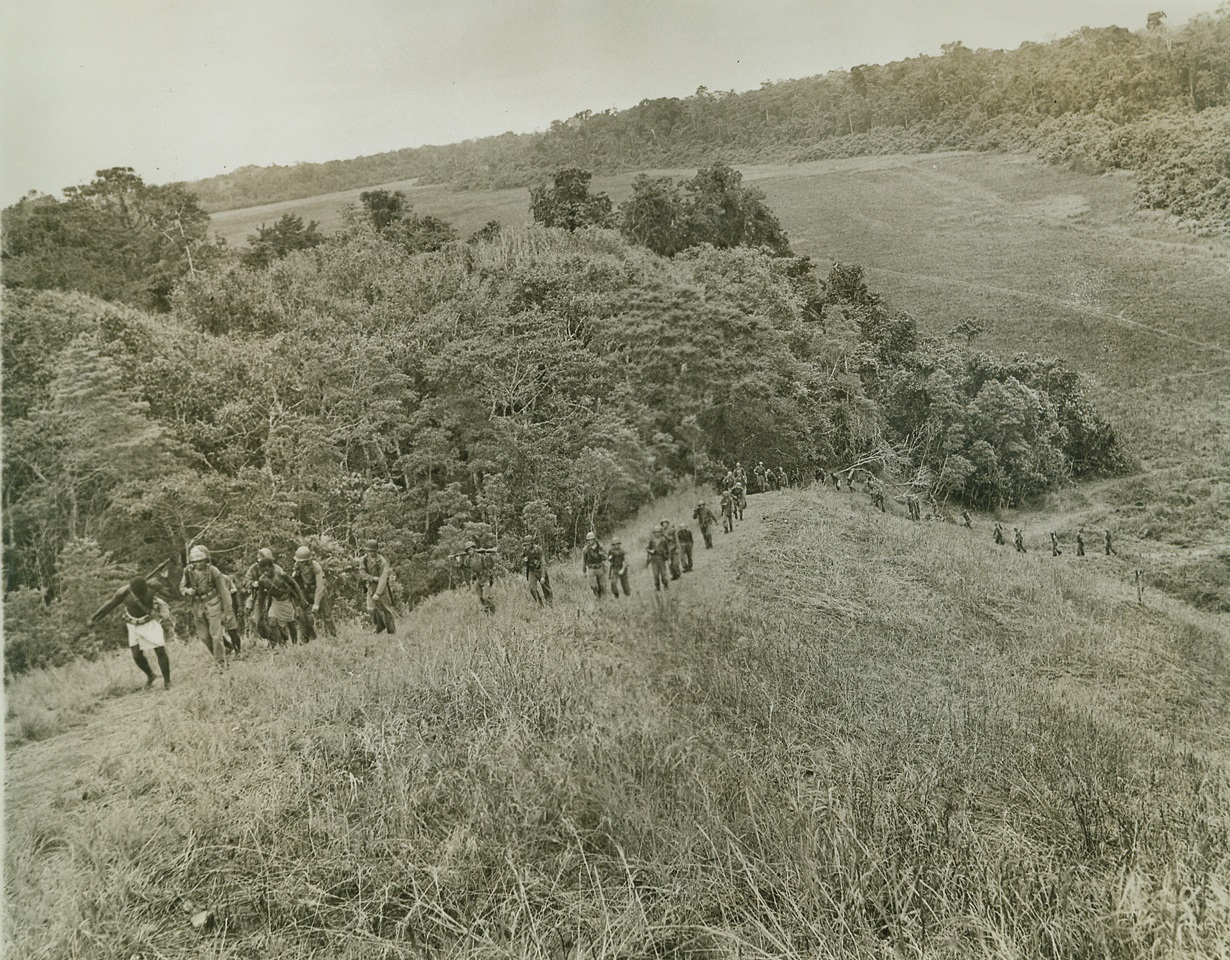
Safari on Guadalcanal, 1/16/1943. Guadalcanal – A Marine raider battalion – a specially trained group – marches over the rugged terrain of Guadalcanal. They found the natives eager to help carry supplies and equipment. One of the natives is serving as a guide. Credit (US Marine Corps photo from ACME);
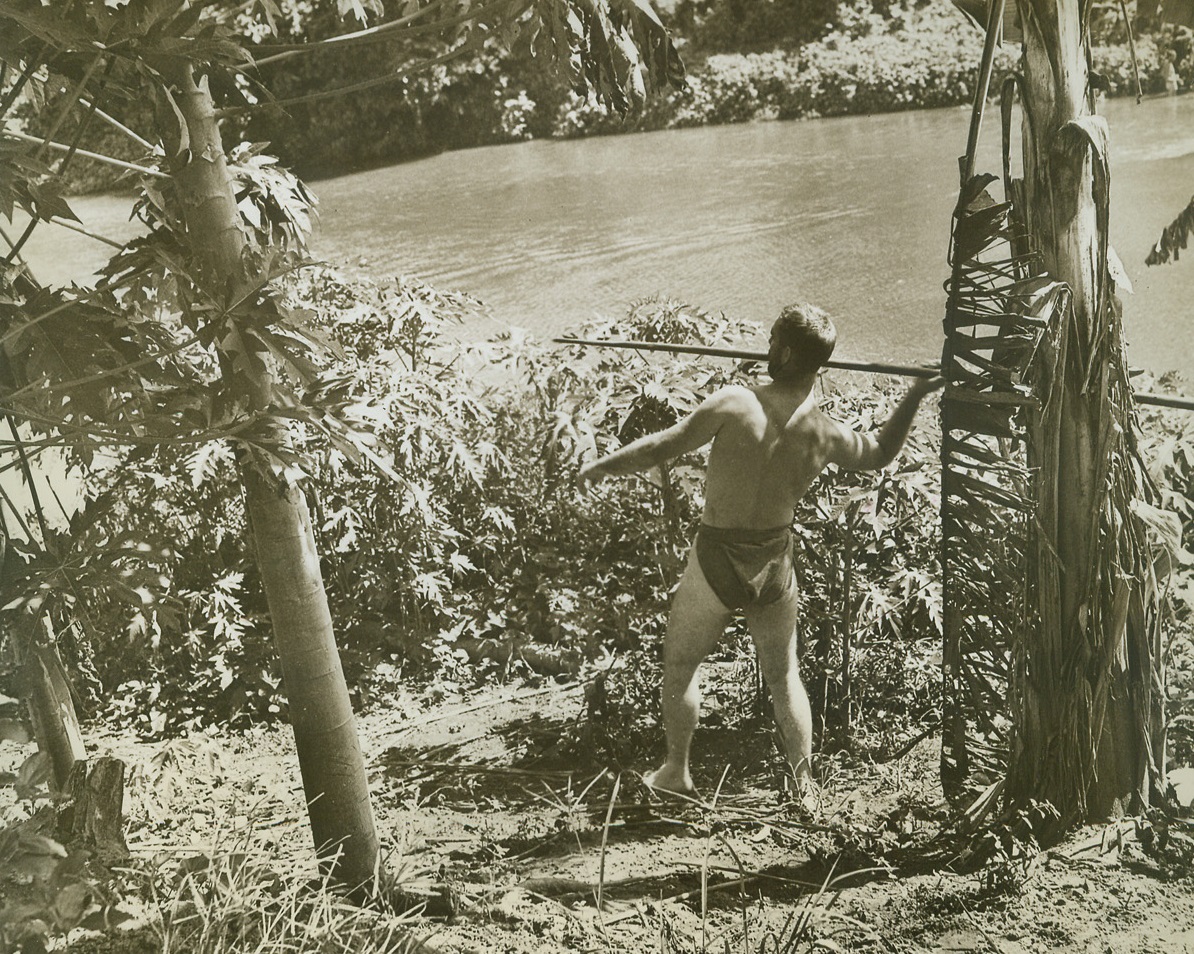
Pardon His Abbreviated Sarong, 1/16/1943. Guadalcanal – Taking advantage of a lull on Guadalcanal, this U.S. Marine went in for a bit of native style fishing. He donned native dress and tried his luck at bagging tropical fish with a spear. Credit (US Marine Corps photo from ACME);
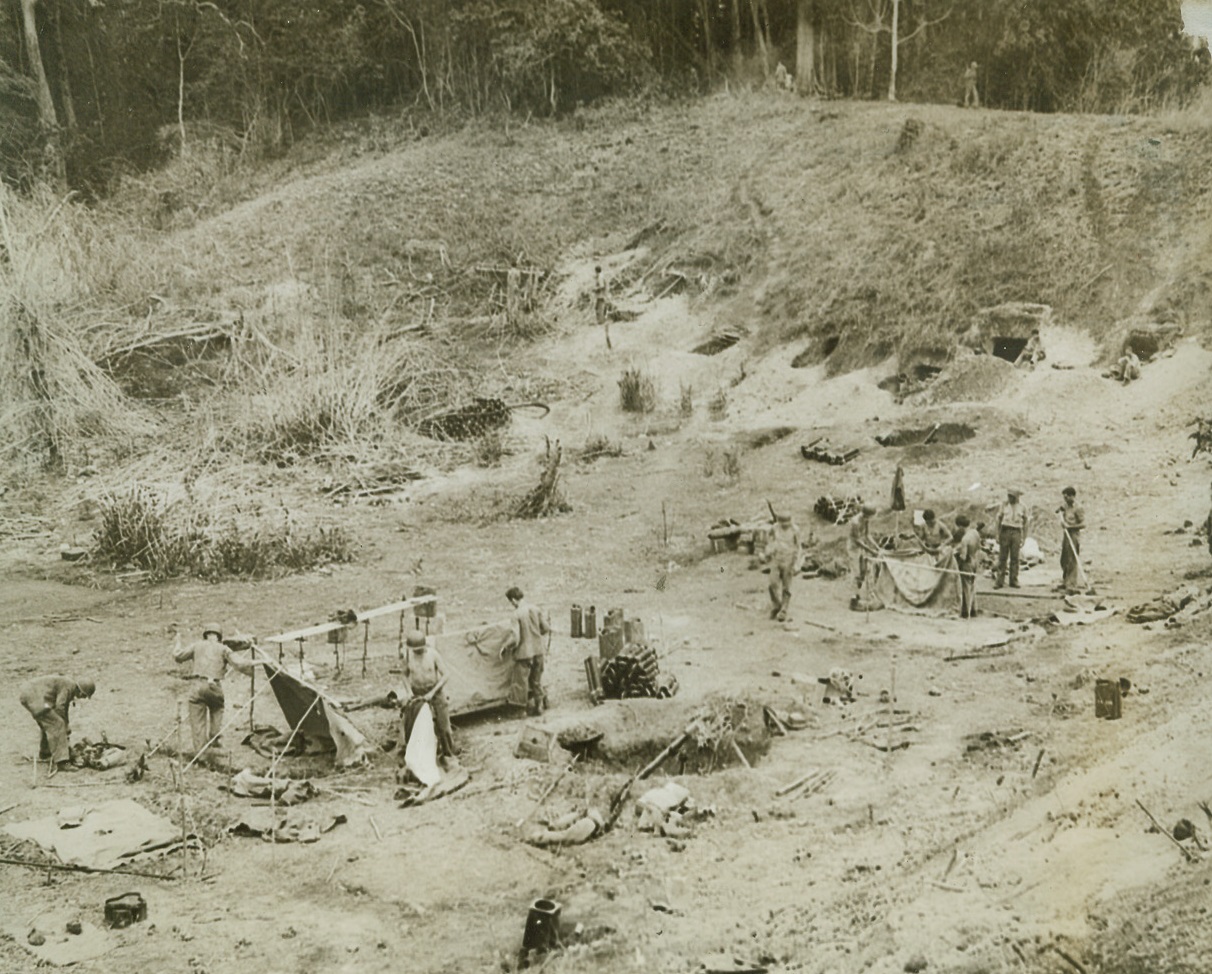
Guadalcanal “Cliff-Dwellers”, 1/16/1943. Guadalcanal, S.I. – Modern “cliff-dwellers”, these members of a U.S. Marine Corps mortar crew are living in a group of caves in a gulch on Guadalcanal. The entrances to the caves, which the boys built themselves, can be seen at upper right of photo. An armed sentry can also be seen on duty (upper right) at the top of the gulch as the boys go about their chores. Credit line (Official Marine Corps photo – ACME);
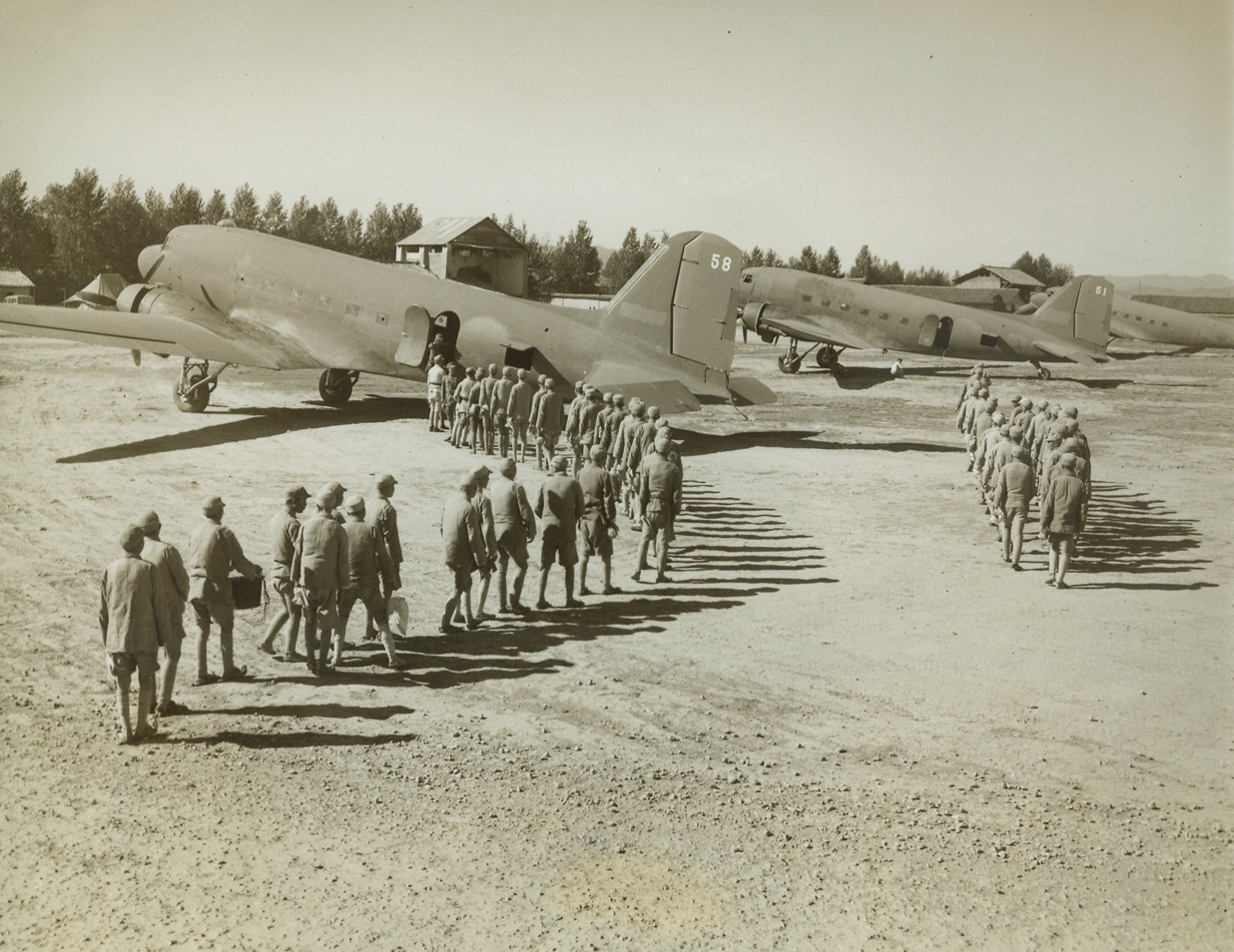
American Transports Fly Chinese Troops, 1/13/1943. Somewhere in China – Chinese troops march to American troop transports, of the India-China ferry command, to be flown to scattered combat fields and training centers. They board the big ships “somewhere in China.” Credit line (ACME);
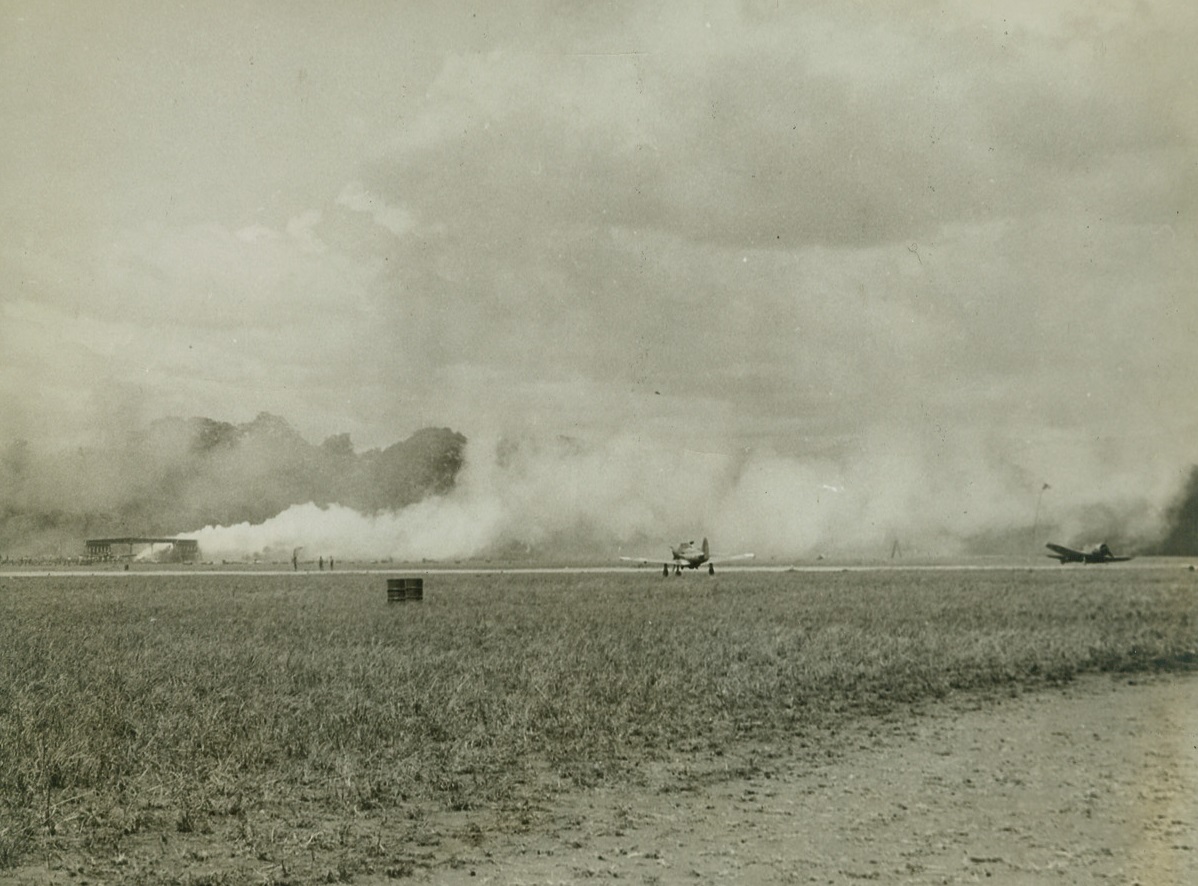
Japs Make Direct Hit, 1/16/1943. Guadalcanal, S.I. – Clouds of white smoke pour from a hangar at Henderson field on Guadalcanal during a Jap raid, marking the spot where enemy bombs found their target. It was a direct hit. The two planes shown in photo apparently escaped the attack. Credit line (Official Marine Corps photo – ACME);
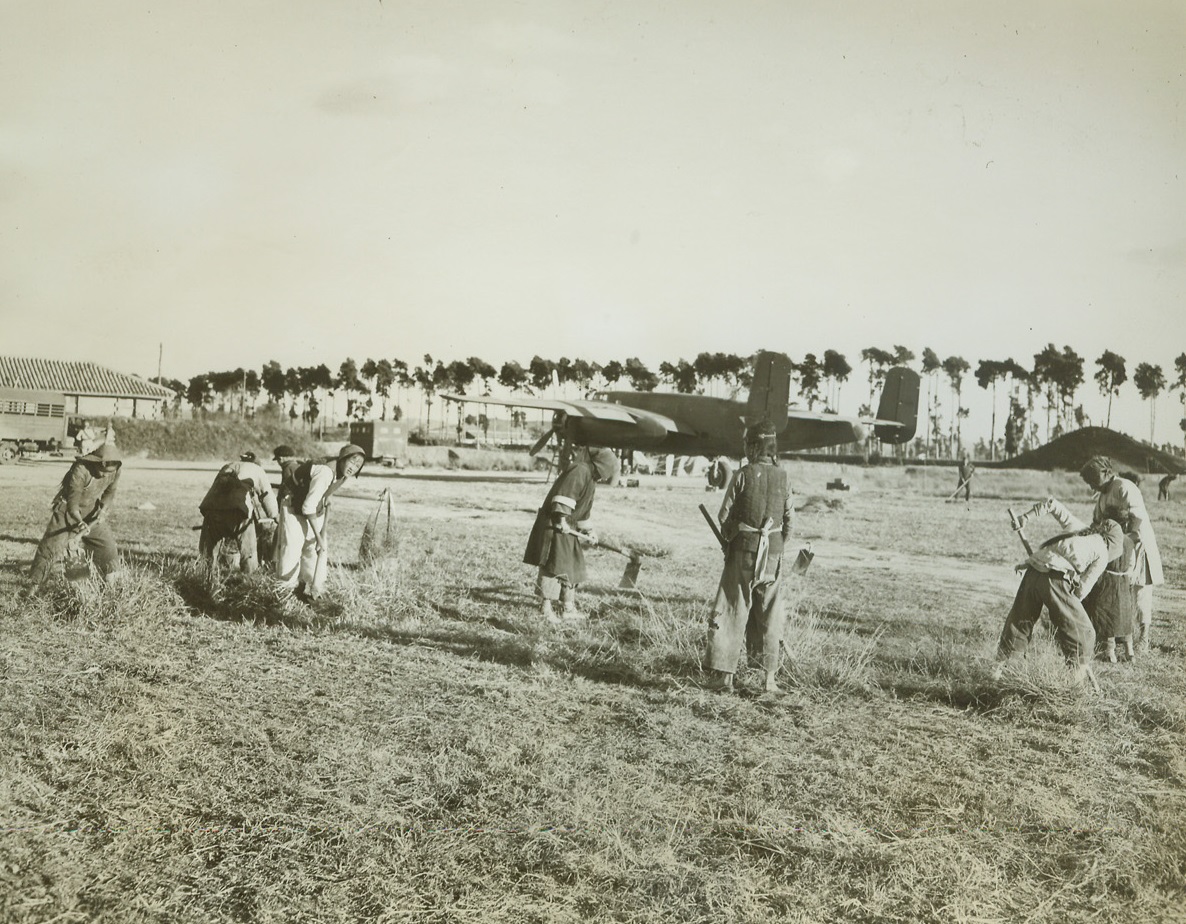
Chinese Women Work on American Airfield, 1/13/1943. Somewhere in China – Using hoes and scythes, Chinese women and children clear the ground to enlarge an American airfield in China. They consider it their patriotic duty to work for their country and to assist the Americans who are their allies. Credit line (ACME);
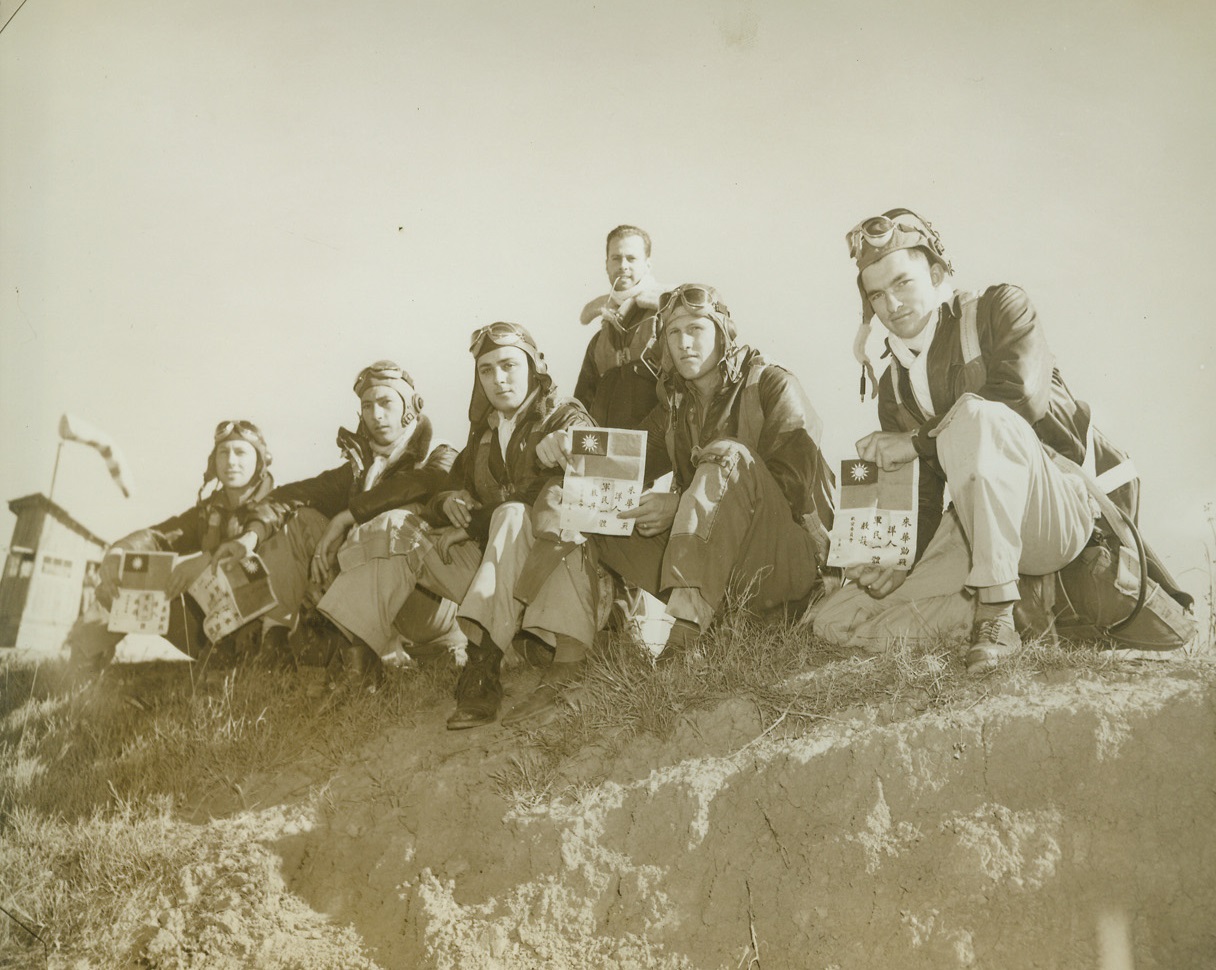
Ticket Home, 1/13/1943. Somewhere in China – American fliers in China display flags issued by the Chinese government which insure assistance and safe return to an American base if they should be forced down. Left to right, seated: Lt. T.J. Clark, Pennsylvania; Lt. W.A. Smith, Oklahoma; Lt. R.W. Lucia, New York; Lt. J.M. Williams, Texas; lt. R.P. Atkinson, West Virginia; standing, Capt. C.L. Blair, Michigan. Credit line (ACME);
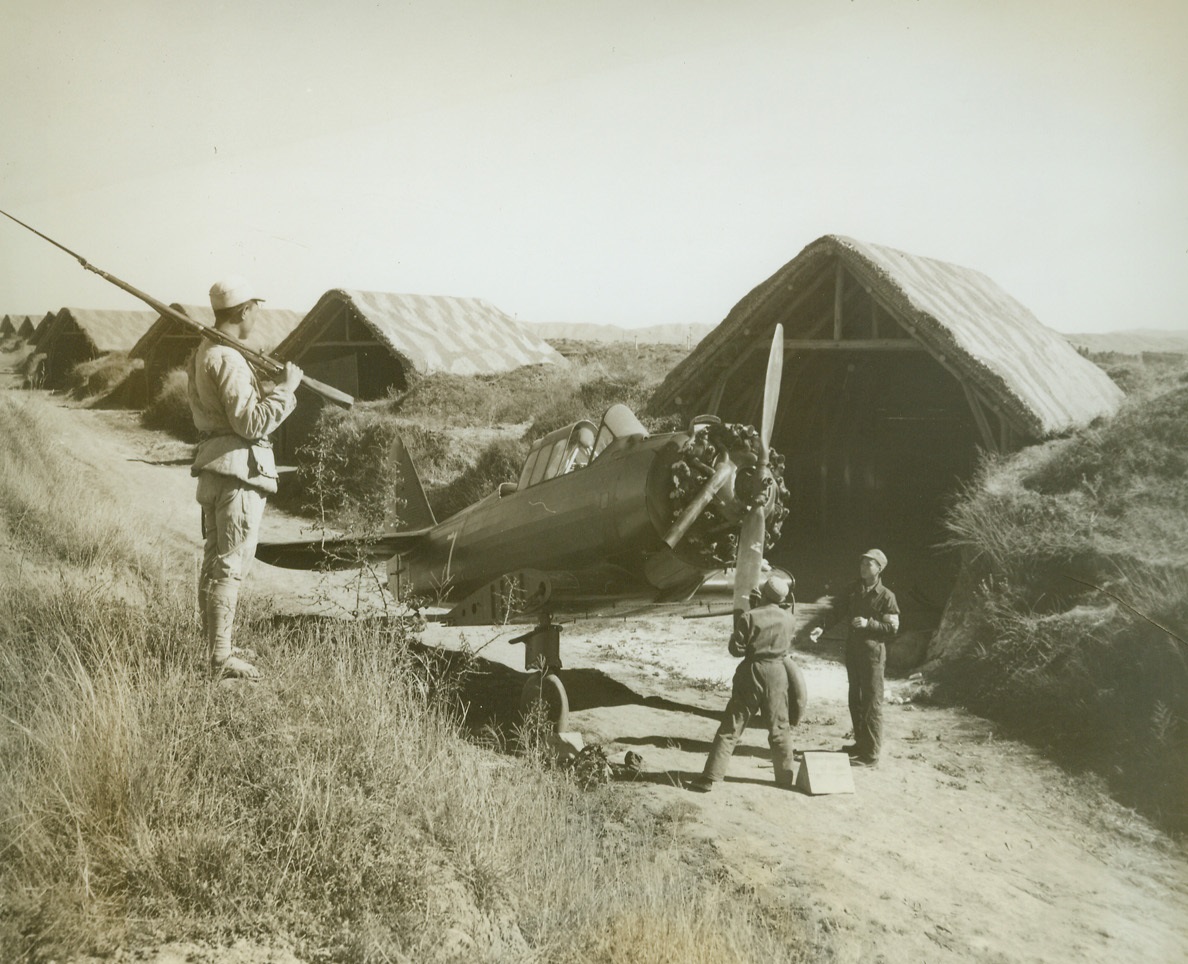
Camouflaged Huts House Fighter Ships in China, 1/13/1943. Somewhere in China – A Chinese soldiers stands guard as repair work is started on a U.S. fighter plane. Planes are stored in these concealed buildings of a Chinese dispersal area. Credit line (ACME);

Teatime in China, 1/12/1943. Somewhere in China – American soldiers have a spot of tea, native style, in a teashop located in an ancient pagoda. (left to right): Sgt. Ivan O. Stanberry, California; Sgt. Charles M. Janes, California; Sgt. Lawson R. Hillman, California; Sgt. Claude J. Smith, North Carolina, and Sgt. Robert R. Wrigglesworth, Wisconsin, are served tea in covered cups and ringed by villagers. Credit line (ACME);
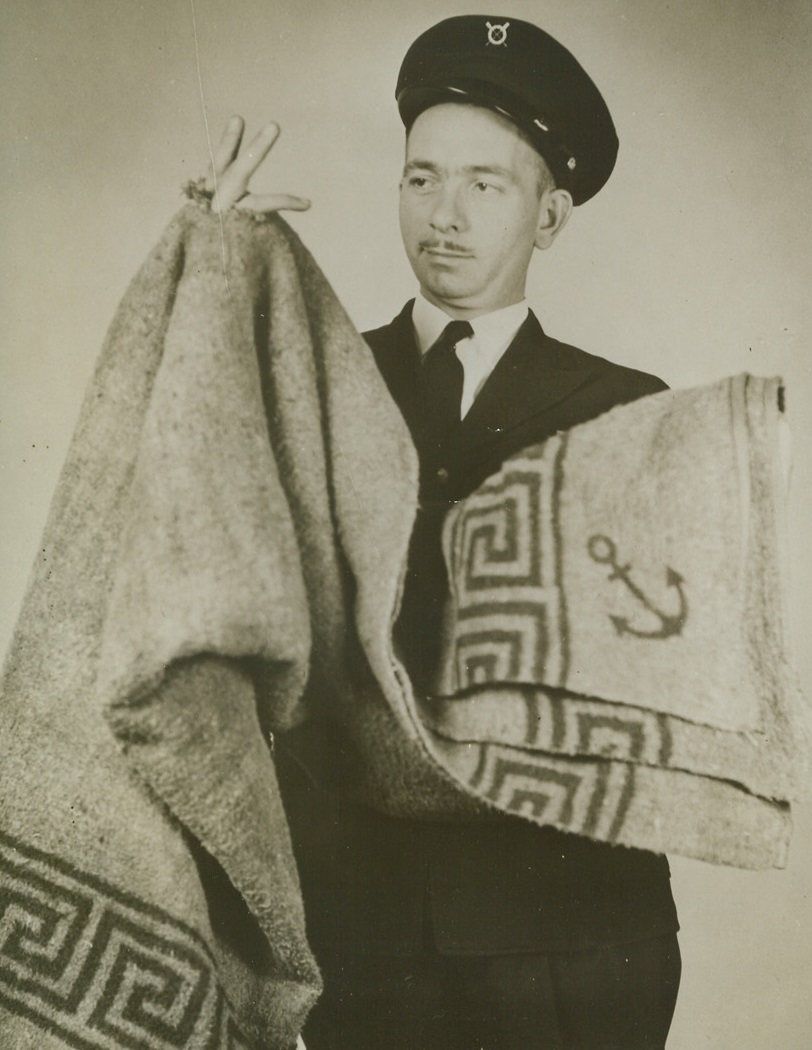
No Title, 1/5/1943. Coast Guardsman James Pox, Uniontown, Pa., waves his fingers through the shell hole ripped by Japanese fire just a few minutes after he left the bunk, the blanket covered. The action occurred in the Solomons. Fox, one of the coast guardsmen who landed the Marines in the original invasion of Guadalcanal, salvaged the blanket from the routed Japs’ effects. Back home on leave, he still has the souvenir of his narrow escape and the Americans still have the island. Credit line (ACME);

Fourth Carrier Lost in Pacific Battles, 1/12/1943. One of the last photos to be made of the U.S.S. Hornet, aircraft carrier which was sunk during the battle of Santa Cruz islands, Oct.26, 1942, by American surface ships after being severely damaged by two attacks of Japanese bomber and torpedo planes. The 20,000-ton carrier was commissioned a year ago: her loss announced on Oct. 31, but her identity was not released until Jan. 11, 1943. A U.S. Destroyer is alongside the stricken ship – the fourth lost in action since outbreak of war in the Pacific. Credit (official navy photo – ACME);
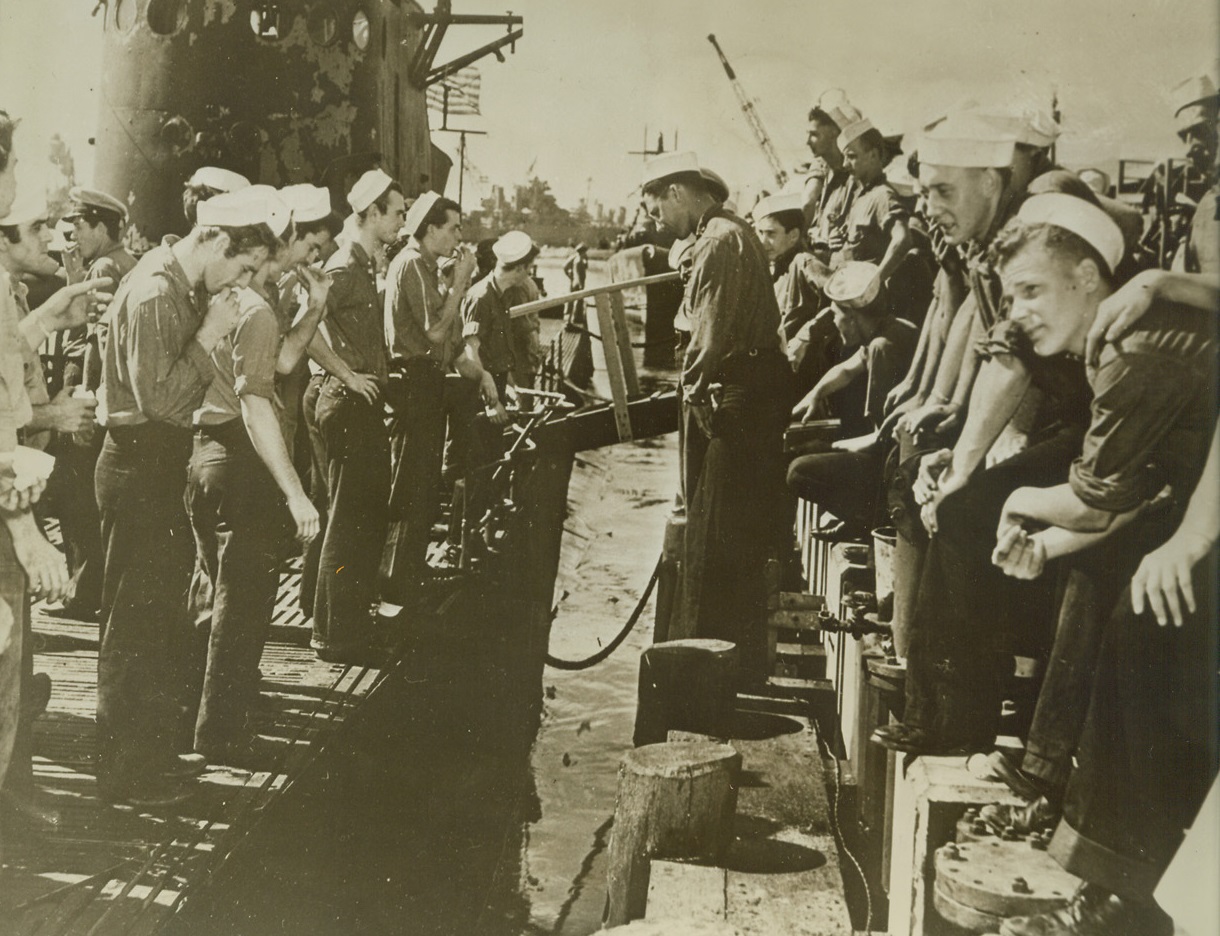
Dockside “Cracker Barrel” Session, 1/21/1943. A Pacific Base – Hungry for news, U.S. sailors line the deck of their weather-scarred submarine (left), after returning to their Pacific base, after long, arduous patrol against the enemy. Other sailors on the dock willingly “dish the dirt” for their buddies, who have returned for rest, recreation, and, best of all, sunlight. Credit line (U.S. Navy photo from ACME);
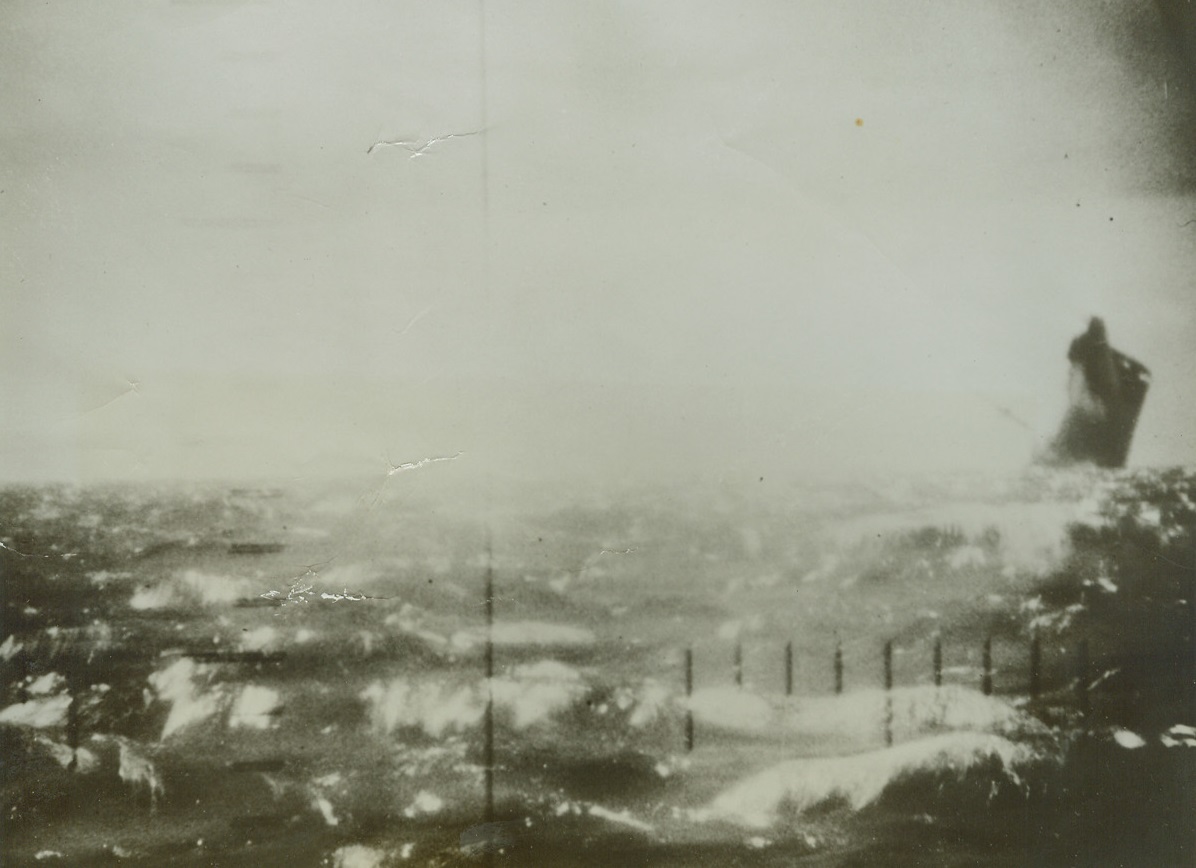
American Submarines Attack Jap Shipping, 1/23/1943. This picture made by an alert Navy cameraman from the periscope of the attacking American submarine. In a rising crescendo of death and destruction, three torpedoes crash into this unsuspecting Japanese merchantman, of more than 9,000 gross tons. Lying in an unidentified Pacific harbor. Heavy smoke rolls up from the stricken vessel has already concealed all but the camouflaged bow from the photographer in the submarine, who took the picture thru the periscope. Credit line (U S Navy official photo from ACME);

Supply Line, 1/26/1943. Guadalcanal, S.I. – Soldiers and natives walk, single file, across the difficult, uneven terrain that is typical of Guadalcanal, carrying supplies to men fighting the battle of Grassy Knoll. The jeep trail to the front, which was about 4 miles West of Henderson field, ended about 11/2 miles from the fighting lines, and supplies had to be carried on foot. Six Jap positions were taken, and 110 Japs were killed in the battle. Credit line (ACME);
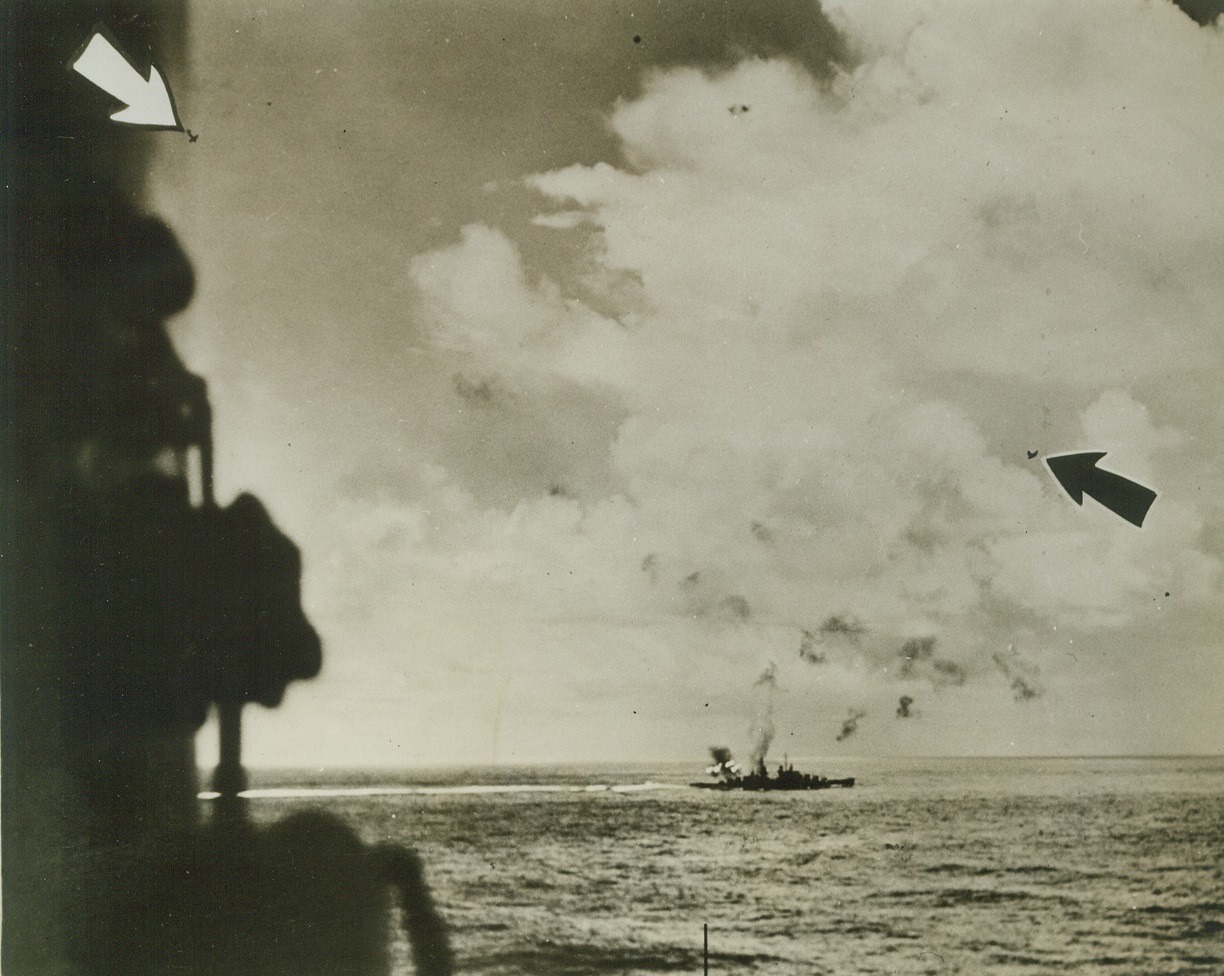
The Juneau Fights Back, 1/26/1943. Her after batteries blazing, the USS Juneau demonstrates her fighting qualities during a Japanese air attack in the battle of Santa Cruz islands, October 26, 1942. Less than a month later, in the battle of Guadalcanla, November 13-15, the Juneau was sunk by enemy action. The picture indicates that a bomb dropped by the plane headed for cloud protection at right fell off the port side of the Juneau, which is concentrating fire on the bomber just starting its dive at the left. Credit line (Official U.S. Navy photo from ACME);
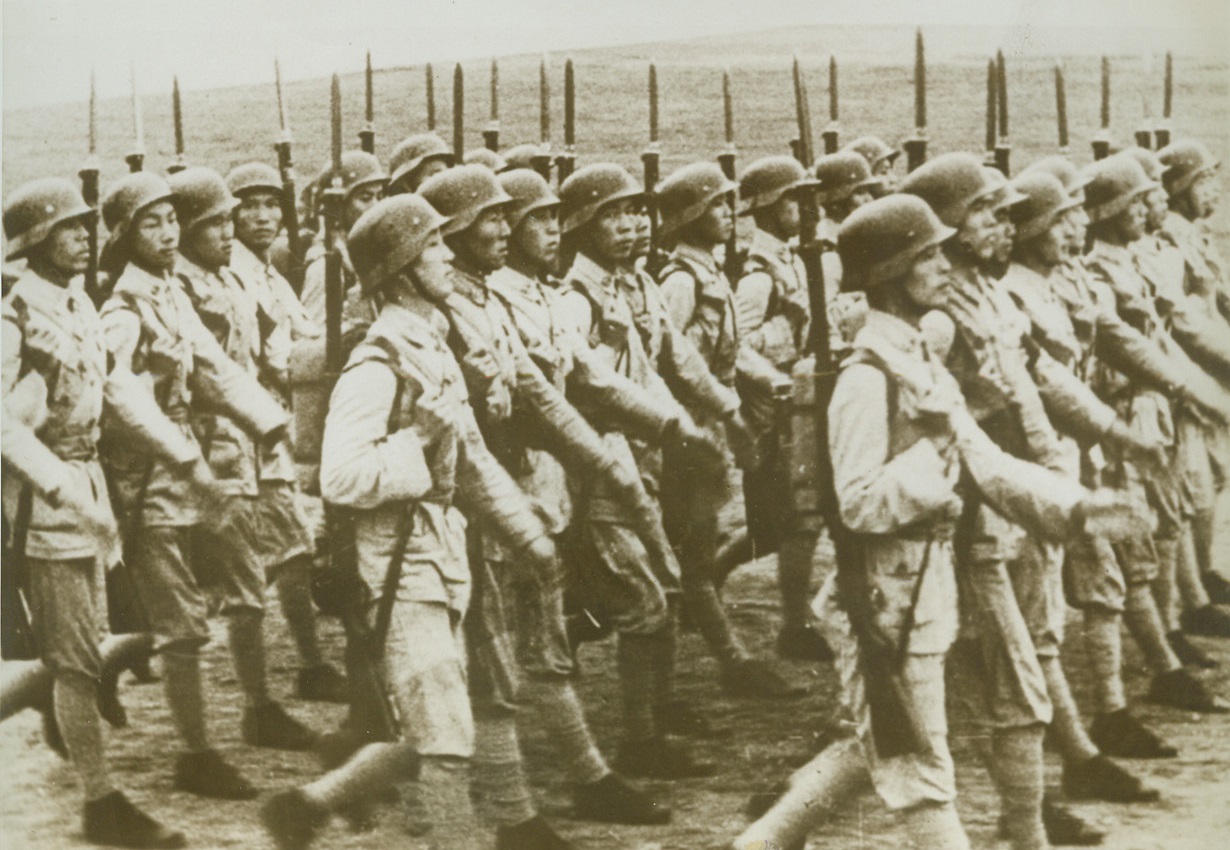
Anniversary of Chinese Revolution, 1/6/1943. Changtu, China – Chinese infantrymen march in a parade held to commemorate the 31st anniversary of the Chinese revolution and the birth of the Chinese Republic. The parade was held in Changtu, capitol of the Province of Szechwan, which is the center of Chinese resistance to Jap invaders at the present time. Credit line (ACME);
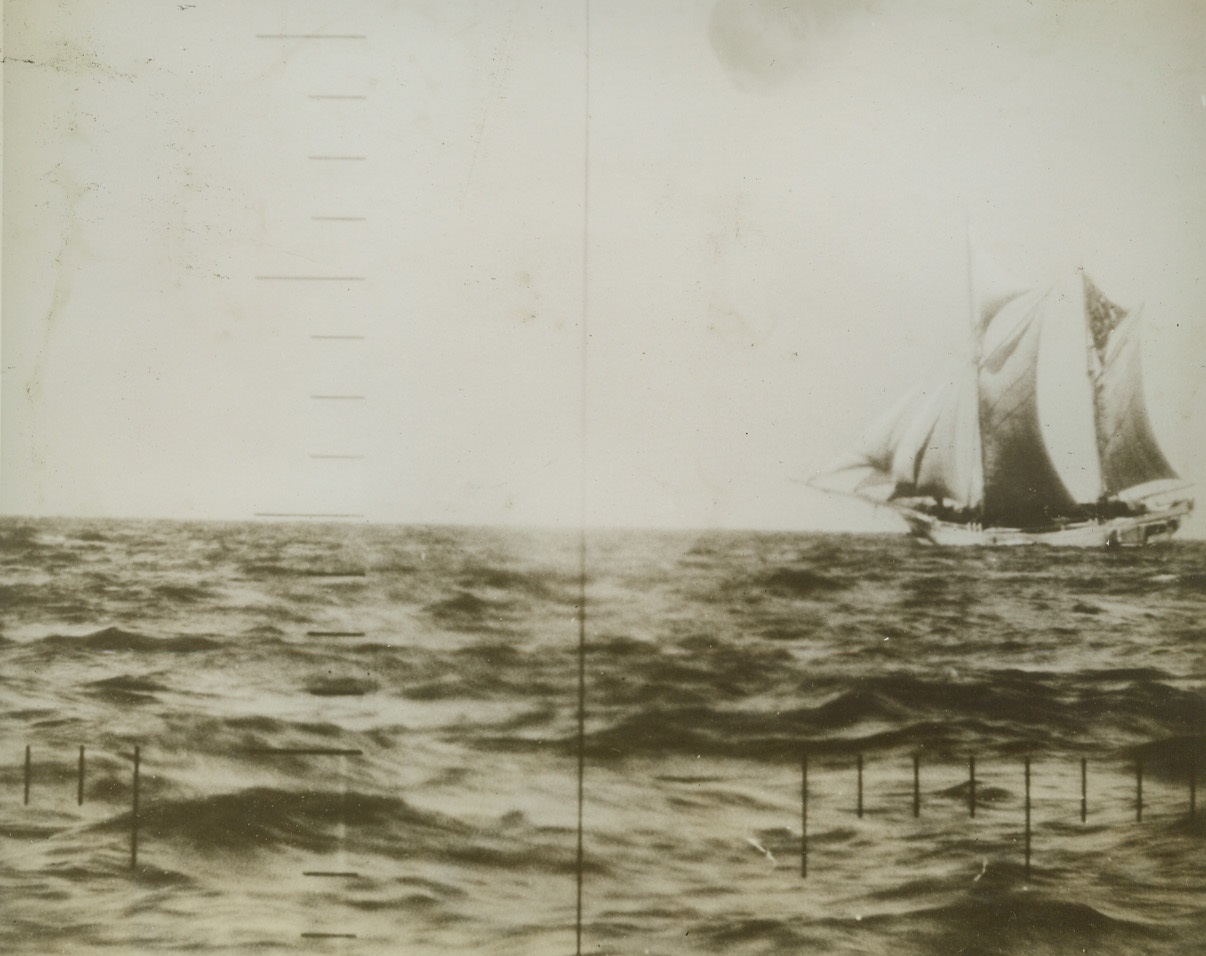
Sails and a Submarine, 1/23/1943. Only the horizontal and vertical lines disclose that this remarkably clear picture of an unidentified schooner, in enemy Pacific waters, was made throught the periscope of a U.S. submarine. In these days of steam, such pictures of schooners under full sail are rare. The Japanese use many sailing vessels, formerly employed in hauling copra and inter-island supplies, as patrol ships. Credit (official US Navy photo from ACME);
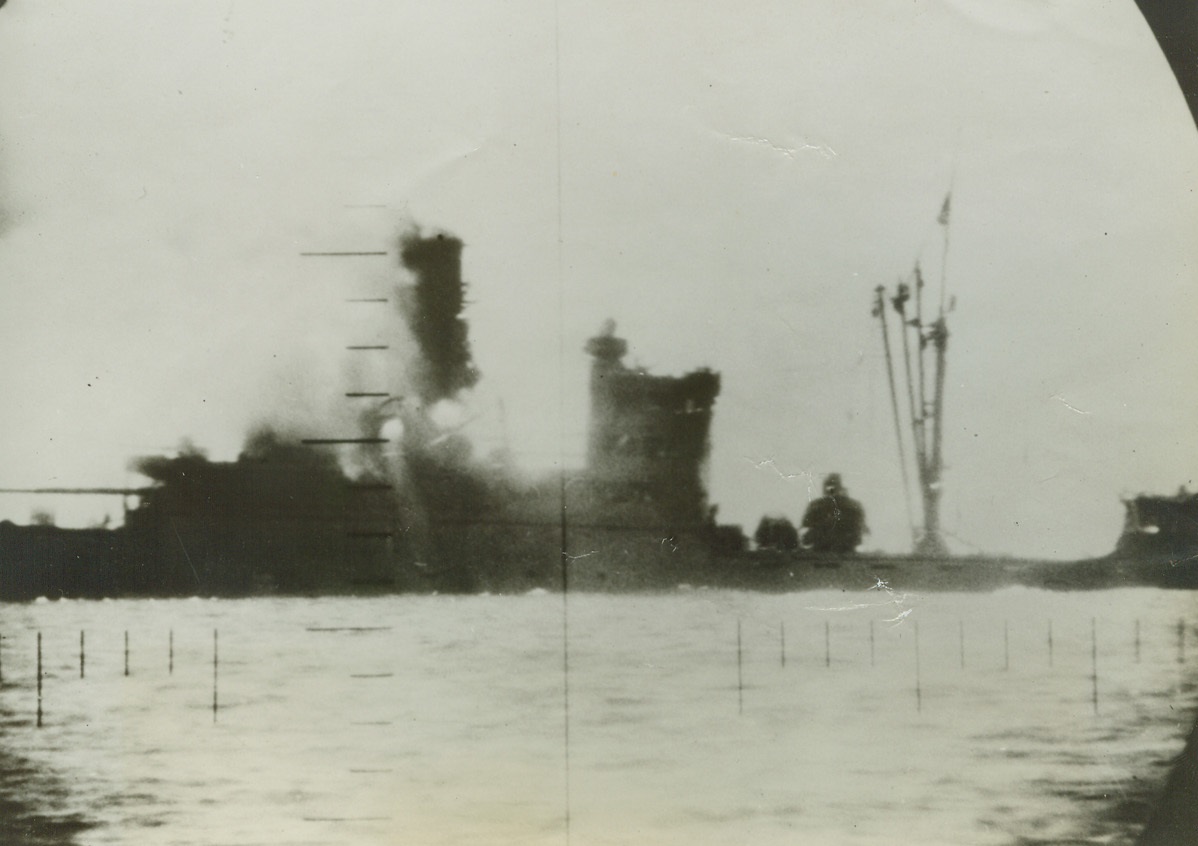
American Submarines Attack Japanese Shipping, 1/23/1943. Attrition in Pacific Waters. Dealt a death blow by the U.S. submarine from which this periscope picture was snapped, an unidentified Japanese ship breaks out aflame amidship. The ship may have been used as a transport.;
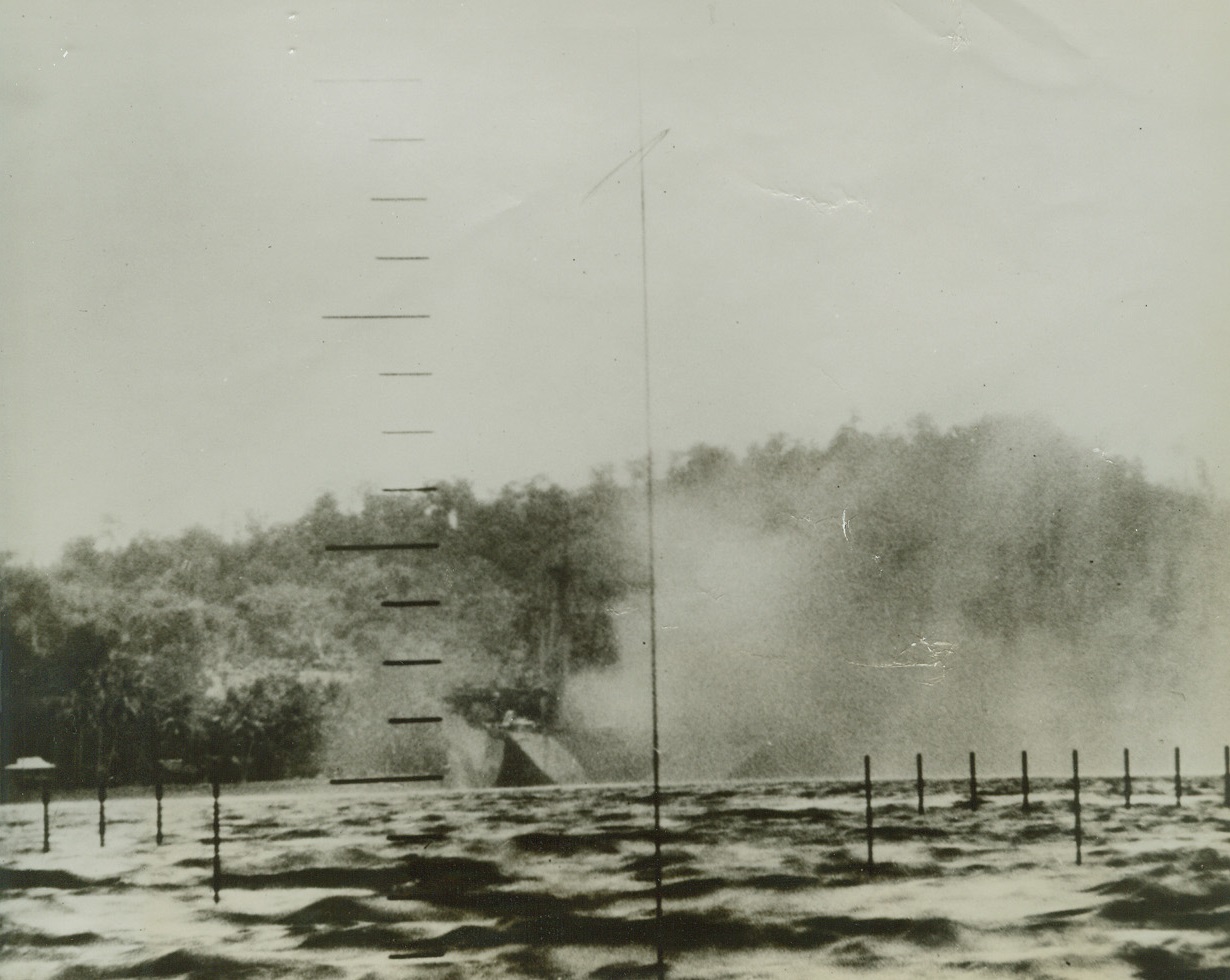
American submarines attack Japanese shipping, 1/23/1943. Attrition in Pacific waters. Blasted by U.S. torpedoes, a Japanese ship makes her death plunge in a choppy sea. A photographer aboard the attacking submarine snapped this graphic picture through the periscope just as the stern of the stricken ship lifted up from the surface to silhouette against the sky. Credit line (US Navy official photo from ACME);
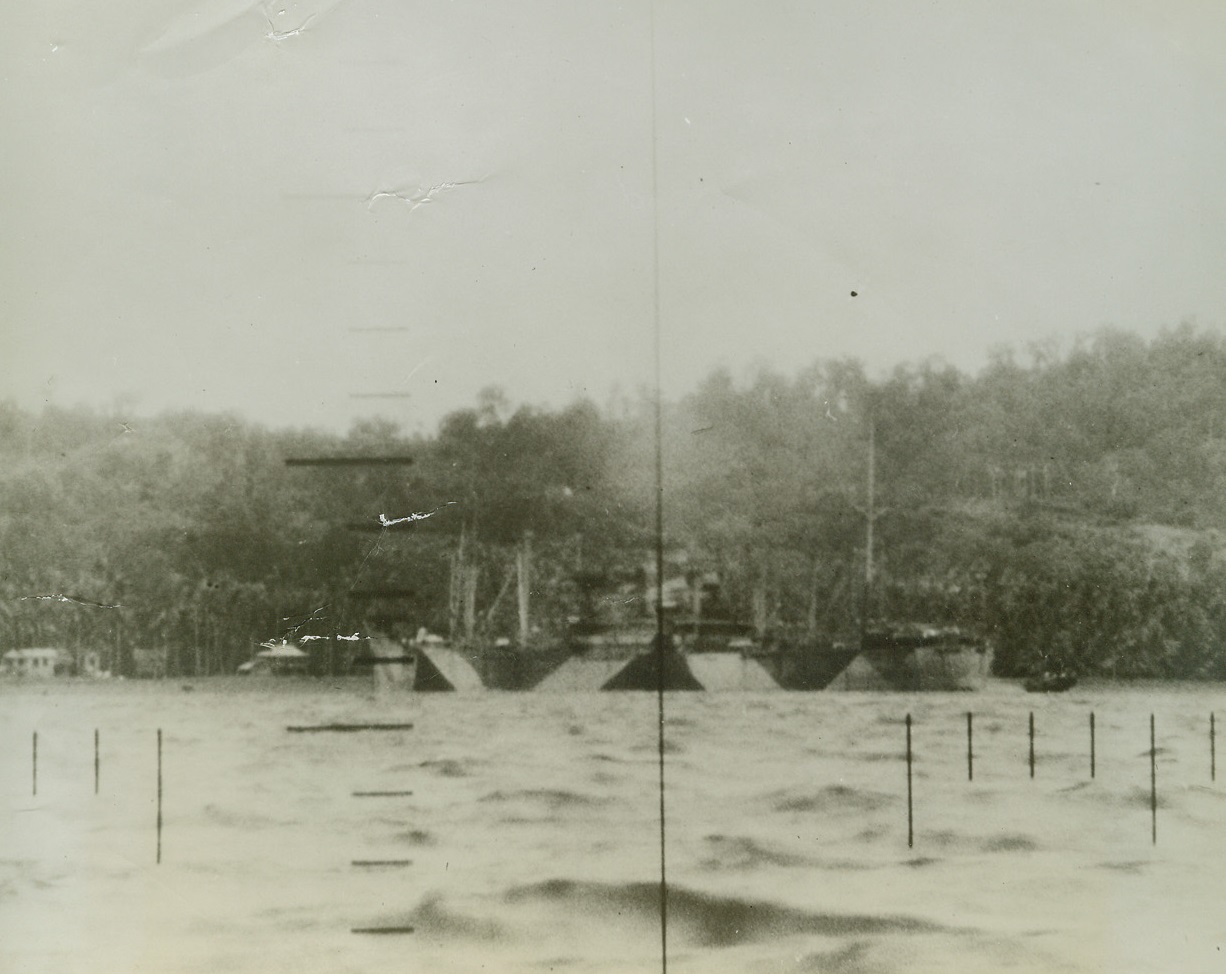
American Submarines Attack Jap Shipping, 1/23/1943. An unsuspecting Japanese merchantman of more than 9,000 gross tons lies in an unidentified Pacific harbor unaware of the U.S. submarine from which this daring picture was snapped. Note the small boat pulling away from the camouflaged vessel. Shortly after this picture was made American torpedoes found their mark on this vessel which was close to shore. Credit line (US Navy official photo from ACME);

They poured it on Jap-held Wake Island, 1/4/1943. “at an unidentified U.S. advance base in the Pacific”, crew members of an Army Air Force bomber stand under the wing of their ship before taking off for a Christmas eve bombing attack on Wake island, scene of the gallant Marine stand a year ago. In this raid, 76,000 pounds of bombs were dropped on the Jap-held island (Not to Editors: Do not mention type of bomber shown) Credit (7th Air Force photo from ACME);
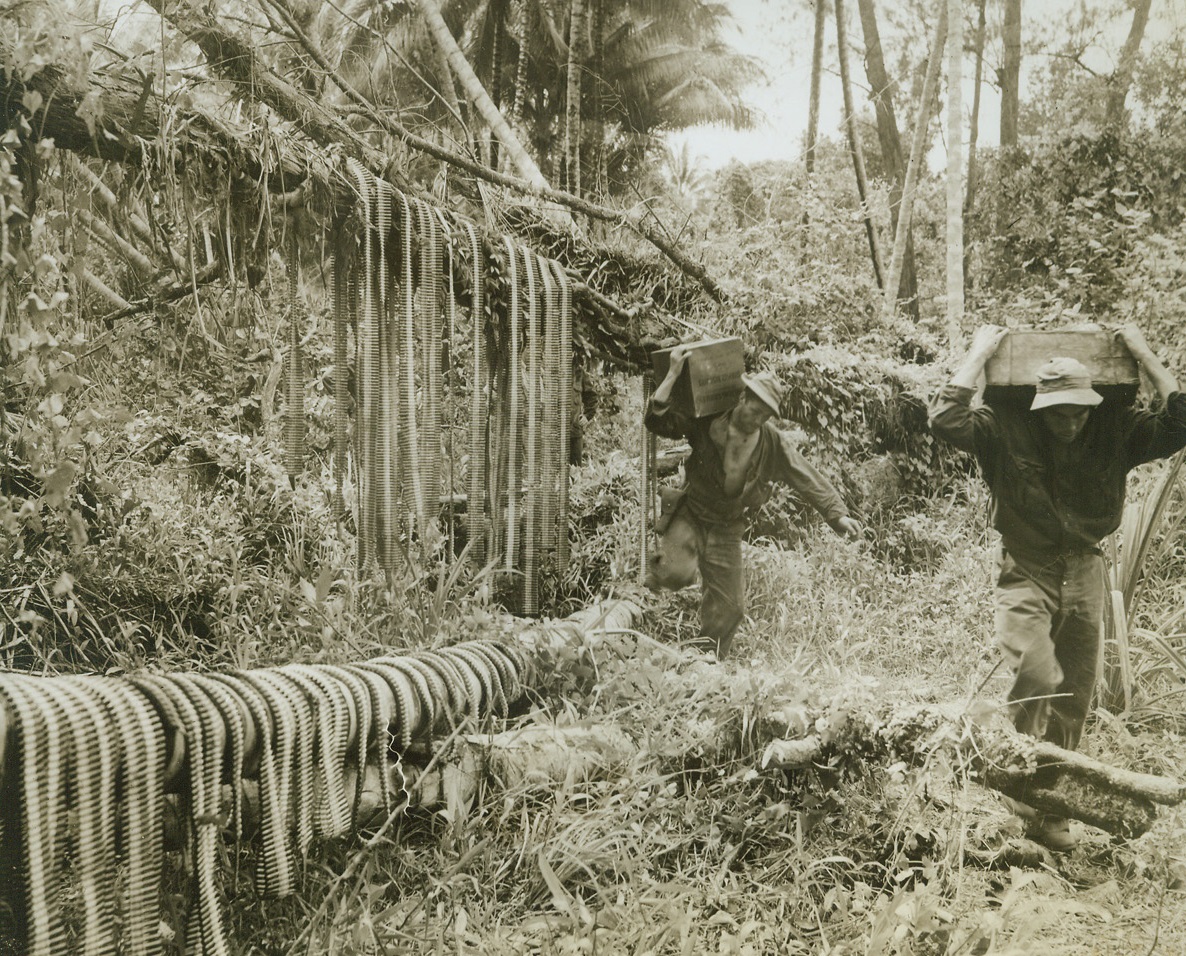
Passing the Ammunition, 1/4/1943. New Guinea – U.S. soldiers carry ammunition up to the front preparatory to the offensive to retake Buna. Photo was taken at a native village before the campaign. Credit line (ACME);
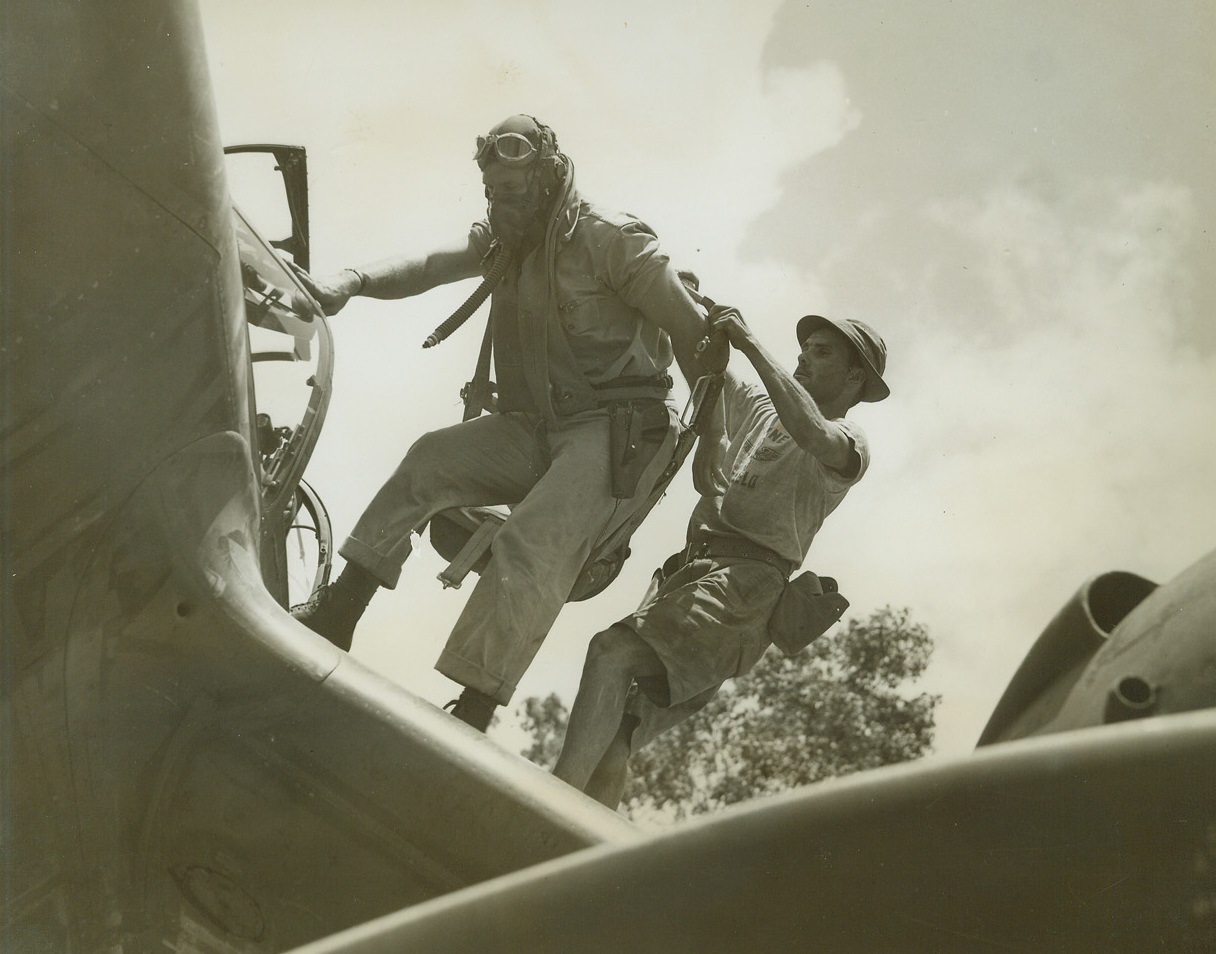
Getting Into His Chute, 1/10/1943. Port Moresby, New Guinea – A new fighter group with their speedy P-38’s are now on the job at Port Moresby. Here 1st Lt. Robert Faurot, of Cape Girardeau, Mo., climbs into his chute before taking over the controls of his fighter plane. Credit line (ACME);
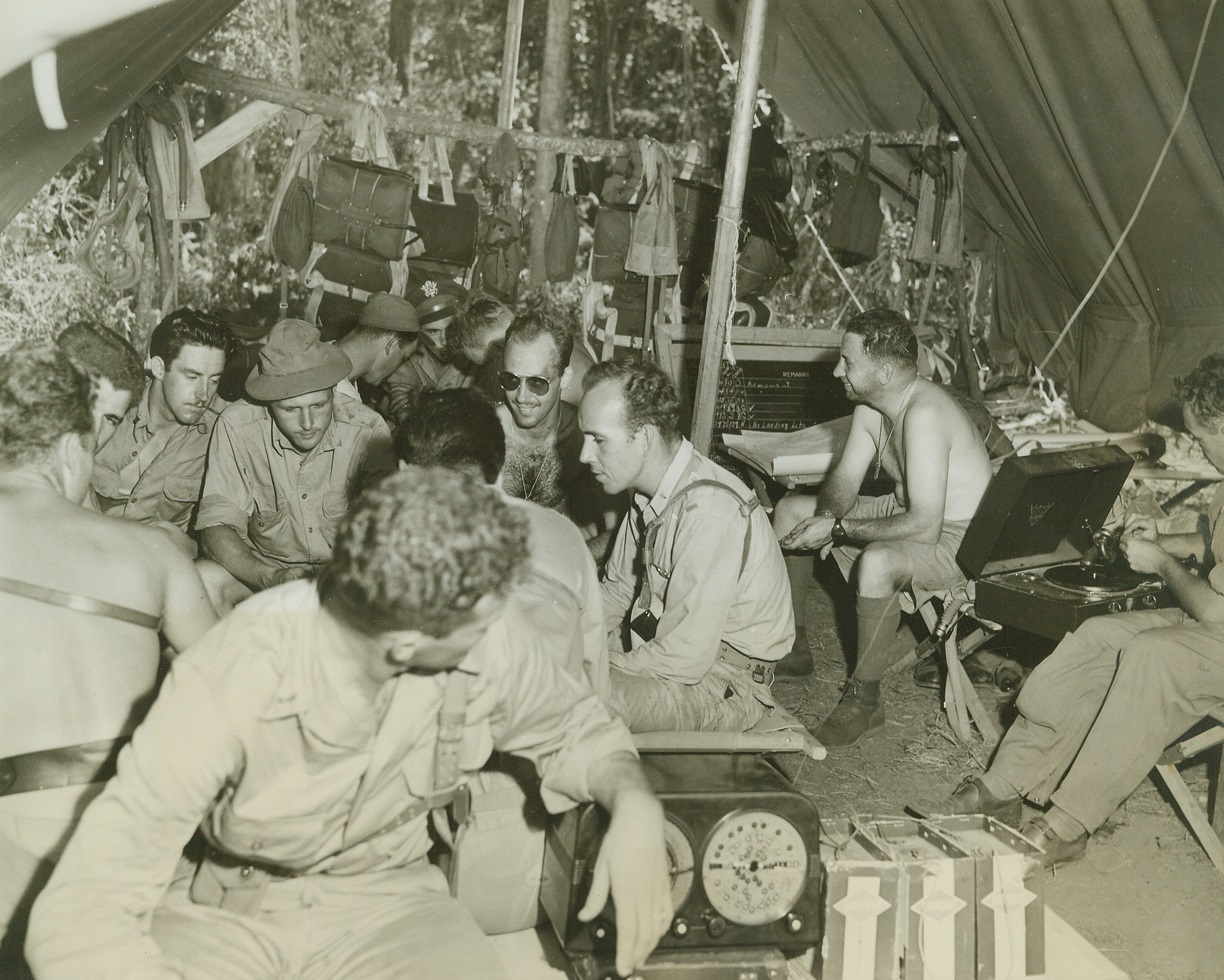
Awaiting the Call, 1/10/1943. Port Moresby, New Guinea – A new fighter group with their speedy P-38’s are now on the job at Port Moresby. The boys have been on the alert ever since their arrival. Here a group of American fighter pilots for the P-38’s play cards, listen to records and radio, or just sit as they await the call to go into action. Note the chutes hanging in the rear of the tent. Credit line (ACME);
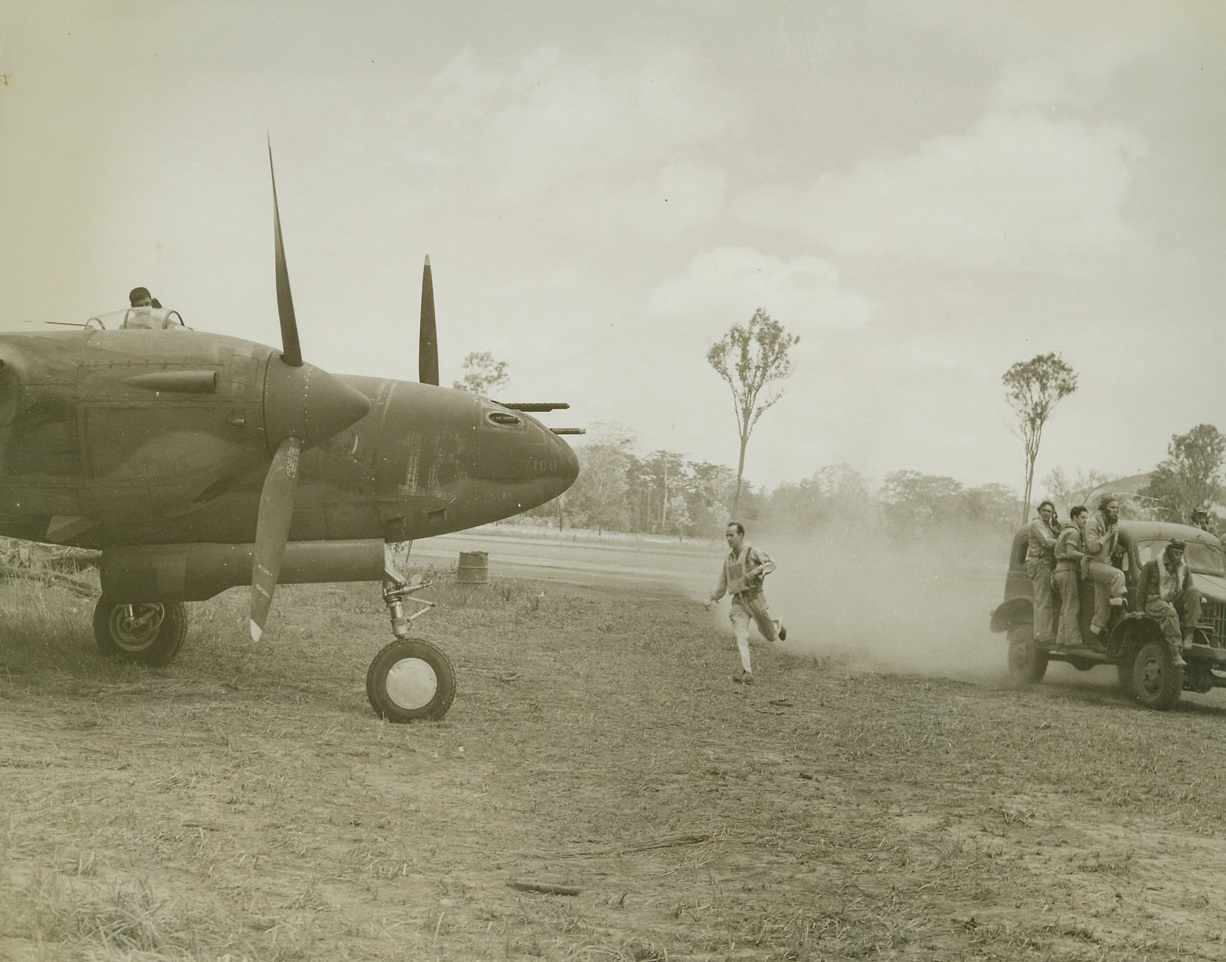
Quick Delivery, 1/10/1943. Port Moresby, New Guinea – A new fighter group with their speedy P-38’s are now on the job at Port Moresby. Here a truck brings an American P-38 pilot to his plane, where a mechanic is all ready to start the motors. The pilot rushes up to be set for the takeoff. Credit line (ACME);
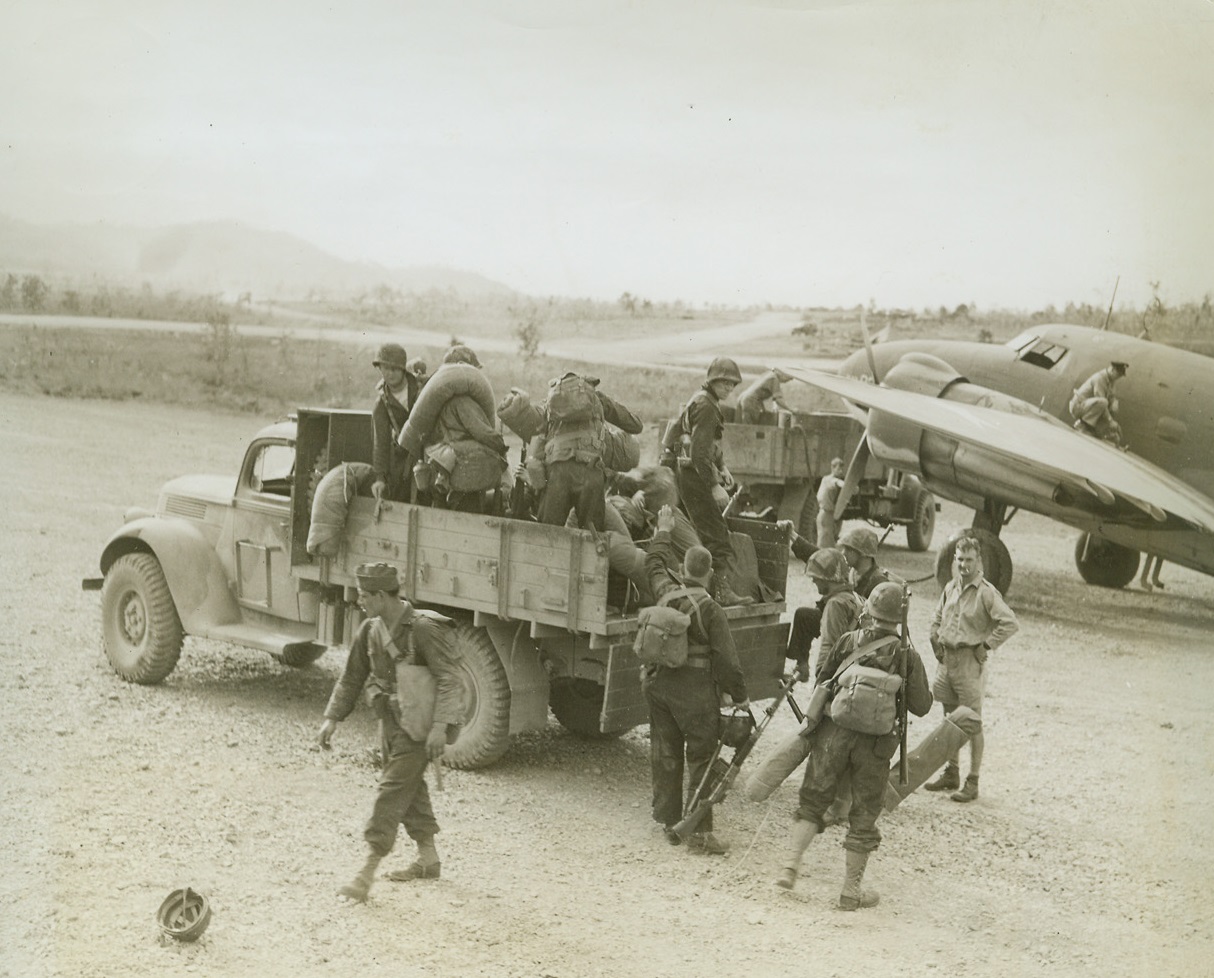
Planes Land American Infantry in New Guinea, 1/9/1943. Port Moresby, New Guinea – American infantrymen are shown as they were landed by a transport plane near here and transferred to their camp by truck – augmenting the American forces. Credit line (ACME);

Cold Weather For Wading, 1/10/1943. Alaska – This big PBY patrol bomber is being maneuvered toward land in the icy Northern Pacific waters by a Navy ground crew. Tough going, but nothing seems to stop a ground crew. Credit (official US Navy photo from ACME);
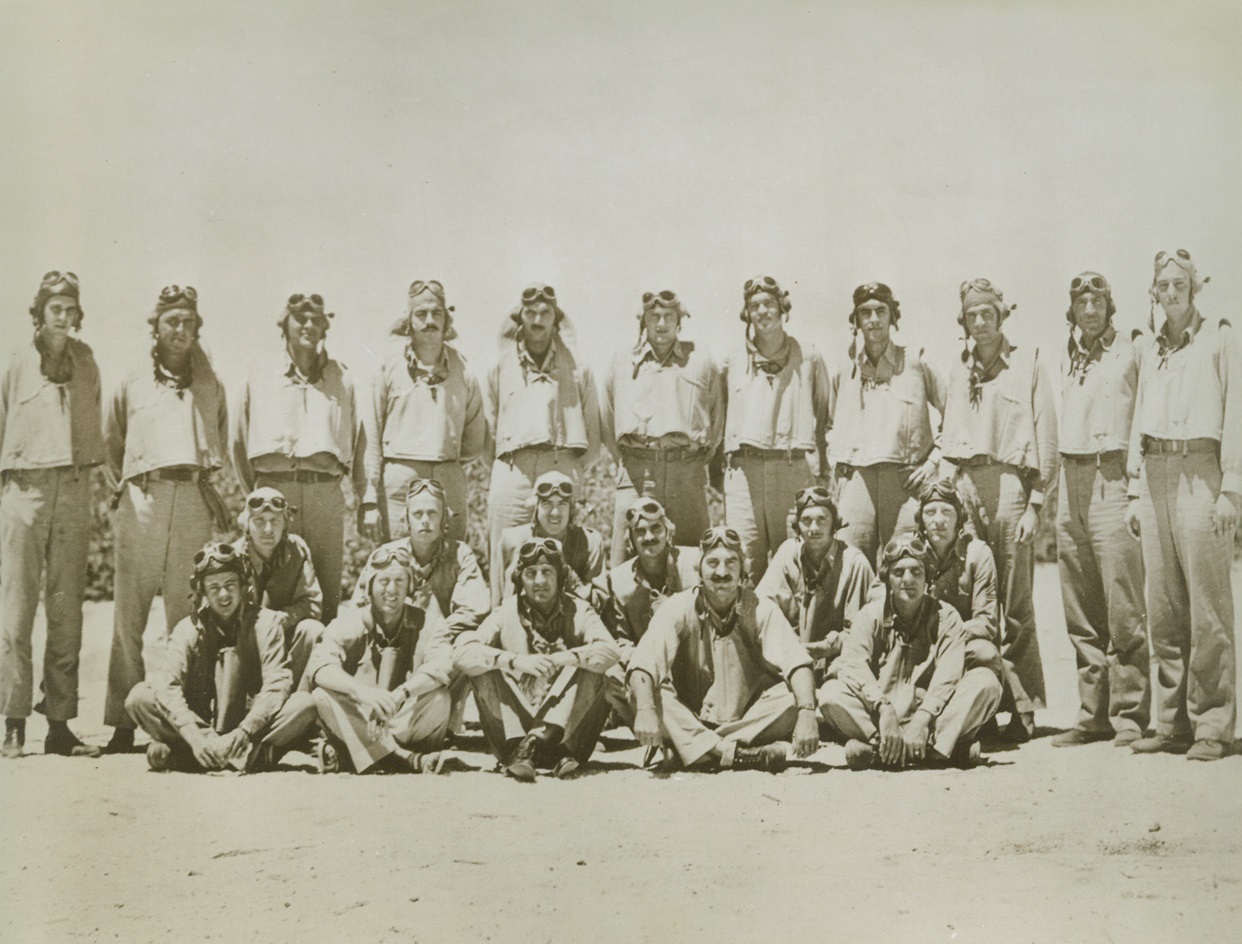
Midway Bombing Squadron, 1/9/1943. Pictured here on the sands of Midway are the pilots of the Marine scout bombing squadron 241, all of whom have been decorated for their heroism in the battle of Midway. Many are now listed as missing and presumed lost. Credit (U.S. Marine Corps photo);
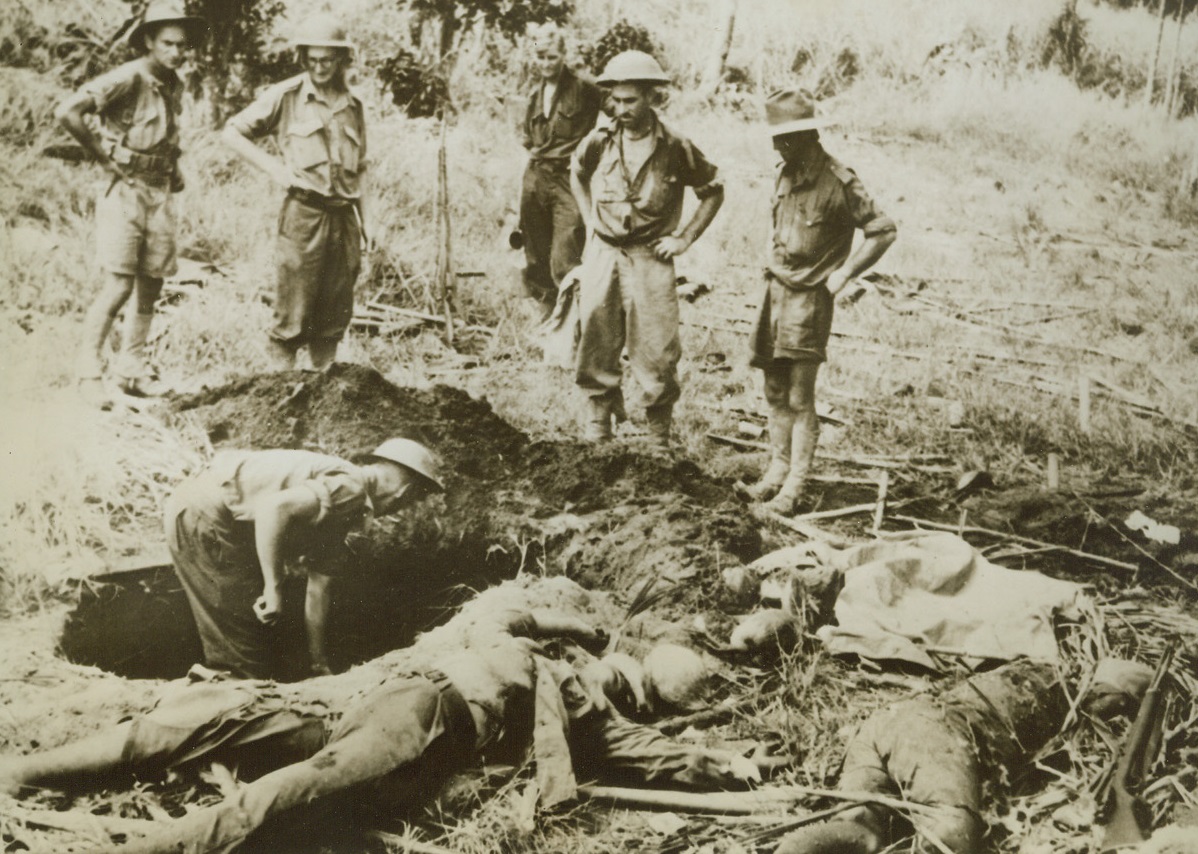
Victors Bury Vanquished, 1/8/1943. New Guinea – One Australian digs a grave for the two Japs (right), while the rest of the burial party stands by, ready to lower the dead Nipponese into the New Guinea earth they made the mistake of invading. This is a grim aftermath of the successful driving out of the enemy from the Easter part of Gona. Credit line (ACME);
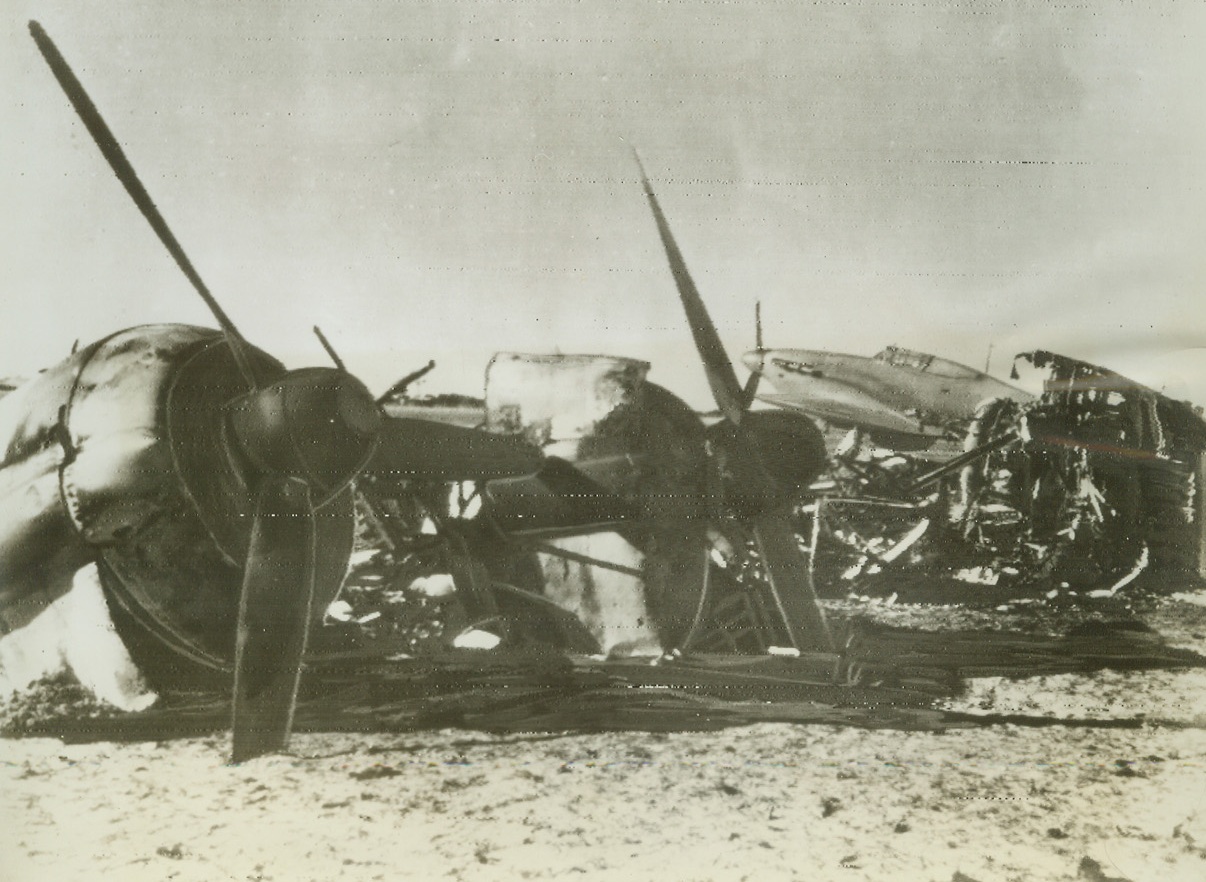
Wrecked Enemy Aircraft, 1/27/1943. Tripoli – This pile of bomb-wrecked enemy aircraft was found on Castelbenito airfield in Tripoli when allied air forces took over. In the background, a British hurricane fighter can be seen, already operating from the captured base. Credit line (ACME radio photo);
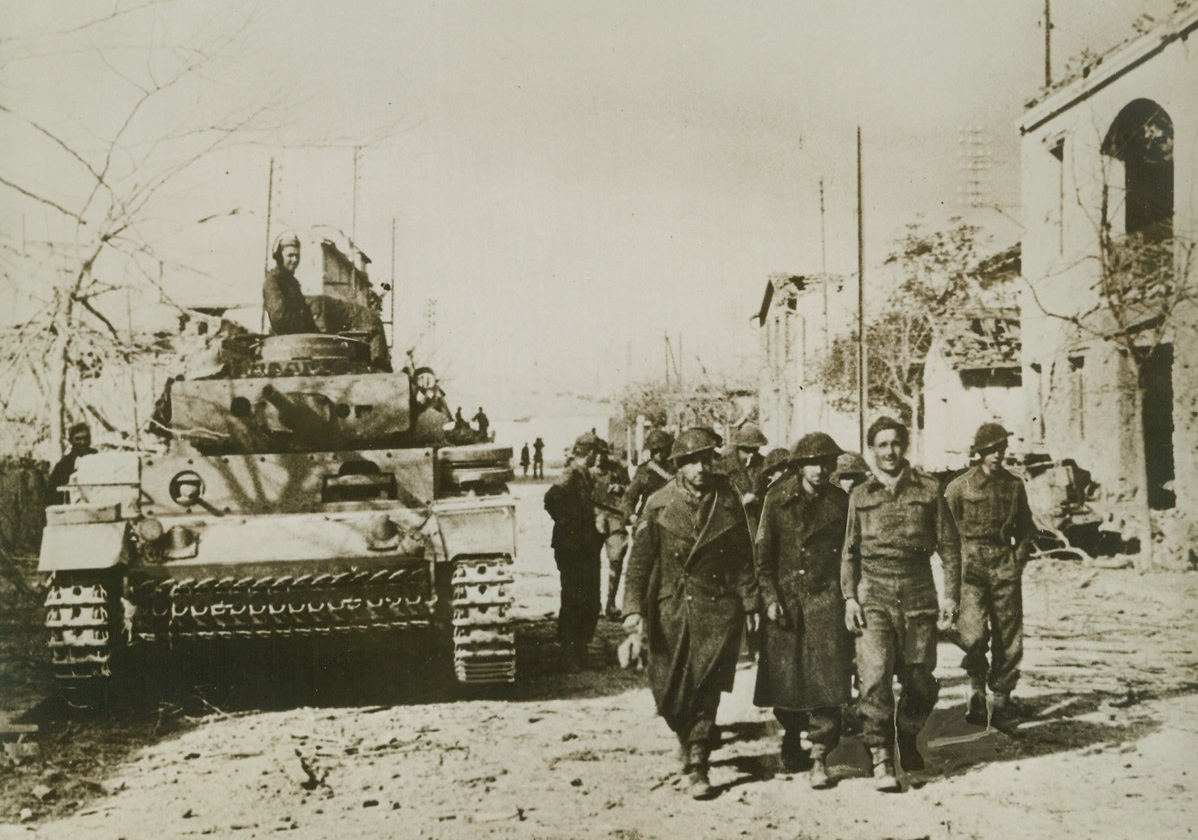
“British Prisoners” – Nazis Say, 1/6/1943. This German photo, received in New York through a neutral country and via London, purports to show, according to the caption, “German tanks and tank-grenadiers mop up in Tebourba (Tunisia) after the fall of that town. The tommies have left their hiding place and are taken prisoners.” Credit line (ACME);

This Way to Tunis, 1/6/1943. Tunisia – This American soldier knows where he’s going – but he’s taking time out to get his wind before heading for Tunis, only 58 kilometers away. Latest reports from that area indicate that the allies are closer to the key city than that. A lightening British Commando-led attack is reported to have wrested the heights of Jebel Azzeg from the Nazis. Credit line is not visible.;

Tidying Up, 1/6/1943. Casablanca: - Native workers repair docks (above), roads, buildings and other traces of damage done by allied bombing attacks on the French Morocco seaport. Credit line (ACME);
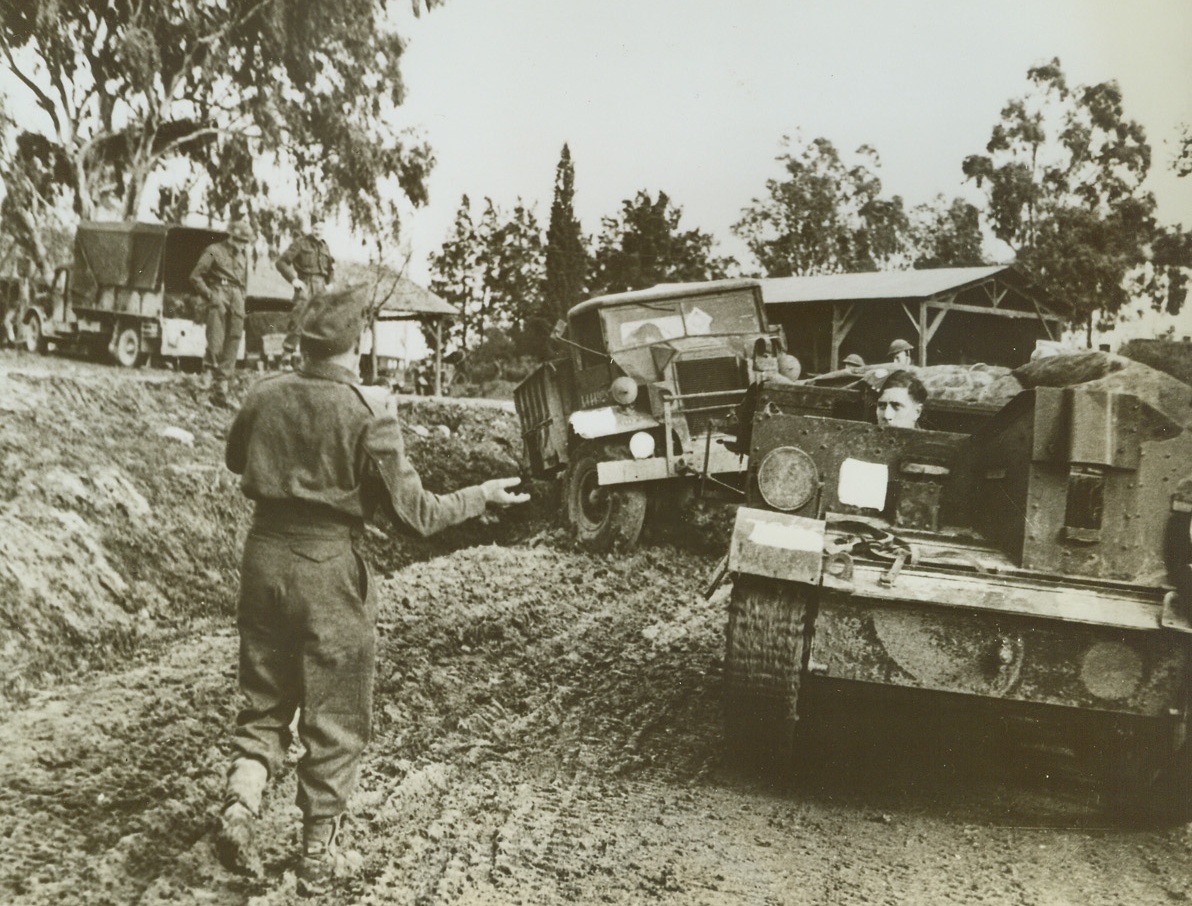
Mud Hampers Allies in Tunisia, 1/26/1943. Med Jez El Bab, Tunisia – Heavy rains on the Med Jez El Bab front in Tunisia have been slowing up allied operations in that sector by making the roads extremely muddy and hazardous for traffic. Here, a lobby which has skidded a ditch is recovered with the aid of a Bren Carrier. Axis reports said tonight that American troops were massing in force for an attempt to cut off Rommel’s coastal line of retreat in Tunisia. Credit line (ACME);
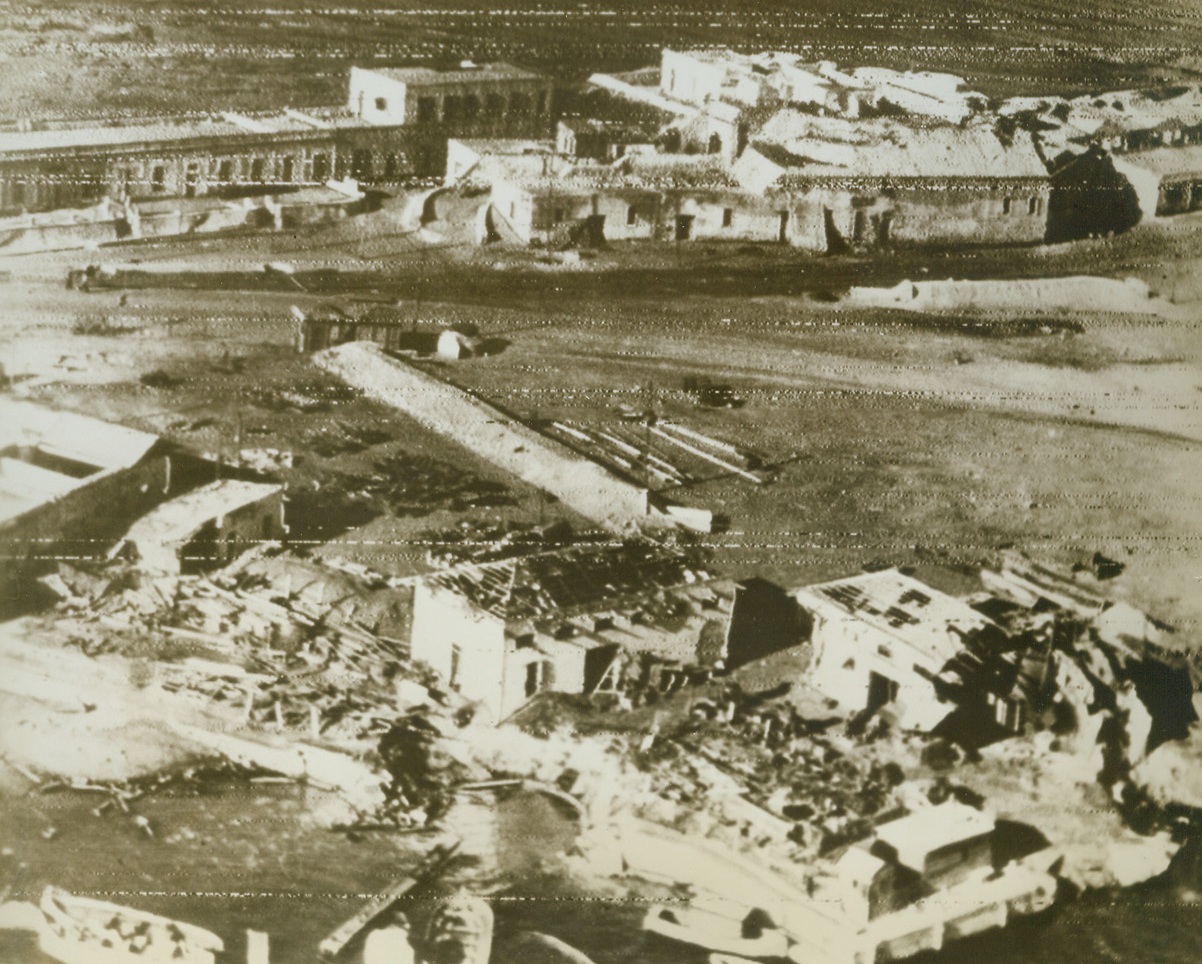
Waterfront at Tripoli, 1/27/1943. Tripoli – Damaged buildings on the waterfront at Tripoli show where the bombs of the RAF and the USAAF found their mark. Latest reports from Tripoli indicate that forces of the British eight Army have captured Ez Zauia, thirty miles West of Tripoli. Credit line (ACME Radio photo);
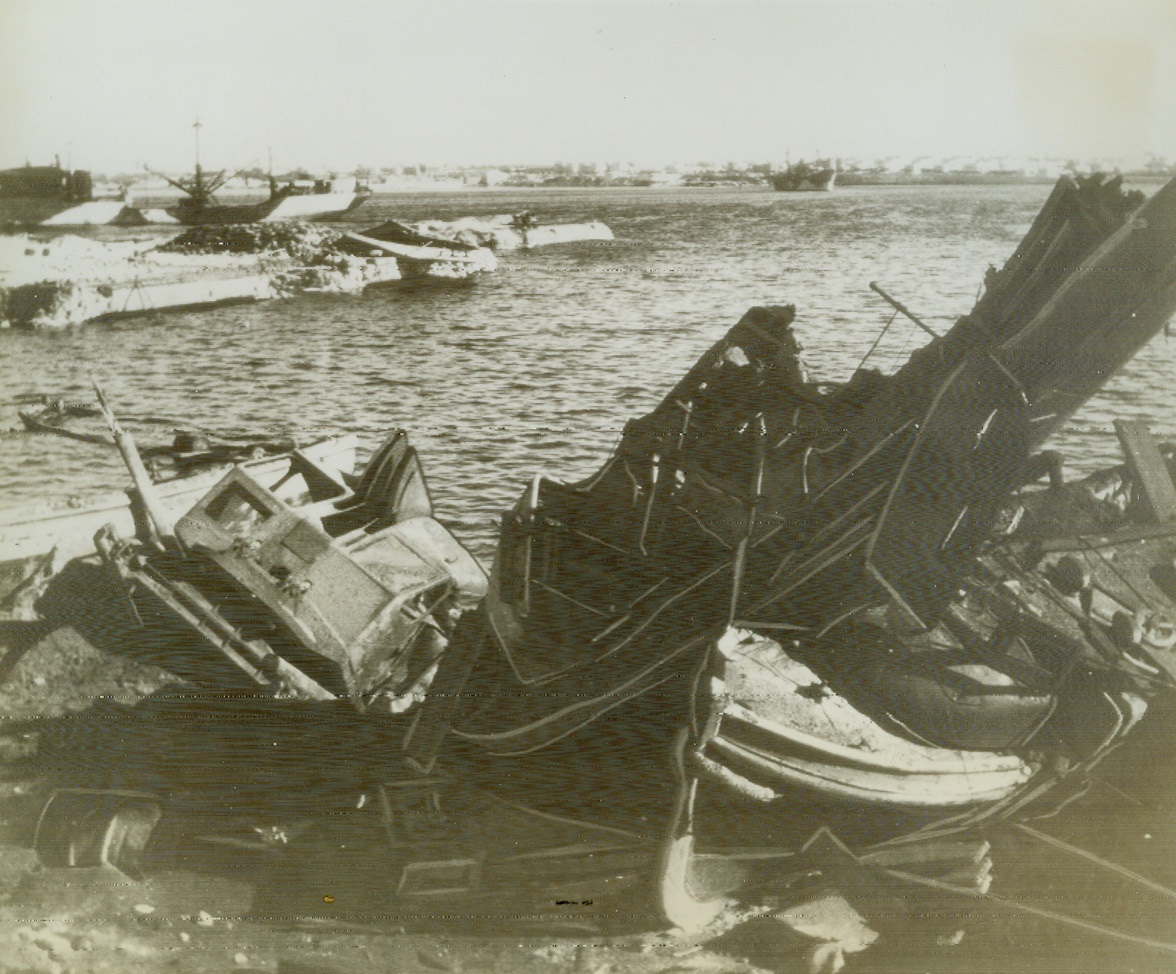
Tripoli Harbor, 1/27/1943. Tripoli – As General Montgomery’s triumphant 8th Army marched into Tripoli, they saw the damage Allied bombers had done to that city’s harbor, pounding relentlessly from the air at the axis-held harbor. Credit line (ACME radio photo);

Bren Gunners Hold Hill Top in Tunisia, 1/7/1943. Mateur, Tunisia - - British Bren gunners hold hill top position near Mateur, during recent heavy fighting between axis and allied forces. Mateur, was first taken by United Nations troops, then later recaptured by the Germans. Credit line (ACME);
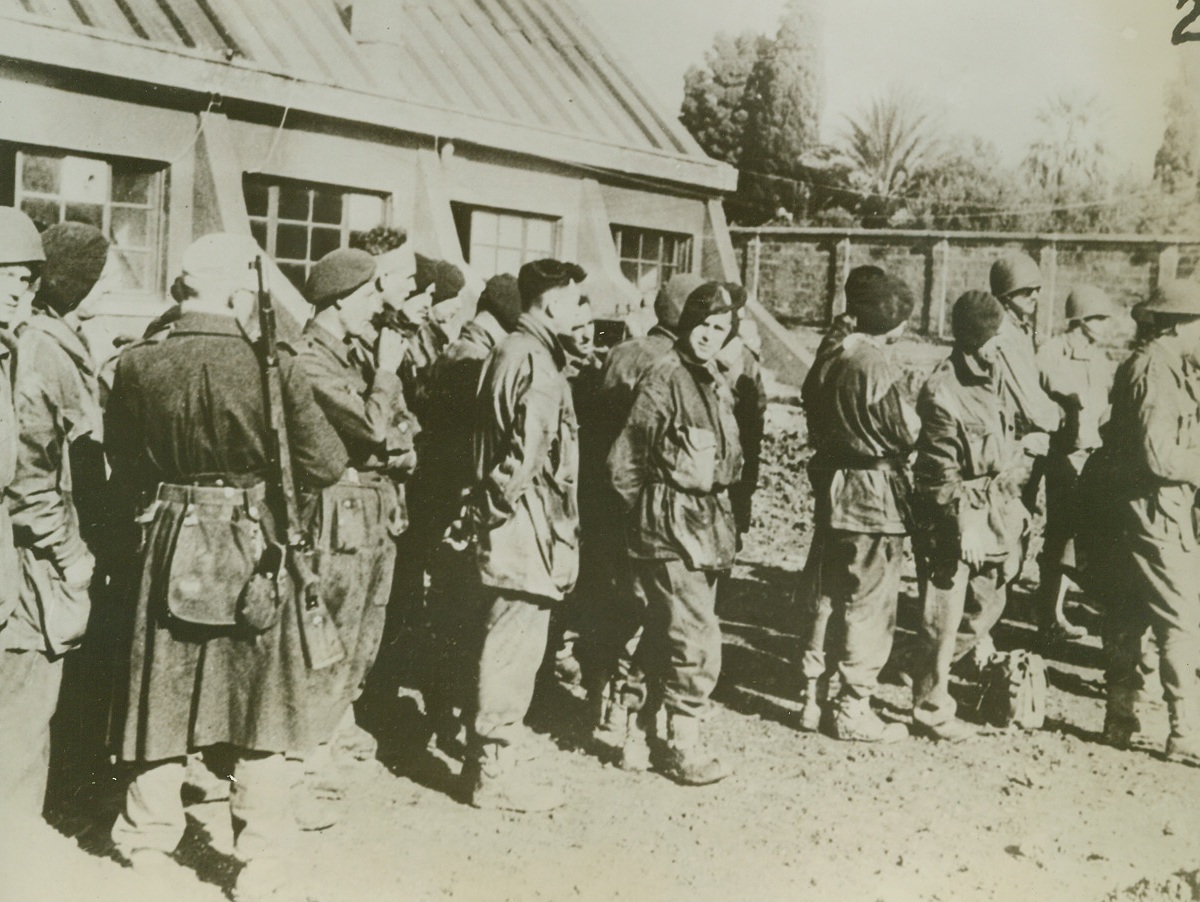
Our Boys --- Prisoners, 1/9/1943. Somewhere in Tunisia – A group of American and British prisoners wait, under guard, to be taken back to rear positions. They were captured during fighting in Tunisia. Photo was received through neutral sources in Portugal. Latest reports indicate that the Nazi’s are shifting command on the Tunisian front, and that Major General Walther Nehring has bee superseded by General Von Arnim as Commander-in-Chief of axis forces there. Credit line (ACME);
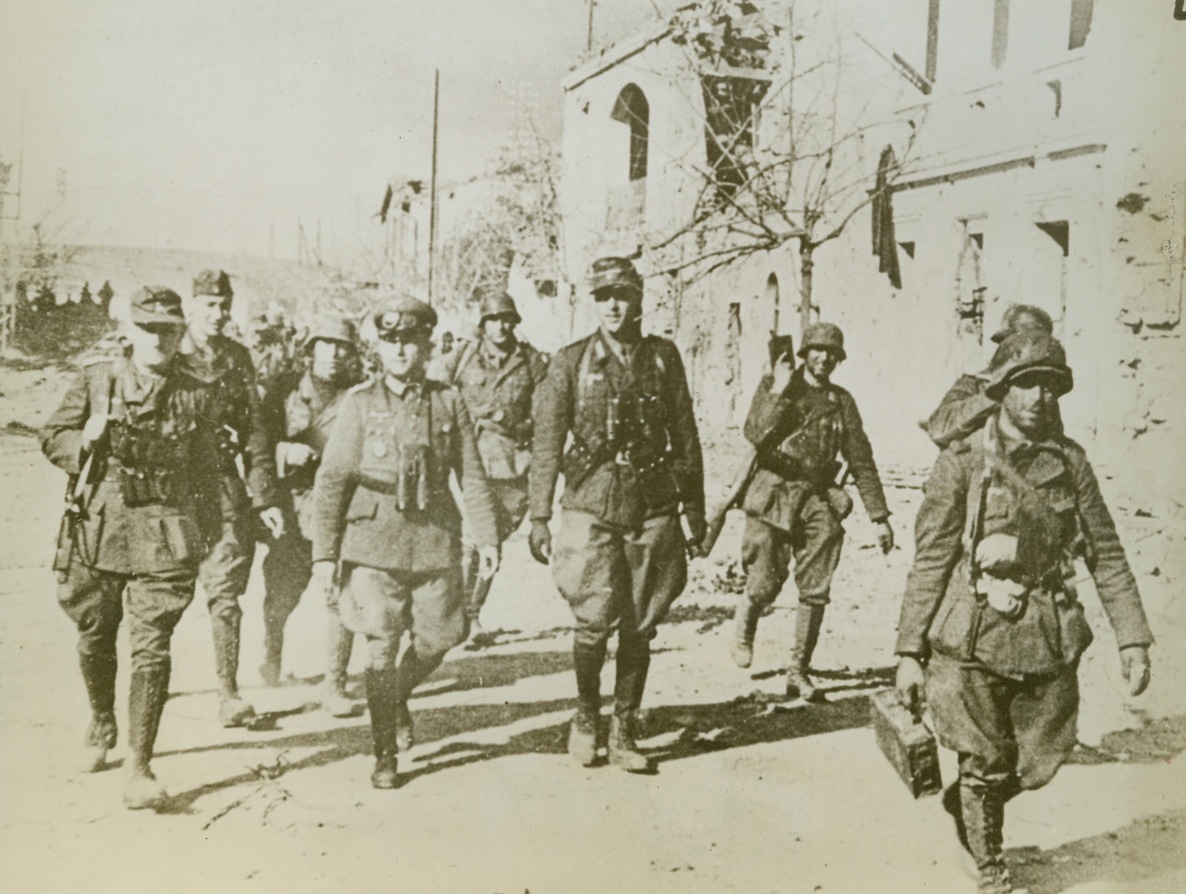
After the Battle, 1/9/1943. Tebourba, Tunisia – A German Panzer General and his staff walk through the city of Tebourba after engaging American and British troops in a fierce battle in that area. Photo was received through sources in neutral Portugal. Latest dispatches from Tunisia reveal that Allied bombers attacked the Docks at Tunis on the night of Jan. 6-7;
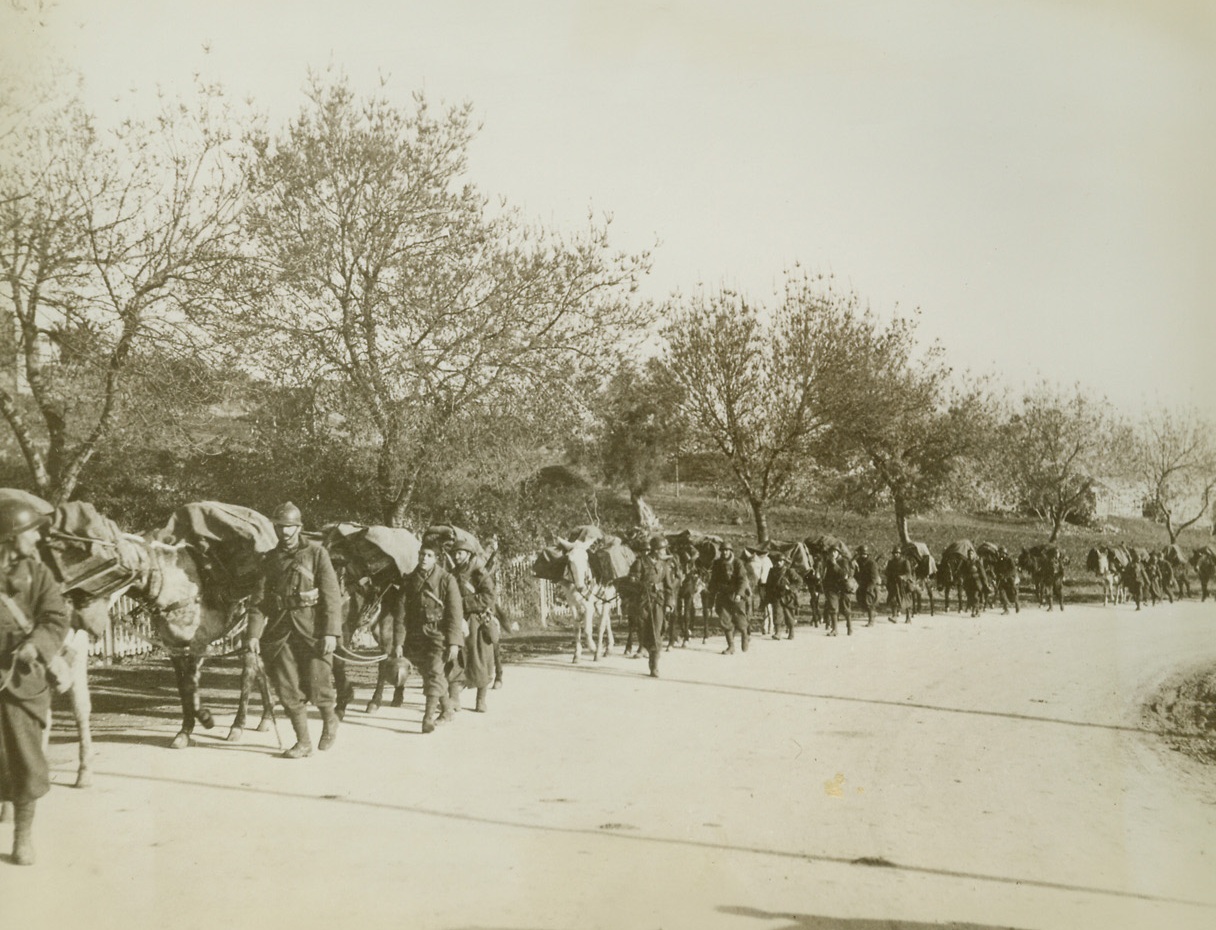
Giraud’s Men Advance, 1/6/1943. Somewhere in Tunisia – French soldiers, fighting under the command of General Henri Giraud, move up to action in Tunisia. Recent reports from the Tunisian front indicate that the allied troops are only 30 miles from Bizerte. The closest they have been since the opening days of the Tunisian campaign. Credit line (ACME);
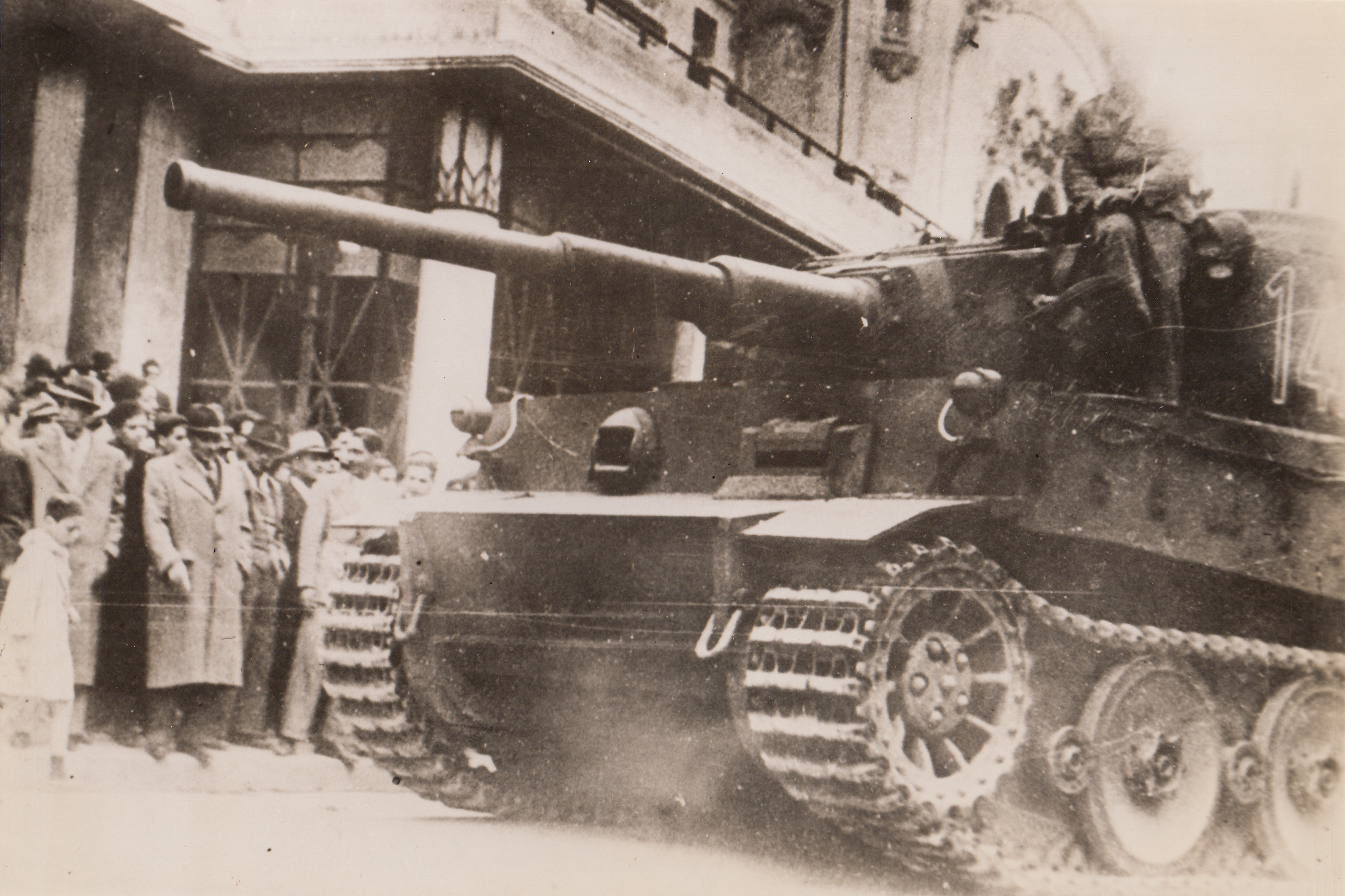
Nazi Tank in Tunis, 1/10/1943. Tunis, Tunisia – Photo, obtained through neutral sources in Portugal, shows a heavy German tank rolling through the streets of Tunis. Latest reports show the Tunisian front indicate that French forces have repulsed a Nazi attack Northwest of Pichon, which is 85 miles Southwest of Tunis.;
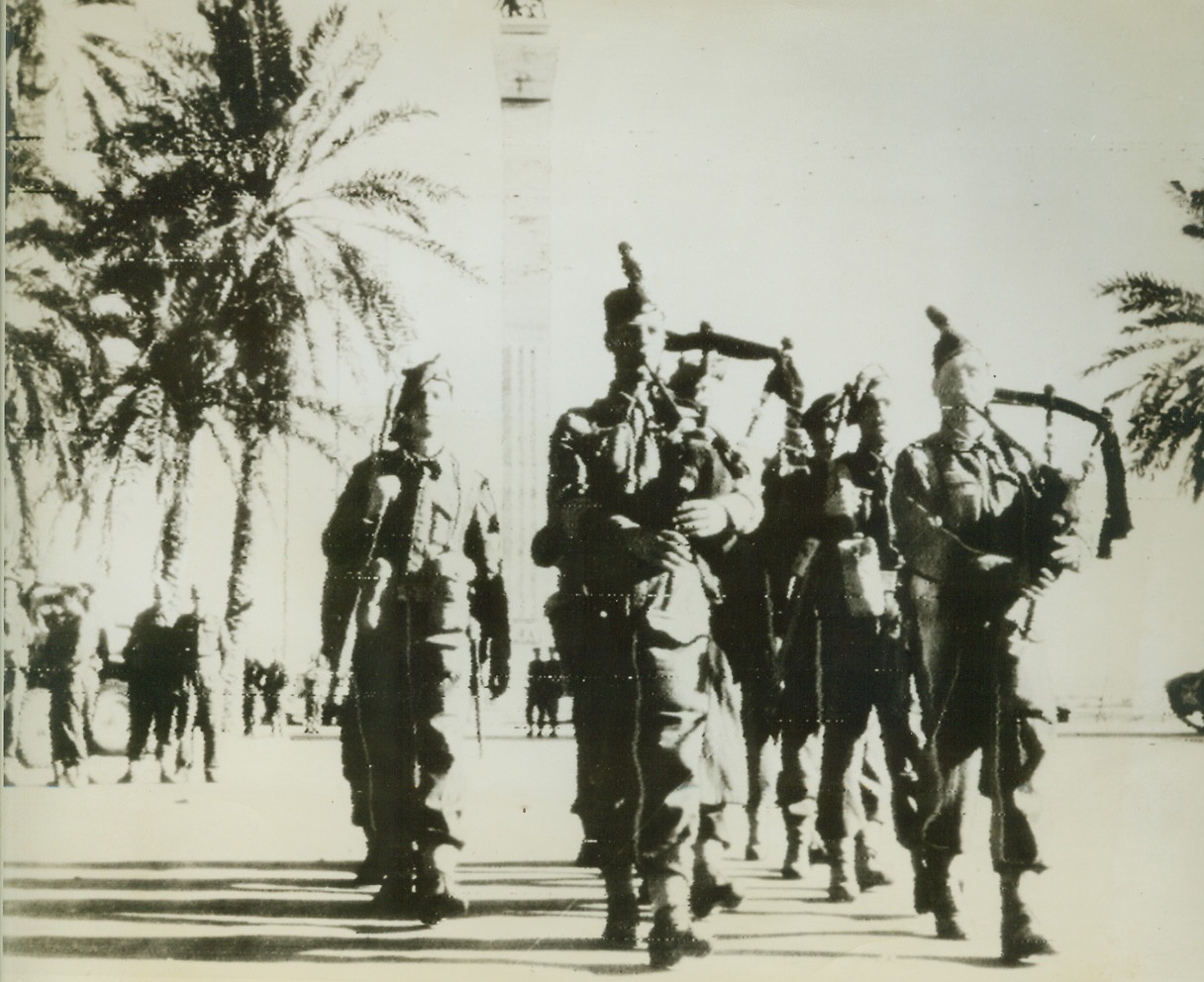
First Photos of Tripoli’s Fall, 1/25/1943. Tripoli—Men of the Gordon Highlanders as they marched into Tripoli with other units of the victorious British Eighth Army, as the once-proud center of Mussolini’s North African Empire was abandoned by German Marshal Rommel’s fleeing Afrika Korps. This photo, transmitted by radio, was one of the first to reach New York after Tripoli’s fall to the Allies. (Passed by censors)Credit: ACME radiophoto;
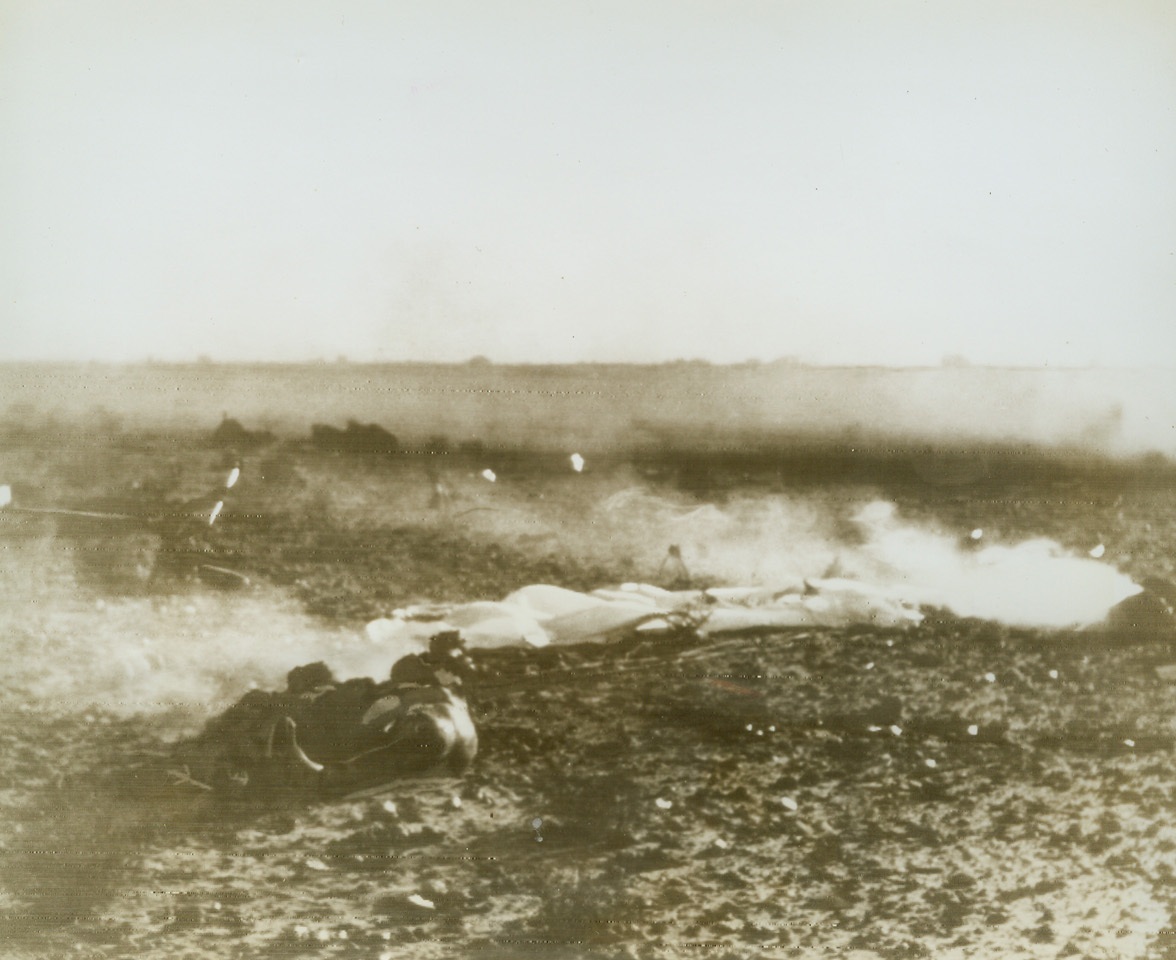
German Pilot’s ‘Chute Didn’t Open, 1/25/1943. North Africa—Radiophoto shows the pilot of a Ju-87 bomber lying dead beside the wreckage of his plane. He hit the ground before his parachute was fully opened after being shot down. Photo flashed from Cairo at noon.Credit: ACME radiophoto;
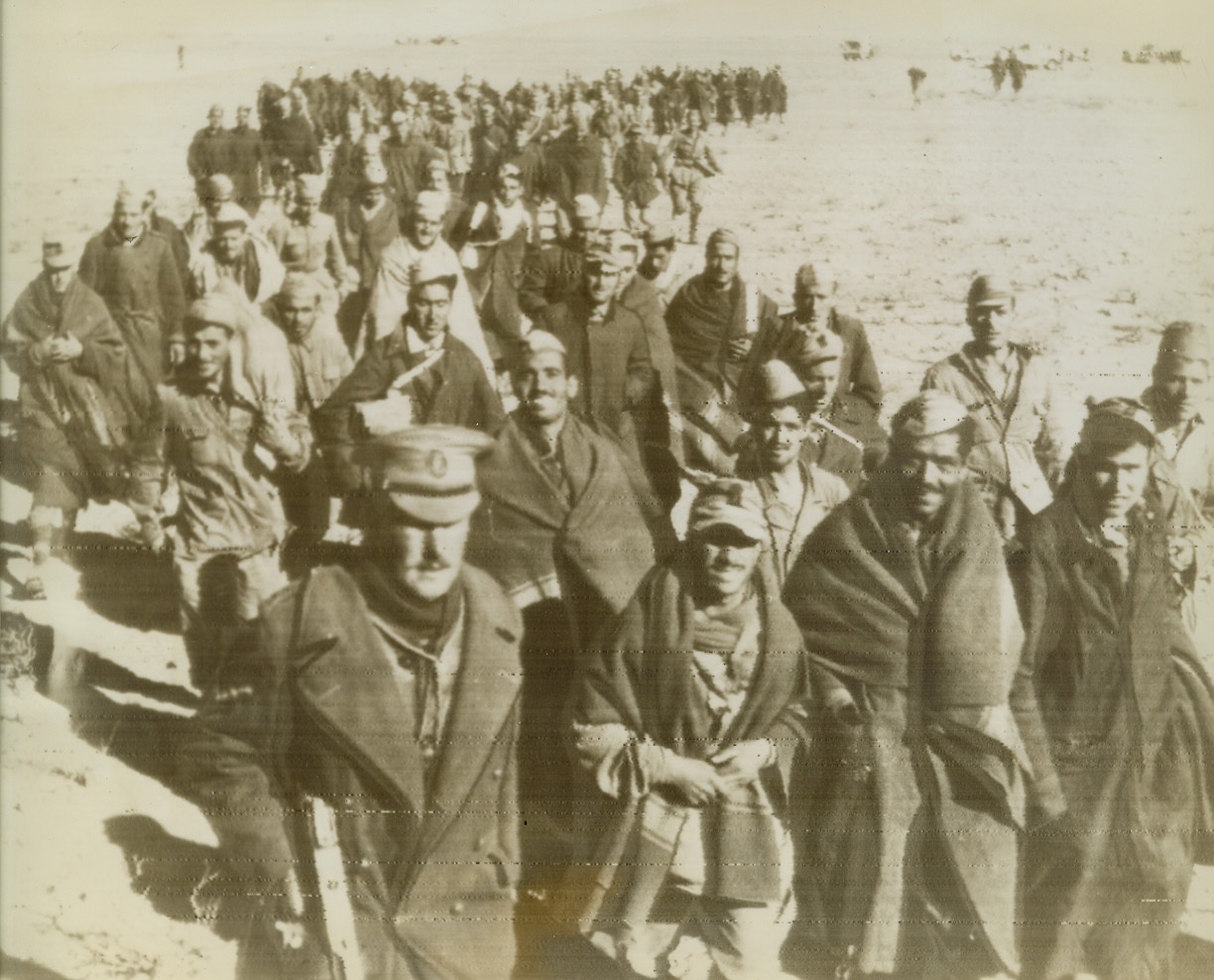
Nazi Prisoners Near Tripoli, 1/25/1943. North Africa—Italians and Germans who were captured near Tripoli are shown being marched back to a waiting transport. Note that the prisoners have been carefully separated, with the Italians in front and the Germans behind. Photo radioed from Cairo at noon today.Credit: ACME radiophoto.;
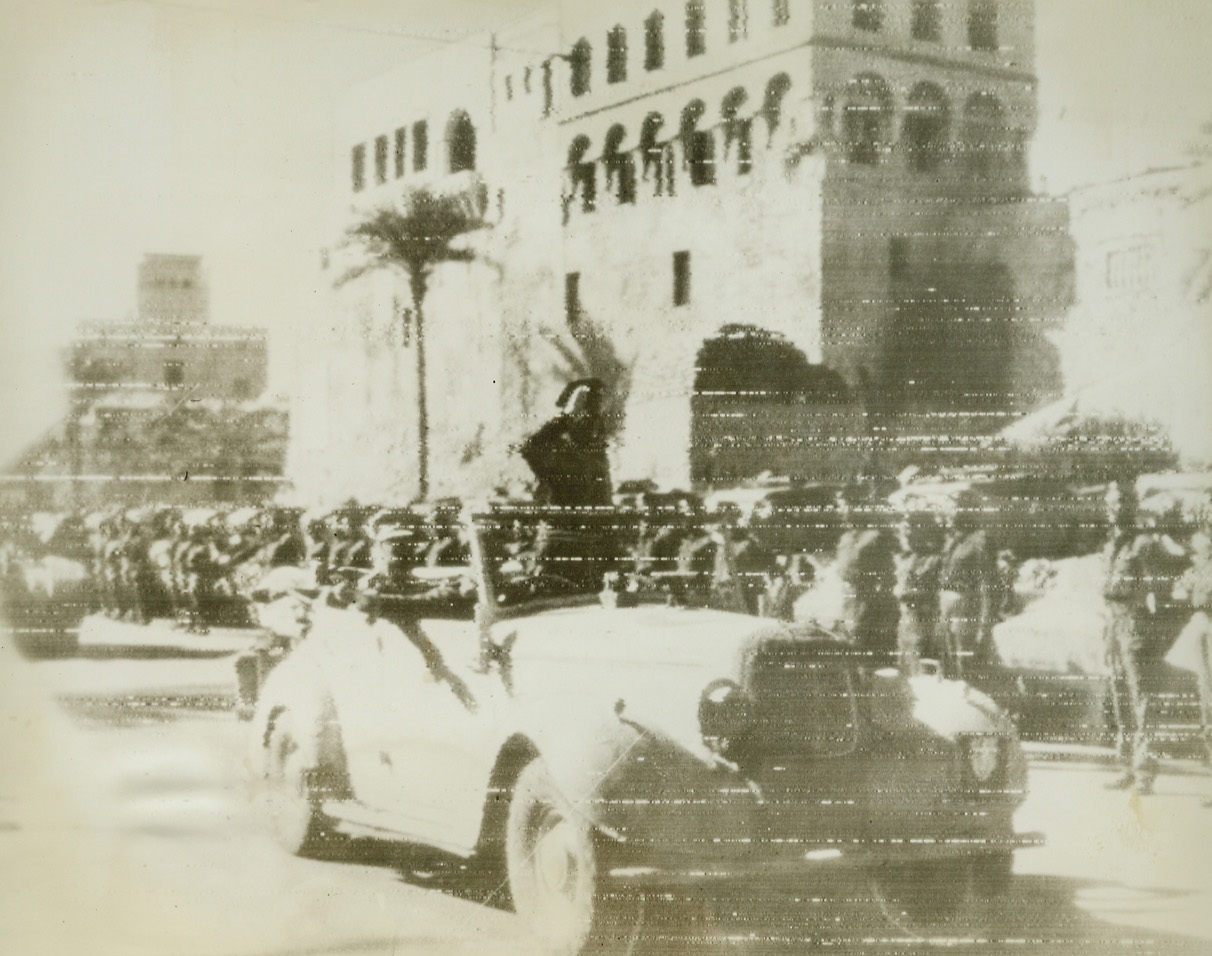
First Photos of Tripoli’s Fall, 1/25/1943. Tripoli—General Bernard L. Montgomery, commanding the British Eighth Army, stands up in the rear seat of his car, to acknowledge the salute of men of the British tank corps after their triumphant entry Tripoli, once proud center of Mussolini’s North African Empire. This photo, received by radio in New York today, was one of the first to be transmitted after Tripoli’s fall to the Allies. Passed by censors.Credit: ACME radiophoto.;
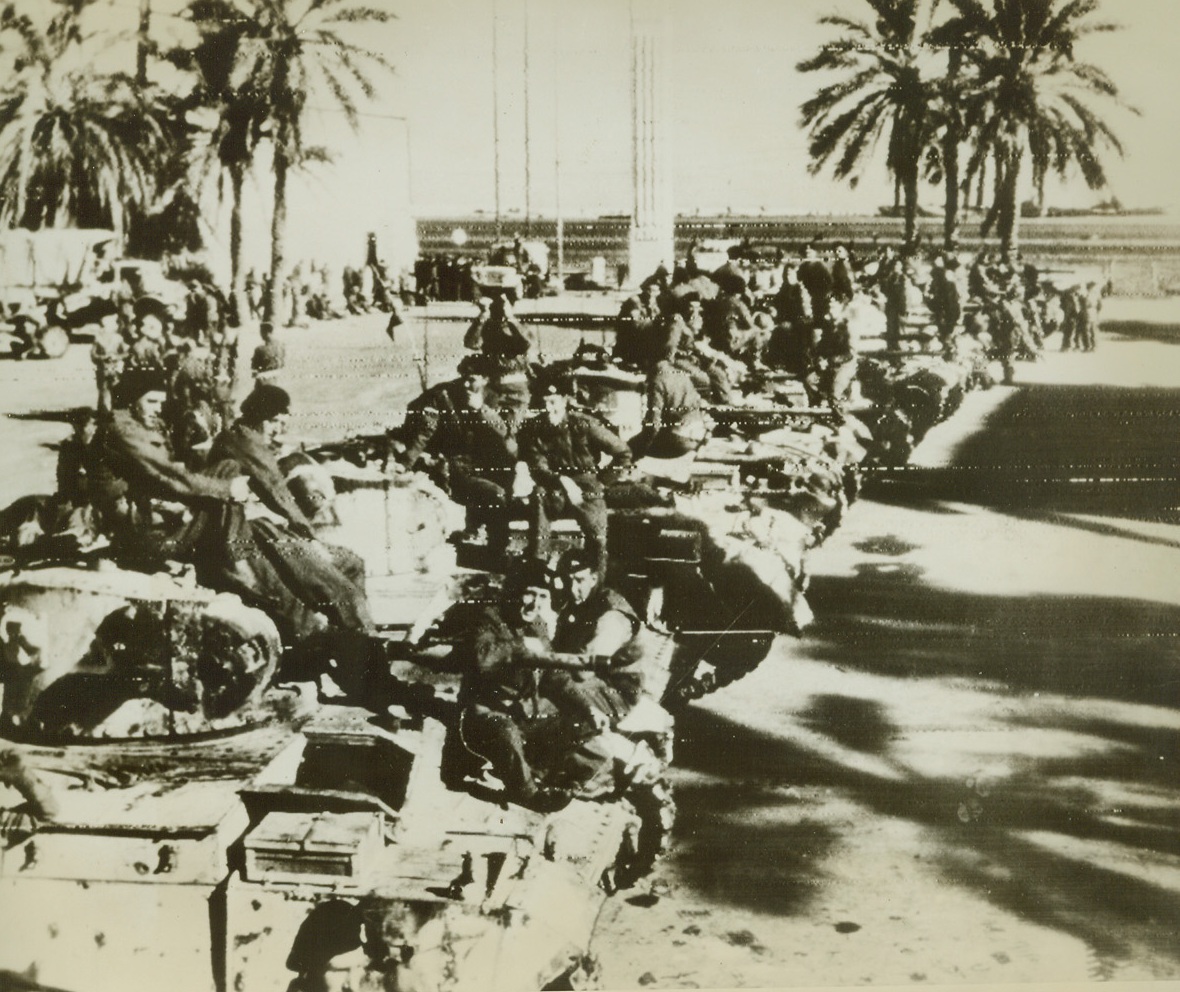
First Photos of Tripoli’s Fall, 1/25/1943. Tripoli—Rows of British Eighth Army tanks are drawn up in the main square of Tripoli, after Allied forces had captured this former Axis stronghold. In the background (photo above), can be seen the harbor. This photo, received by radio in New York today, is one of the first to be transmitted after Tripoli’s fall. Passed by censors.Credit: ACME radiophoto.;
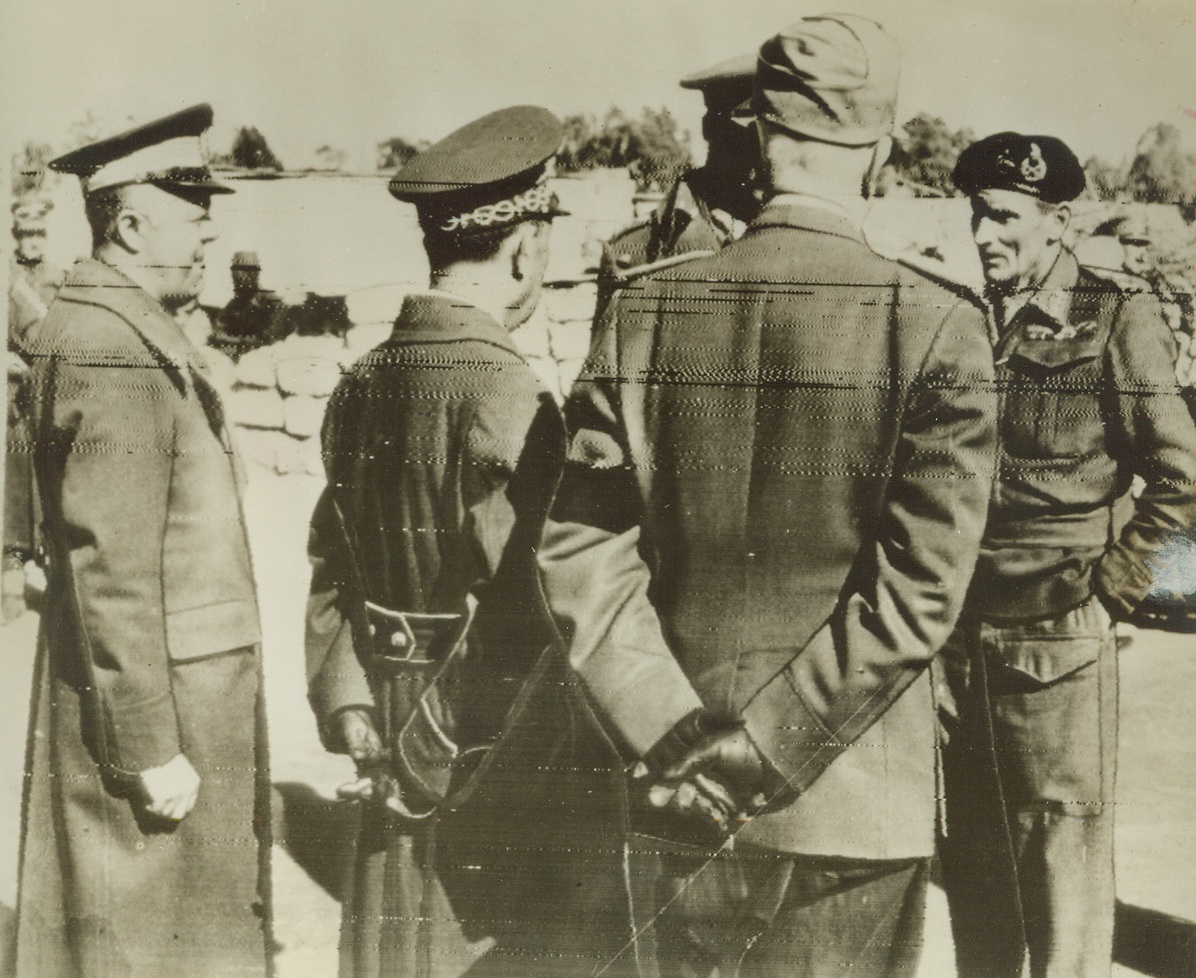
First Photos of Tripoli’s Fall, 1/25/1943, Tripoli—General Bernard L. Montgomery (far right), commanding the British Eighth Army, as he dictated terms to the Governor of Tripoli town and Tripolitania at Castel Benito Gate, as the victorious Allies swept into the once-proud center of Mussolini’s North African Empire. This photo, received by radio in New York today, is one of the first to be transmitted after Tripoli’s fall. (Passed by censors)Credit: ACME radiophoto.;
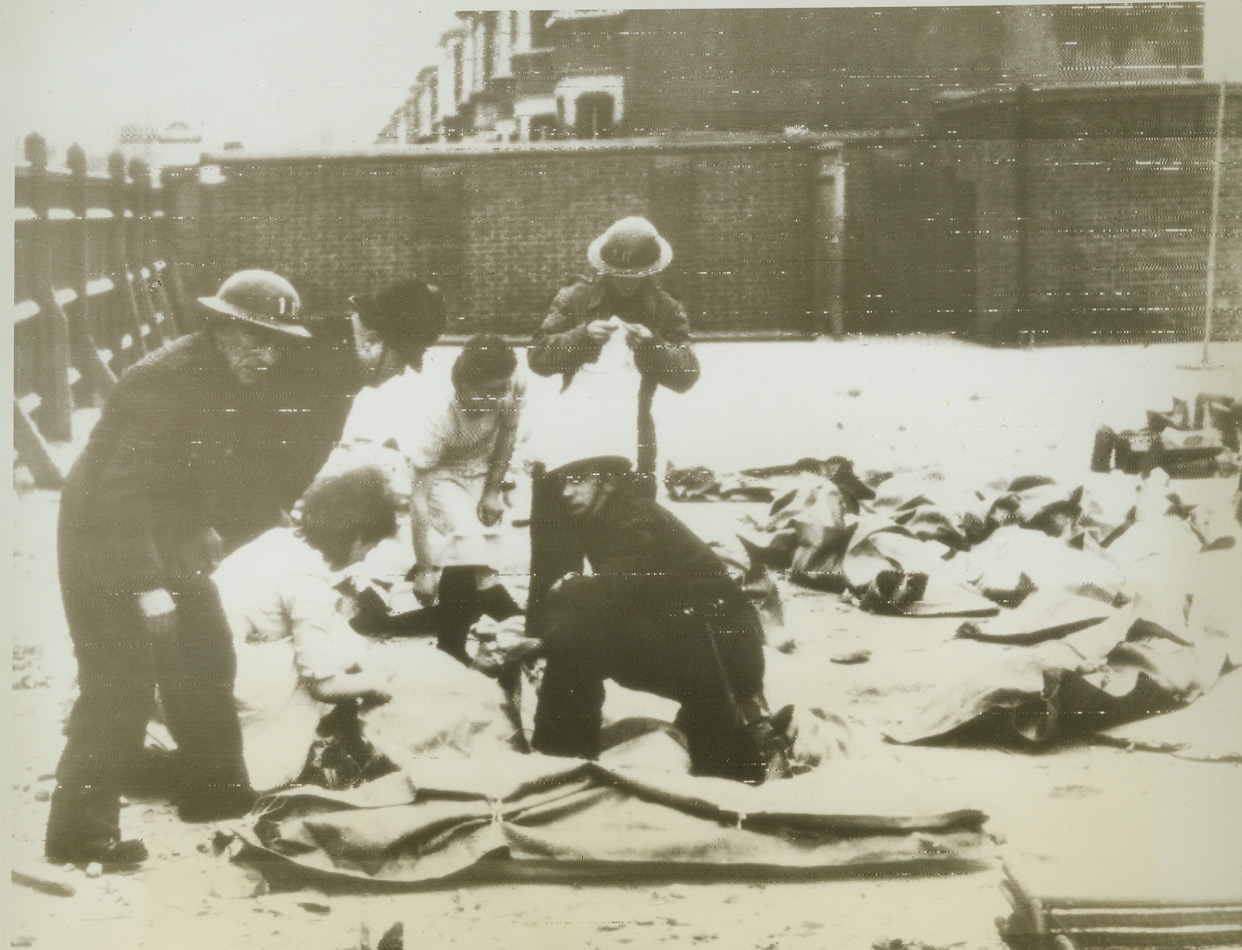

Western Desert—Graveyard for Axis Planes, 1/12/1943. An Axis plane crashes in flames in the desert and Allied soldiers do a speedy bellyflop to escape the far-flung wreckage. Allied troops from east and west continue to stab at the weakened Afrika Korps.Credit: New Zealand Public Relations-ACME.;
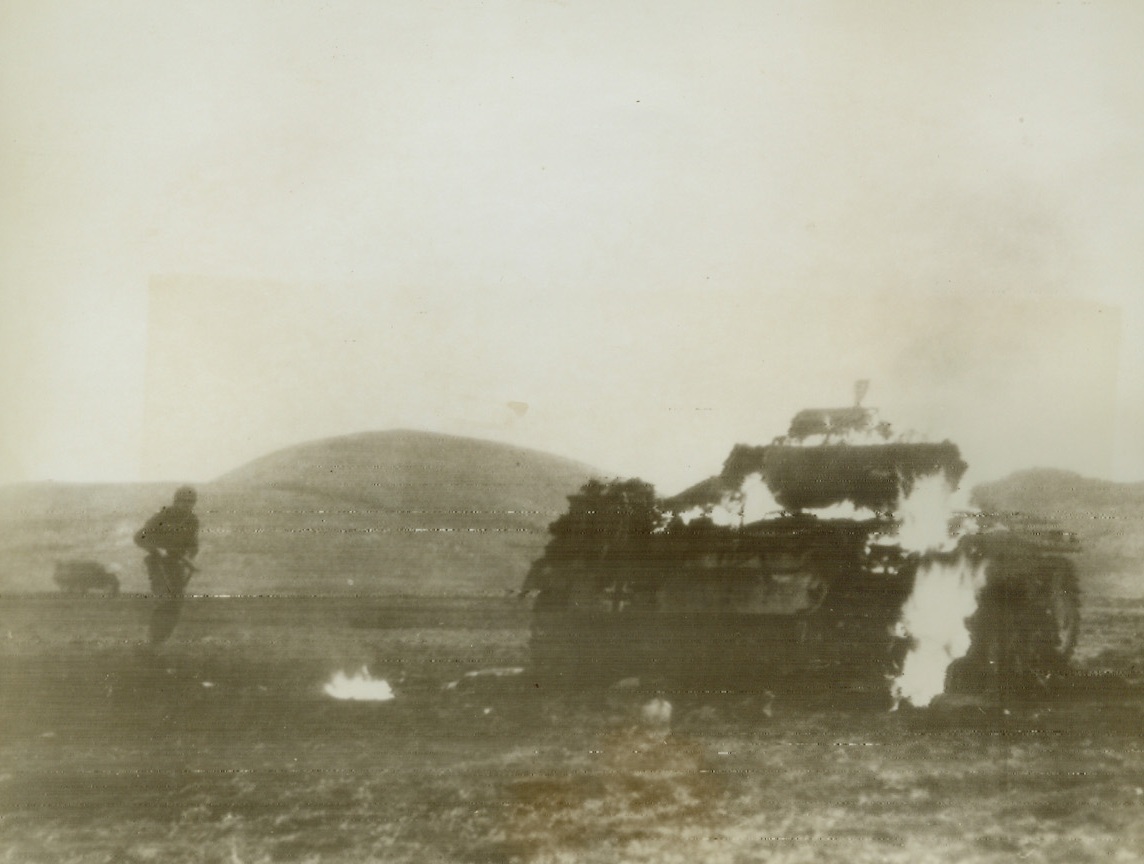
Nazi Tank Comes to “Timely” End, 1/12/1943.Tunisia—An American tommy-gunner runs toward a burning German tank, ready to capture any Nazis who might escape the fiery death, after a duel with Allied anti-tank units near Med Jez El Bab. Latest reports indicate the Axis has set up machine gun nests at all available strong points and have honeycombed all vantage points between Med Jez El Bab and Tunis, which the Allies will have to blast out. Photo flashed from London to New York by radio today (Jan. 12).Credit: ACME radiophoto;

Milk for Children of Oran, 1/14/1943. Oran, Algeria—Eager hands reach for cans of condensed milk, as Sgt. Paul Myers, U.S.A., of Missouri, distributes half the milk ration of U.S. troops in Oran to French children living in the North African town, recently occupied by Anglo-American forces. (Passed by censors) Credit: ACME.;
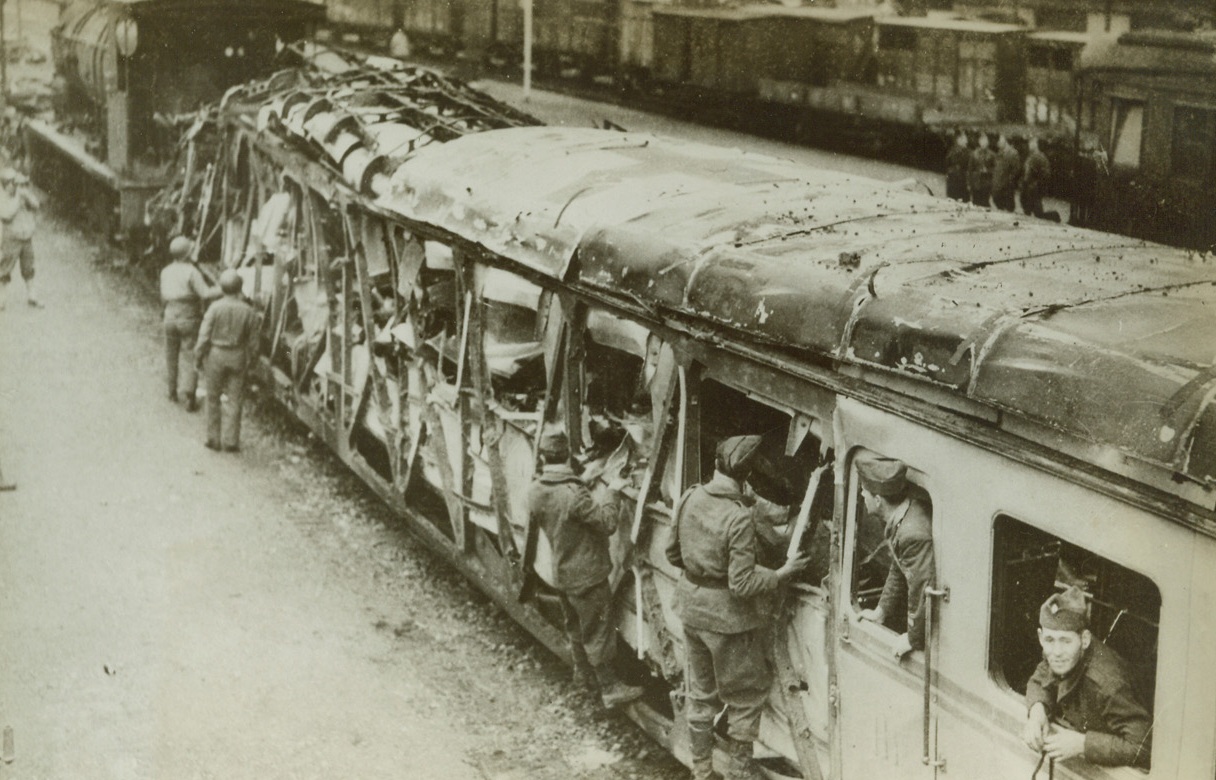
German Planes Blast Red Cross Train, 1/14/1943. Tunisia—Soldiers exam the remains of a Red Cross train which was blasted by German planes in Tunisia, despite the fact that cars were clearly marked on top with Red Cross symbol. Note Red Cross atop cab (top center in photo). (Passed by censors).Credit: ACME.;

Girls Clear London Bomber Debris, 1/18/1943. LONDON - London girls sweep up shattered glass and the slight debris outside of a department store which was damaged during the feeble Nazi aerial atteck on January 17. The Nazis scarcely damaged the British Capital in their weak retaliation for the devastating RAF raids on Berlin.; Photo cabled from London to New York today.; Full DJH; Credit (ACME cablephoto); 1/18/43;
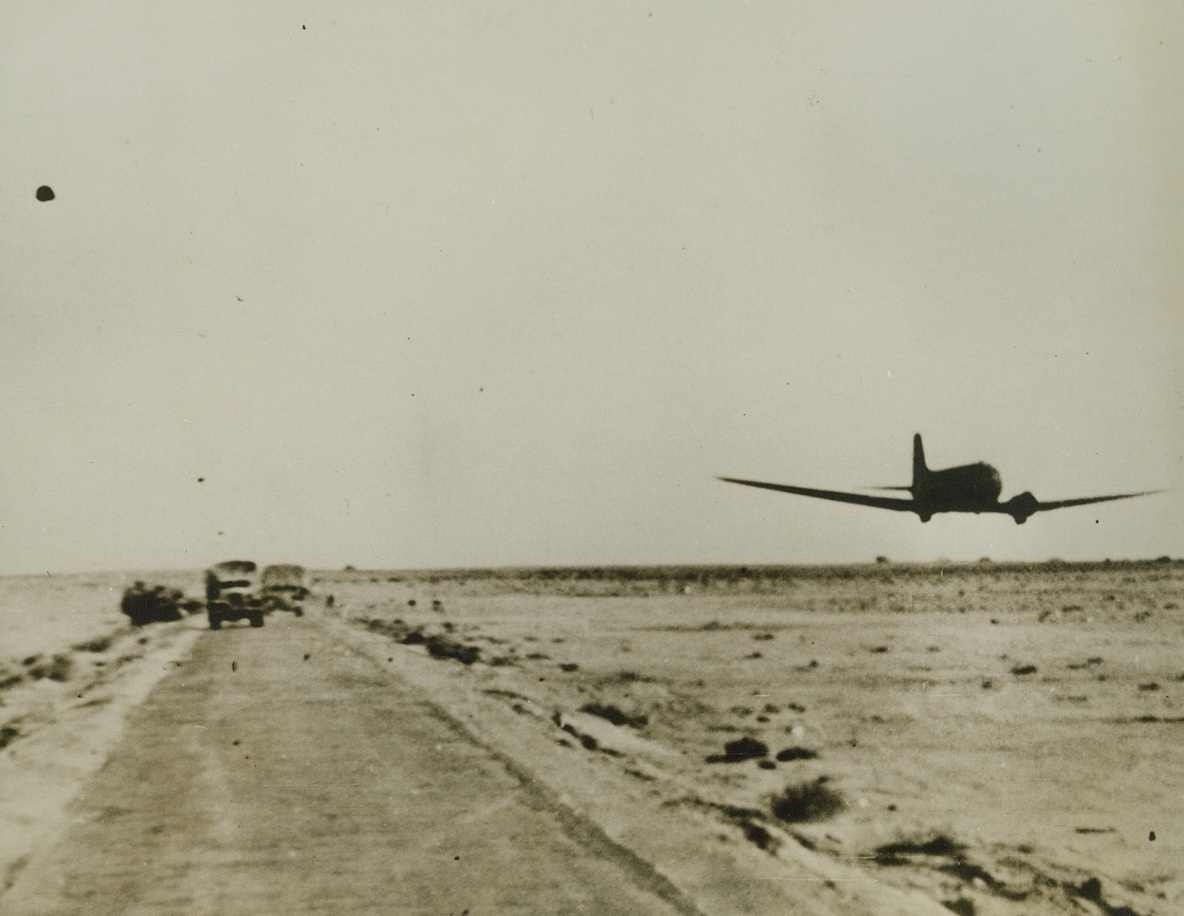
Supplies for the British, 1/23/1943. Tripolitania—A transport plane flies low over a desert road, passing a motor transport convoy as it flies with fuel supplies to RAF landing grounds in Tripolitania. Latest reports from Tripoli indicate that the city has fallen to the British 8th Army. Passed by censor.Credit: ACME;
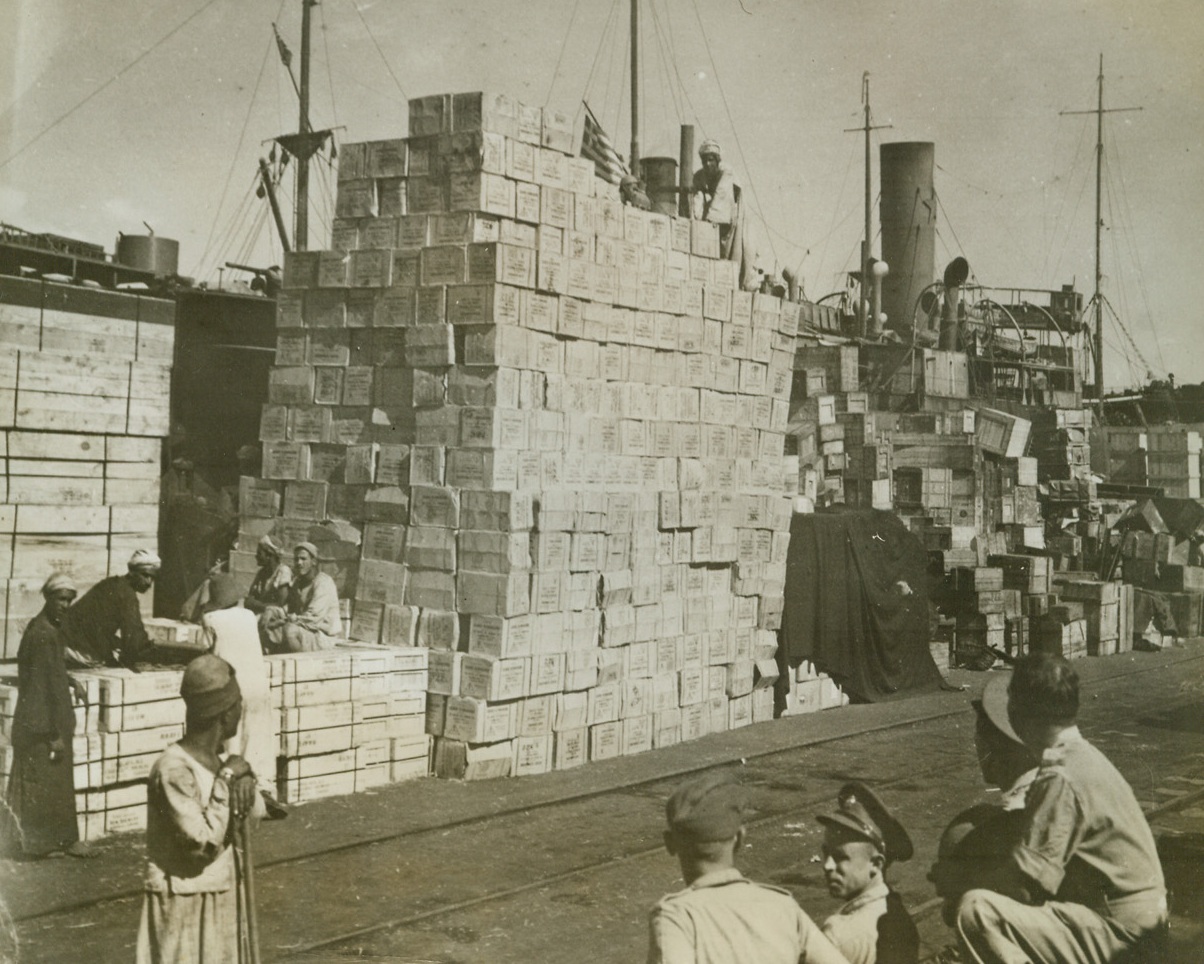
African Foodstuffs in Middle East, 1/19/1943.
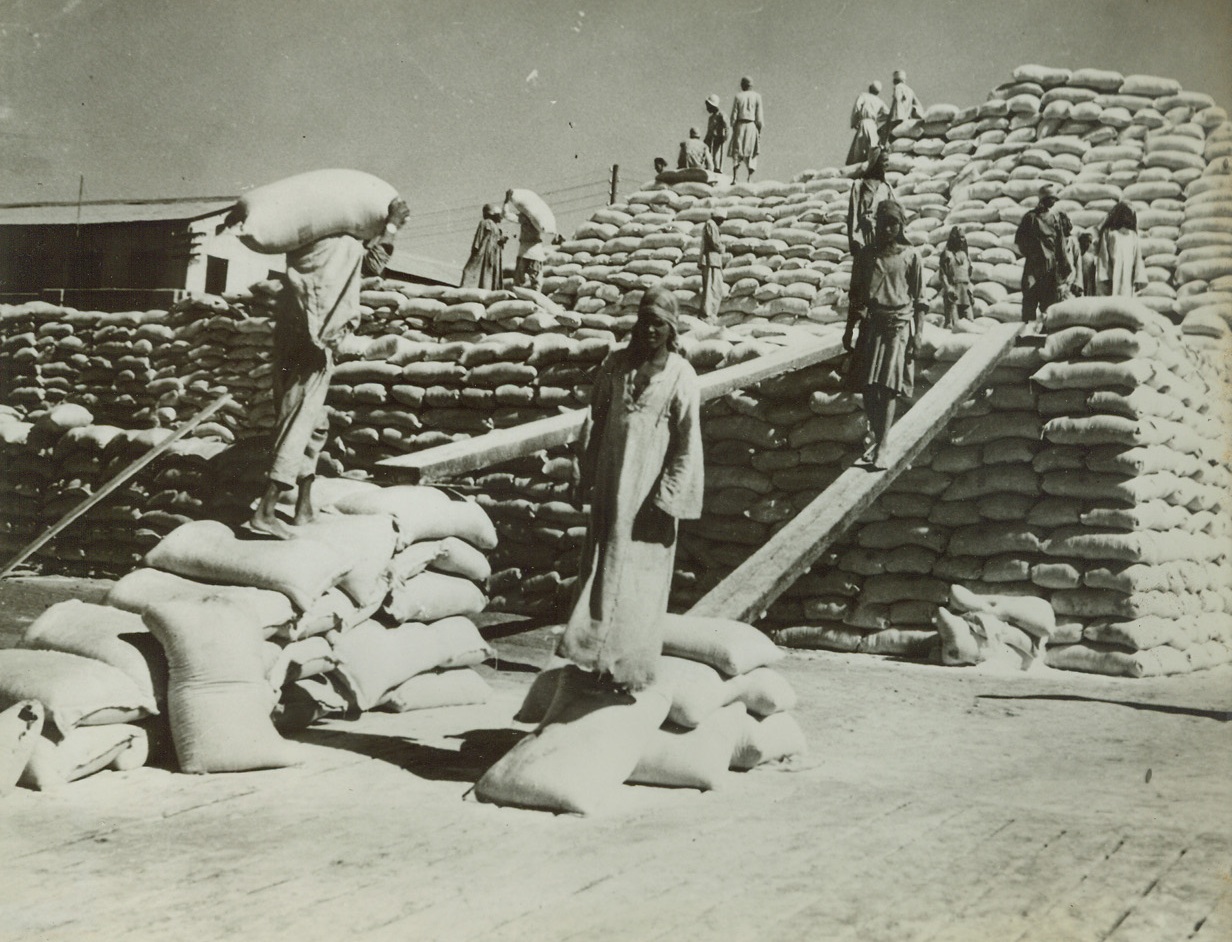
Flour “Mountain” from Australia, 1/19/1943. Natives, including many women, pile bags of flour mountain-high at a port “somewhere in the Middle East.” Flour, which came from Australia, will help to feed hungry United Nations fighters. (Passed by censors).Credit: ACME.;
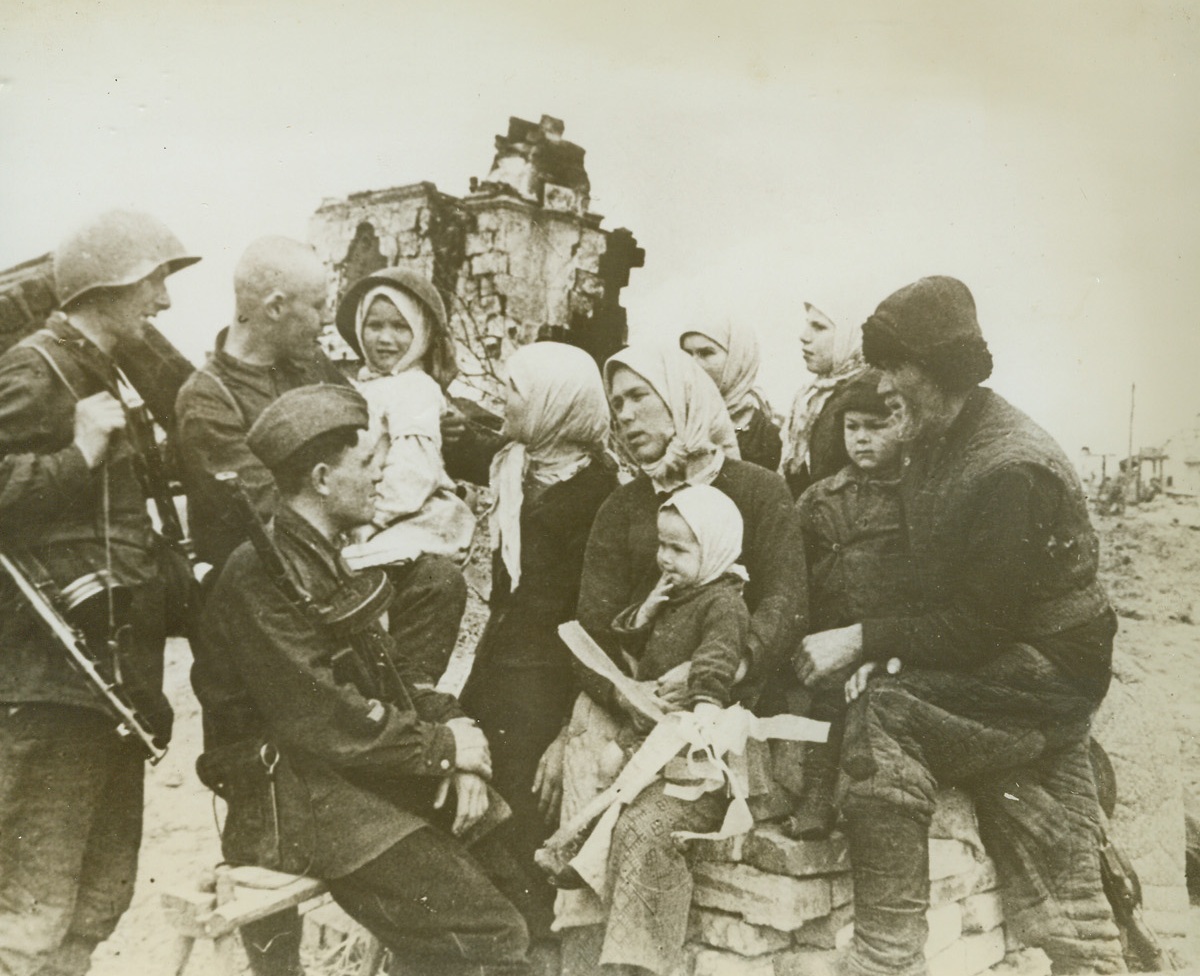
Home-coming Near Stalingrad, 1/18/1943. Russia—The sufferings of war written on their faces, survivors of families occupying a collective farm to the northwest of Stalingrad tell of their experiences after their village had been recaptured by Russian advance troops. Credit: ACME.;
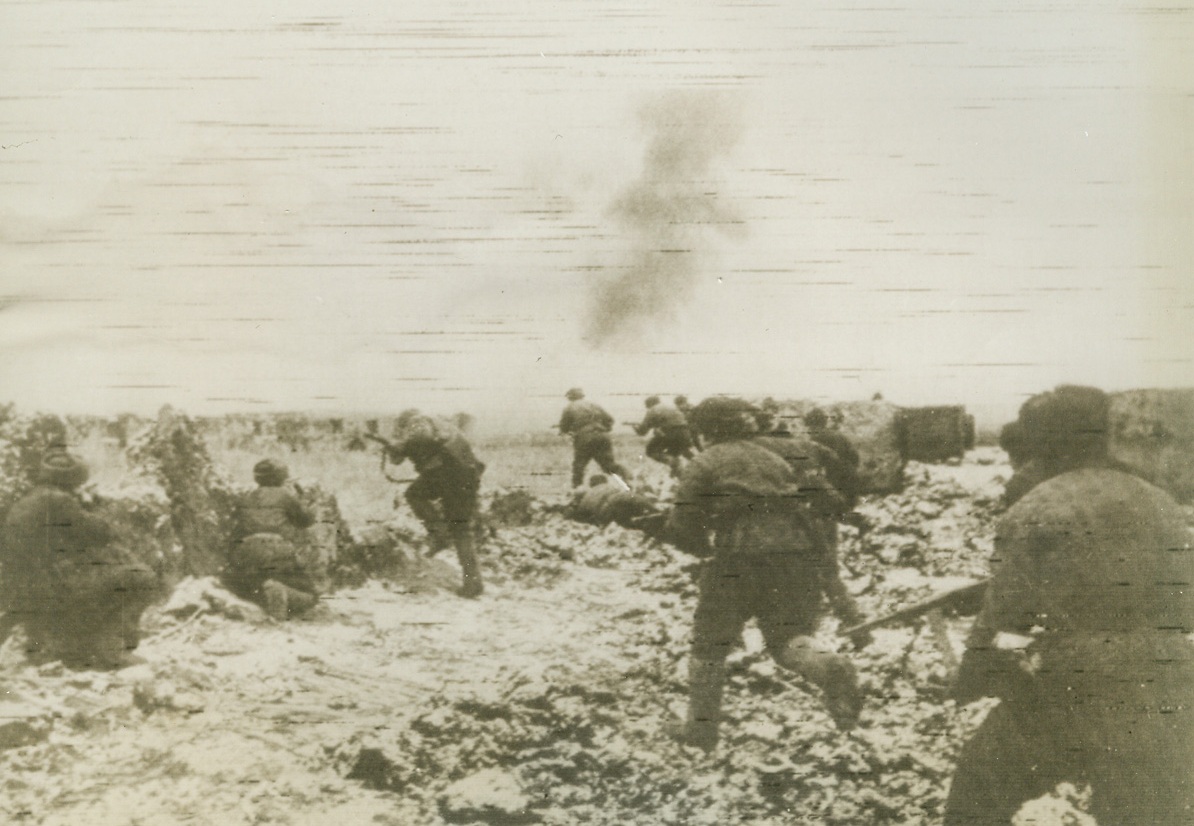
Reds Rout Nazis South of Stalingrad, 1/18/1943. Stalingrad—Under heavy fire, Red guardsmen dislodge the enemy from Formossin, south of Stalingrad. During the night, one Russian unit slew 1,000 Nazis in the Stalingrad area, capturing 850 others while in the last 48 hours 3,000 enemy soldiers are reported either killed or captured in the same territory. Credit: ACME.;
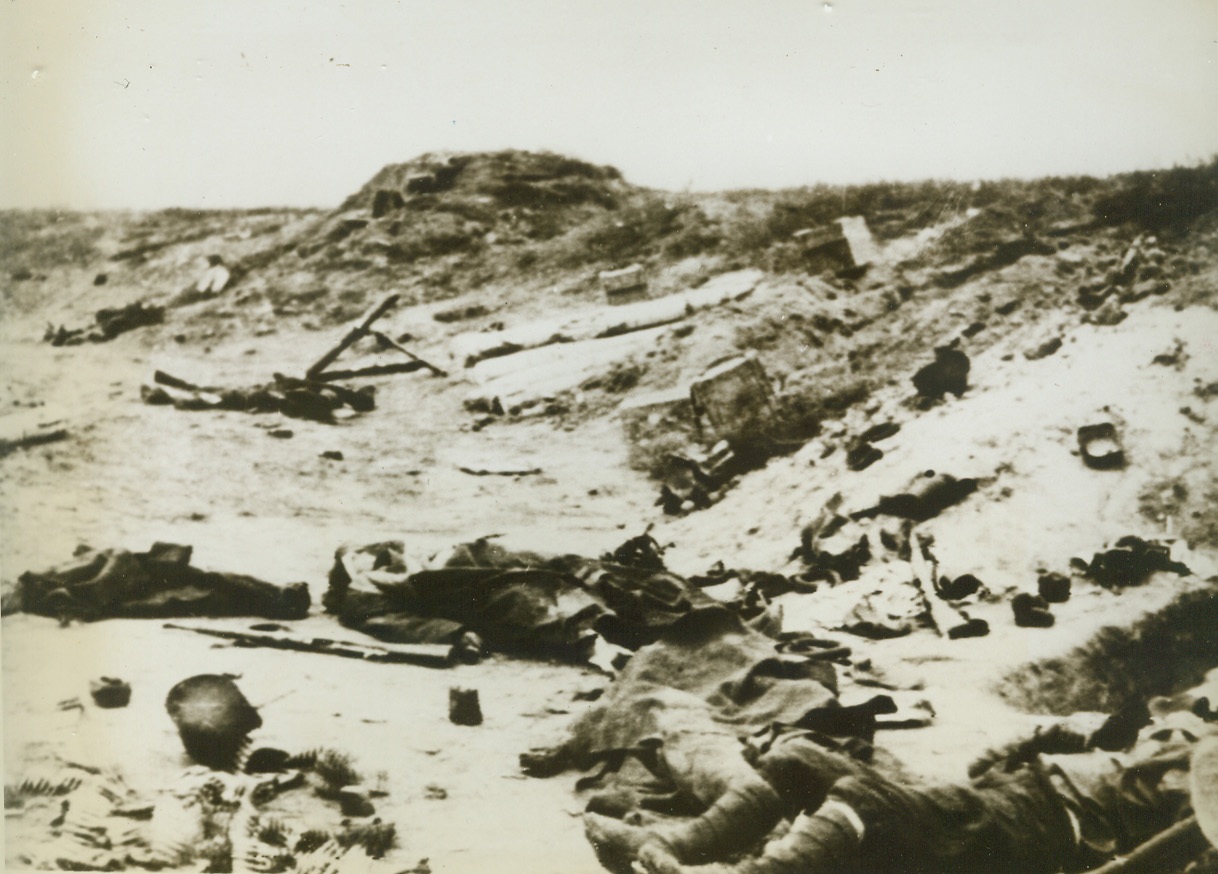
Dead Nazis in Stalingrad, 1/17/1943. Stalingrad, U.S.S.R.—Strewn on the battlefield southwest of Stalingrad, these dead Nazis once manned part of the enemy’s heavily fortified lines. They were left here by their comrades after the Red Army broke through their lines. Latest reports from the Russian front indicate that the Red Army has captured the important German base and railroad junction of Millerovo, 125 miles north of Rostov, almost annihilating a Nazi garrison. Passed by censor. Credit: ACME.;
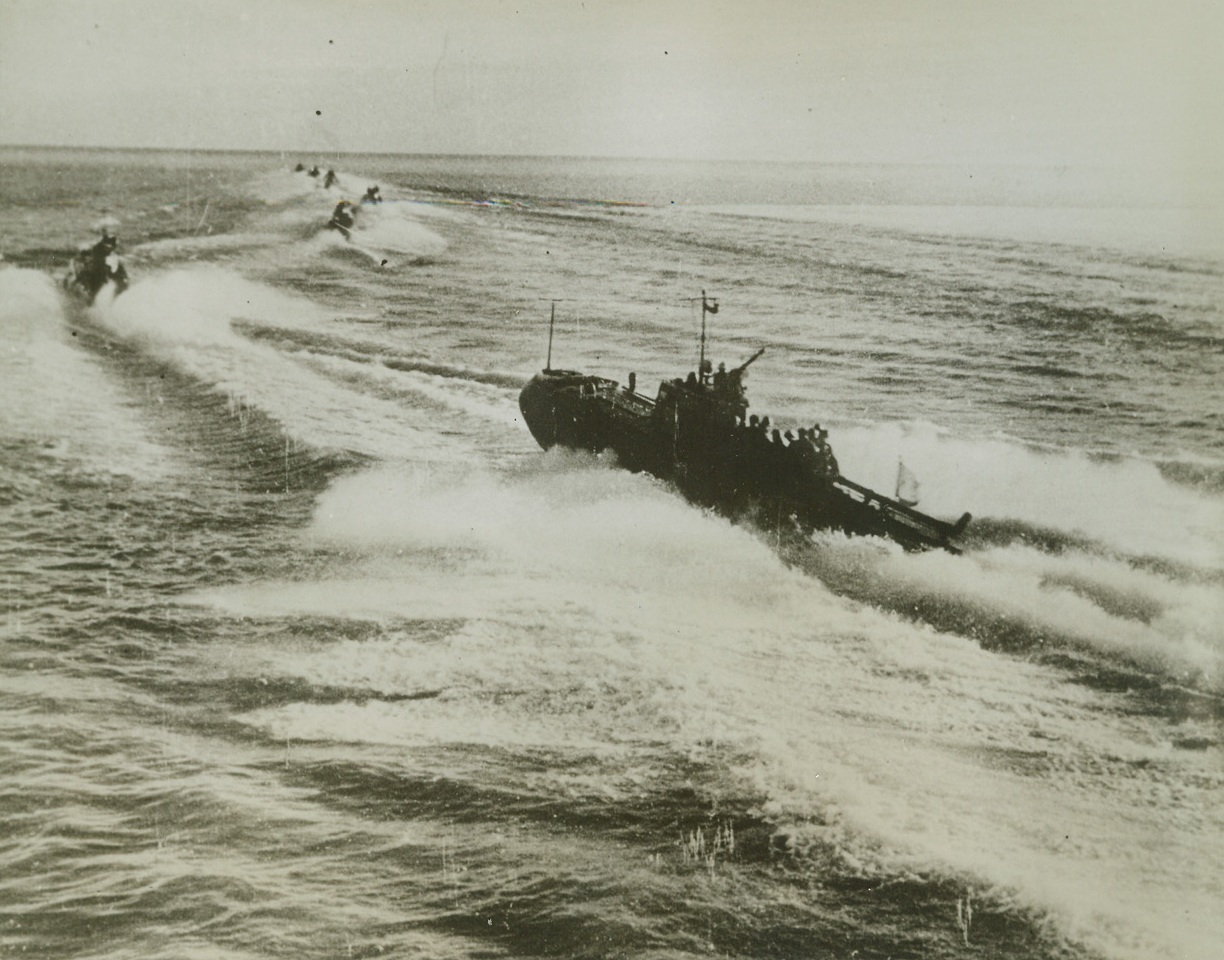
On Sea as on Land, 1/14/1943. SOMEWHERE ON THE RUSSIAN COAST - With the news of Russia's land offensive looming large on the war news horizon, very little attention has been given to Russian offensive on the seas surrounding her coast. Photo shows torpedo boats setting out-on a fighting assignment from their base. Latest reports from the Sovient front indicate that Red Army forces have broken through a gap in Nazi defenses in the lower Don sector.;
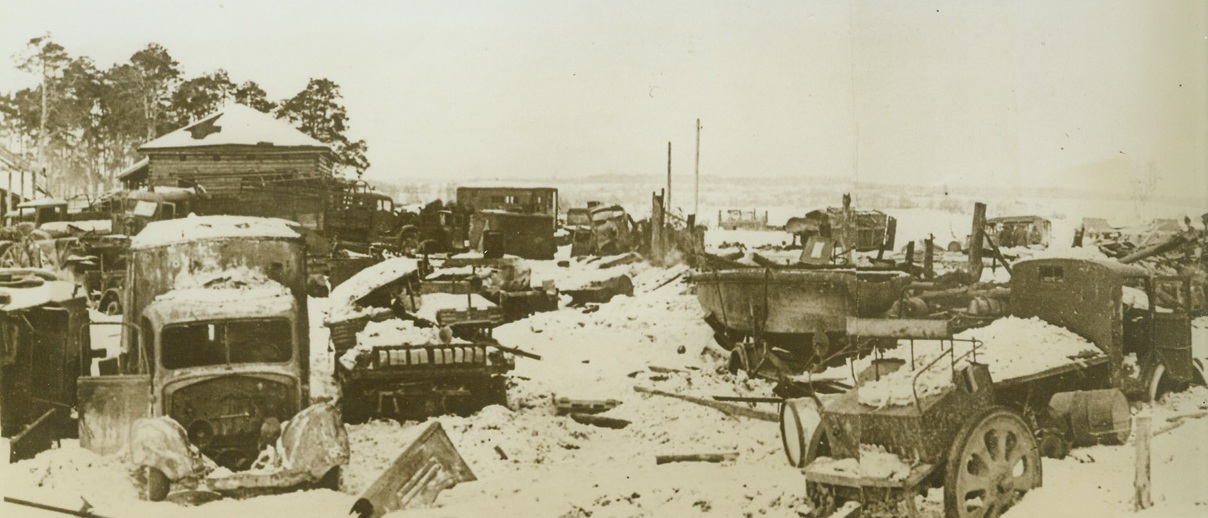
Graveyard of Axis Vehicles, 1/14/1943. STALINGRAD FRONT - This huge scrap pile is all that remained of a German transport column, smashed by Russian forces northwest os Stalingrad. Dispatches today indicate that a gap has been forced in German defenses in the lower Don sector, and that Red troops are pouring through the breach.;
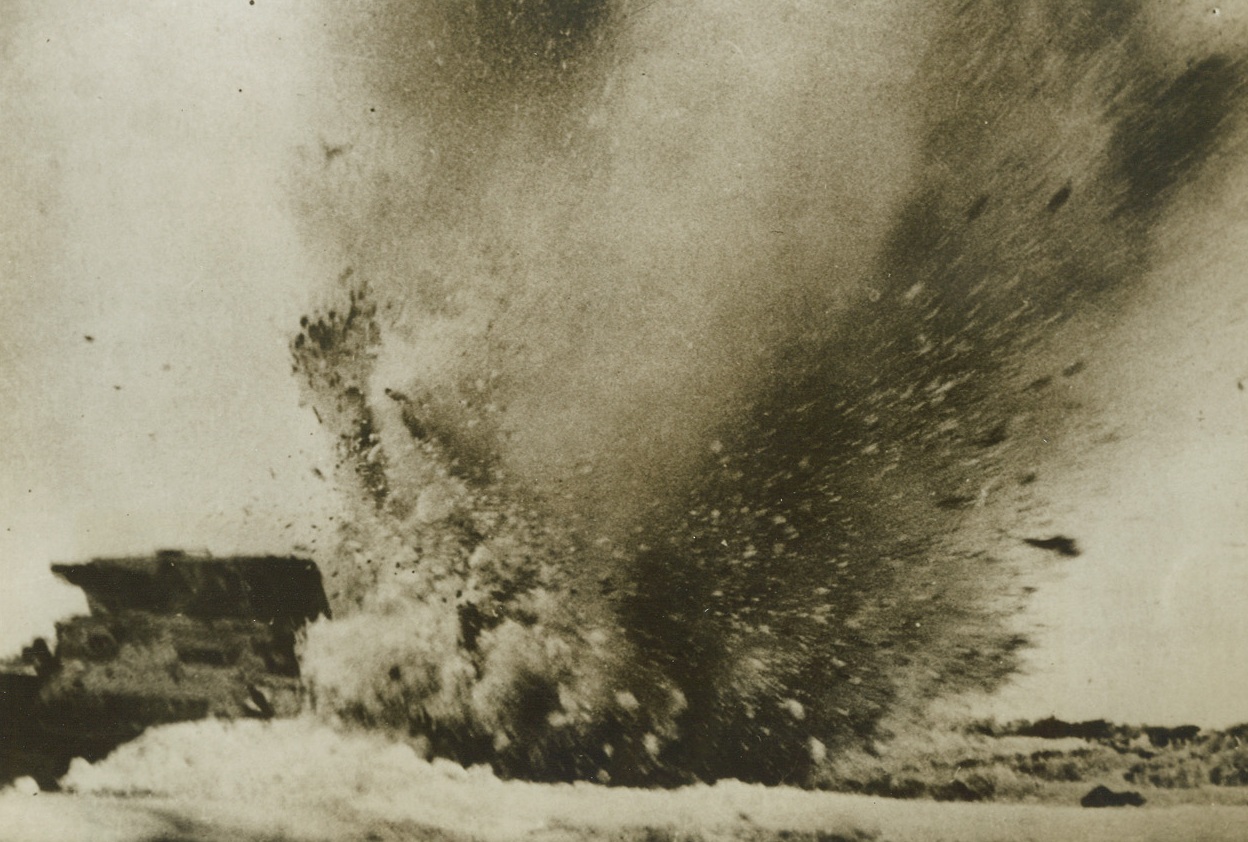
Big Boom, 1/6/1943. Voronezh, U.S.S.R.—A Nazi tank touches off a mine laid by the Russians during a German counter-attack in advanced Russian troops in the Voronezh area and—BOOM! Photo was made as the tank scattered in a million pieces on the battlefield. Latest reports from the Soviet front indicate that the Axis is in disorderly retreat from the north Caucasus area and that the Red Army has bagged 26,500 more Nazis. Passed by censor. Credit: ACME.;

Picnic of Revenge, 1/4/1943. Kalinin Region, Russia—Soviet women and children live a communal life on the blasted battleground where their homes once stood in a village in the Zurtsov area of the Kalinin Region. Russian troops have driven out the Nazis, but the wreckage of war remains where families live in German dugouts and swear revenge. Credit: ACME.;
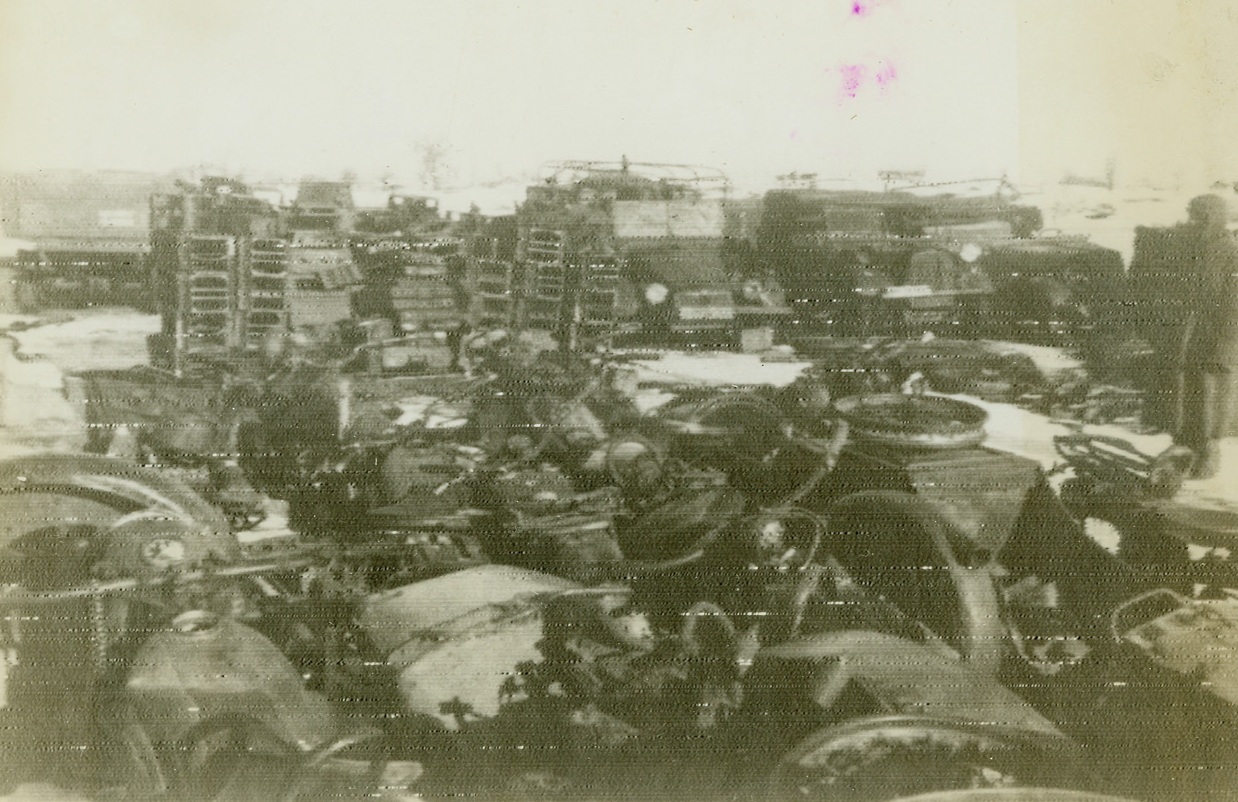
Soviet Advance Captures Nazi Equipment, 1/3/1943. Northwest of Stalingrad—Nazi equipment, littering the ground northwest of Stalingrad, is a symbol of Soviet victory. To the southwest of the city-battleground, the advancing Reds have captured several more German strongholds. On all Soviet fronts, the Nazis are the underdogs, futilily attempting to stop terrific Russian onslaughts. Credit: ACME radiophoto.;
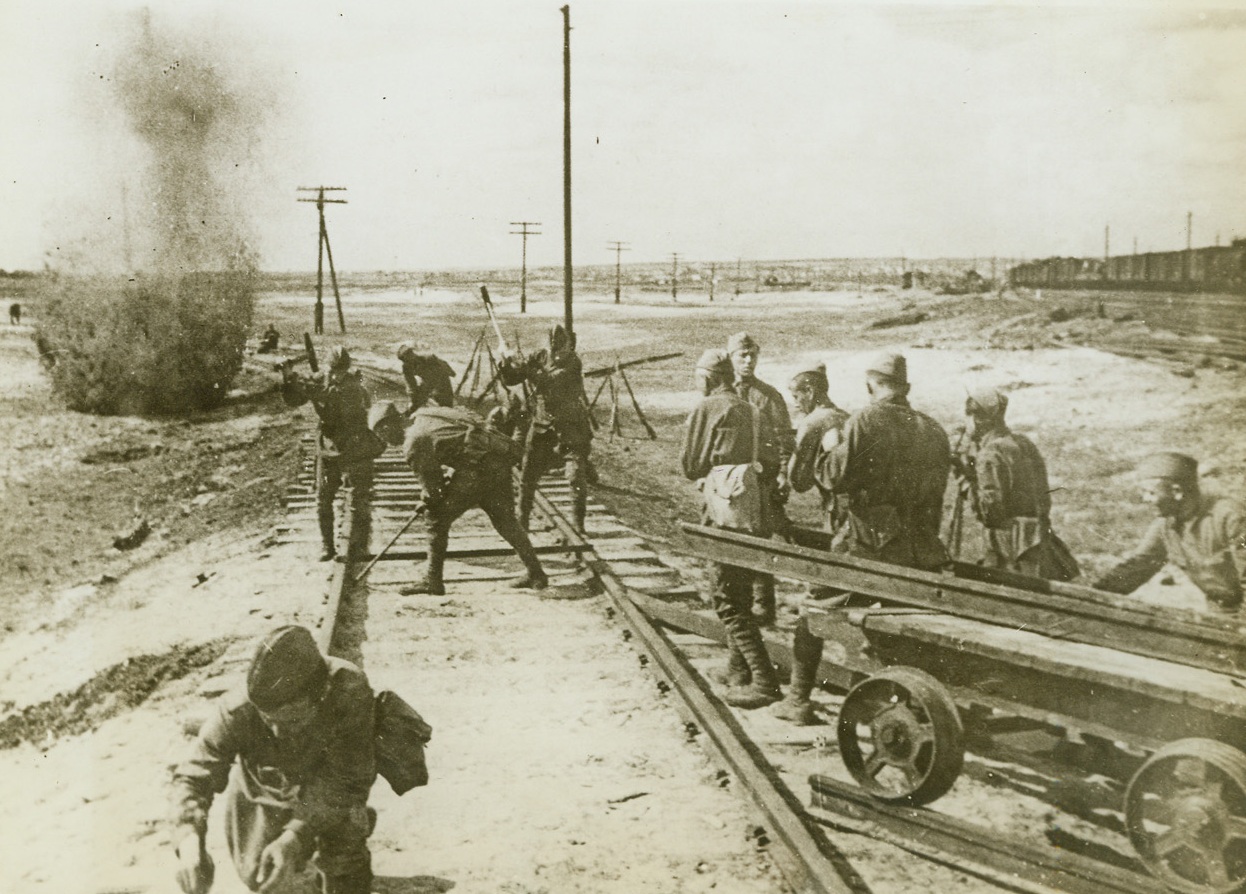
Red “Track Team” Under Fire, 1/26/1943. Southwestern Front—Although under heavy shell fire from the enemy, these Russian engineers repair and re-lay the track of a railway line in territory recently recaptured from the Nazis. It’s a tough job for these soldiers, for they often break through German lines to rip up rail lines in the enemy rear areas to cut off their retreat. Then, when the Russians have captured this territory, the lines must be repaired. (Passed by censors). Credit: ACME.;

Workers’ Defense, 1/26/1943. Stalingrad, U.S.S.R.—Members of a workers’ battalion defend their plant in Stalingrad. Latest dispatches from Moscow indicate that Red Army forces on the Voronezh front have thrown back enemy troops and are now in complete possession of Voronezh.;
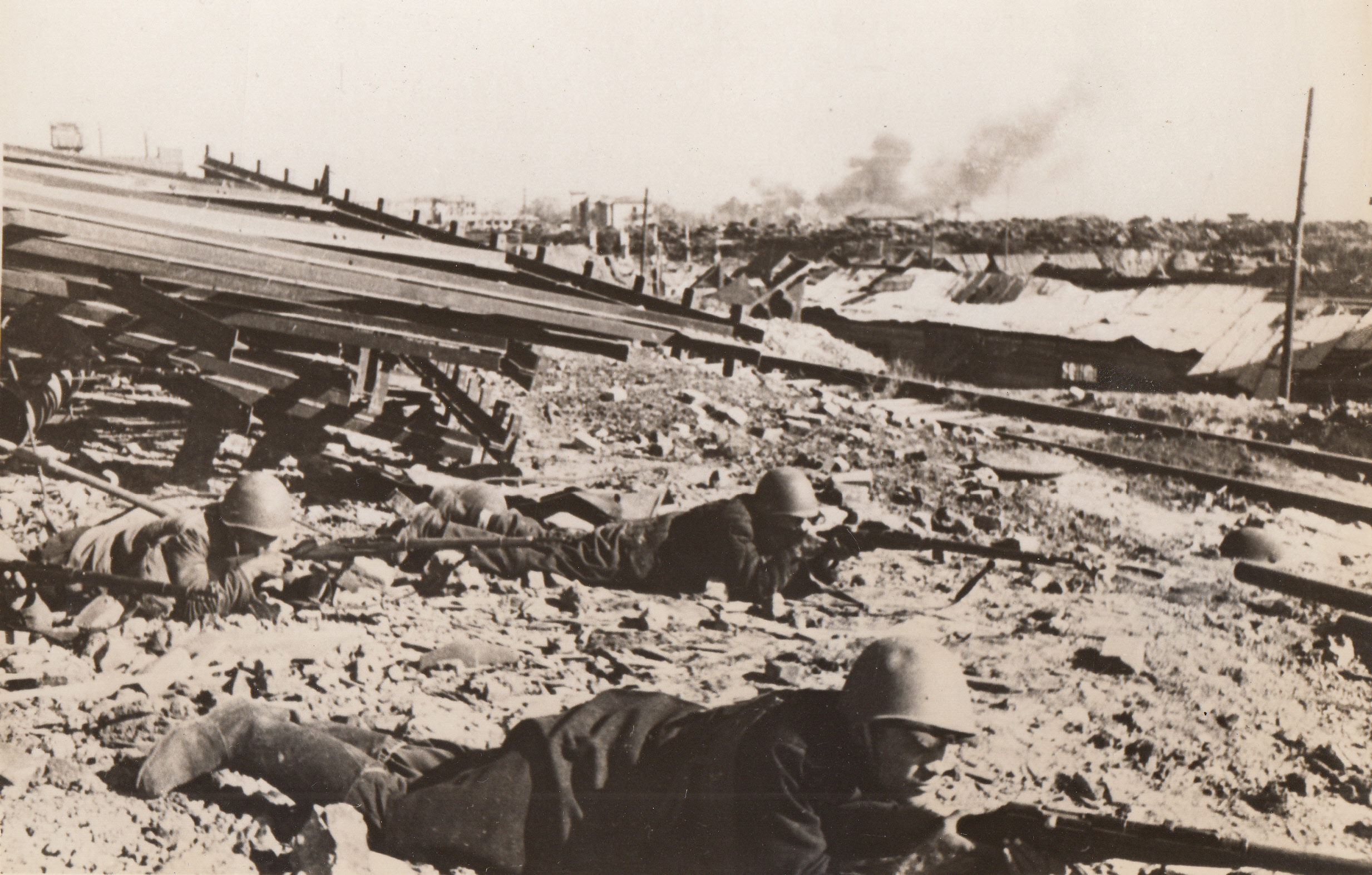
Destroyed Tenements, 1/26/1943. Stalingrad, U.S.S.R.—Blocks of tenement houses that were homes of workers in a nearby Stalingrad plant are shown in ruins after an enemy air raid. Latest reports from Moscow indicate that Russian troops have completely thrown back the enemy on the Voronezh front and now occupy that town. Passed by censor. Credit: ACME.;
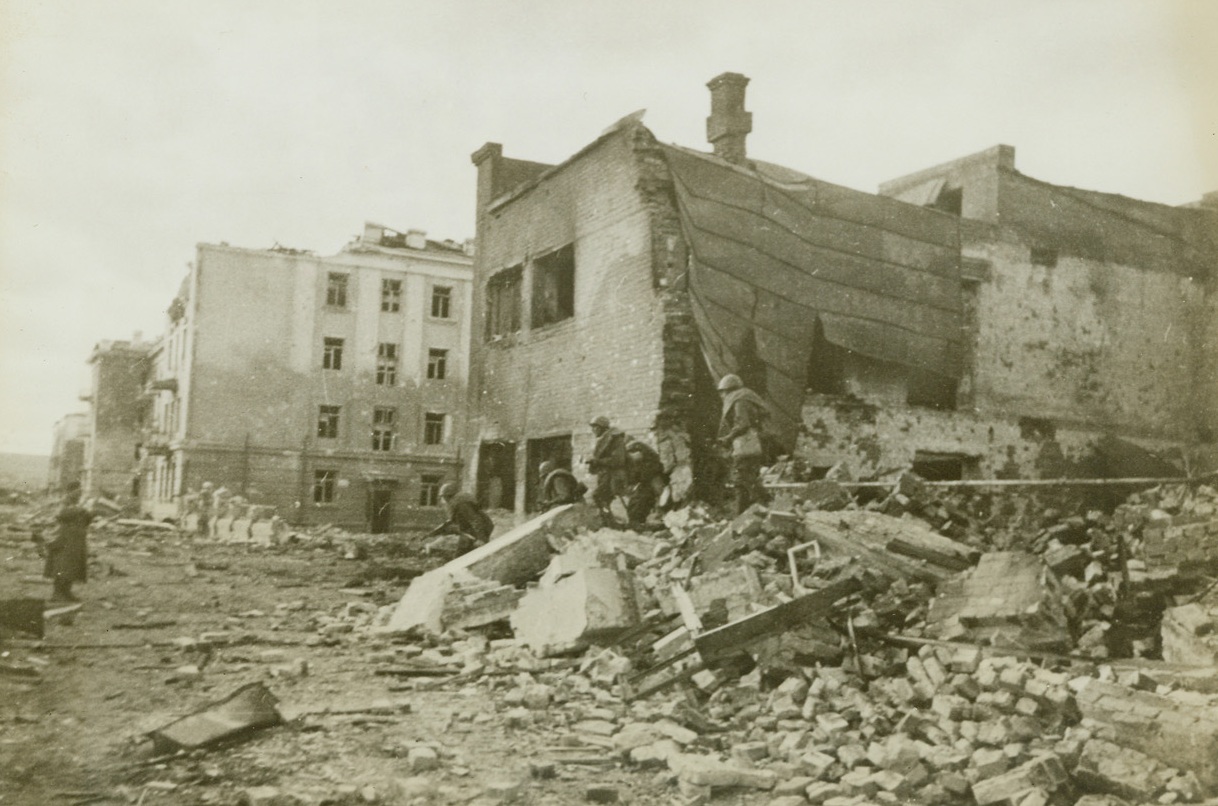
Casualties on Russian-Bound Convoy. 1/16/1943. Somewhere in the North Atlantic—Taken by a U.S. Naval officer from the deck of his ship, these photos show, top: a United States merchant ship at the moment it was struck by an enemy aerial torpedo; and bottom: smoke billowing from an Allied ship after an enemy plane, hit by anti-aircraft fire, crashed into it. The vessel at the right is truning to avoid the explosions from the victim ship. Credit: Official Navy photos from ACME.;

Casualties on Russian-Bound Convoy, 1/16/1943. Somewhere in the North Atlantic—Taken by a U.S. Naval officer from the deck of his ship, these photos show, top: a United States merchant ship at the moment it was struck by an enemy aerial torpedo; and bottom: smoke billowing from an Allied ship after an enemy plane, hit by anti-aircraft fire, crashed into it. The vessel at the right is truning to avoid the explosions from the victim ship. Credit: Official Navy photos from ACME.;
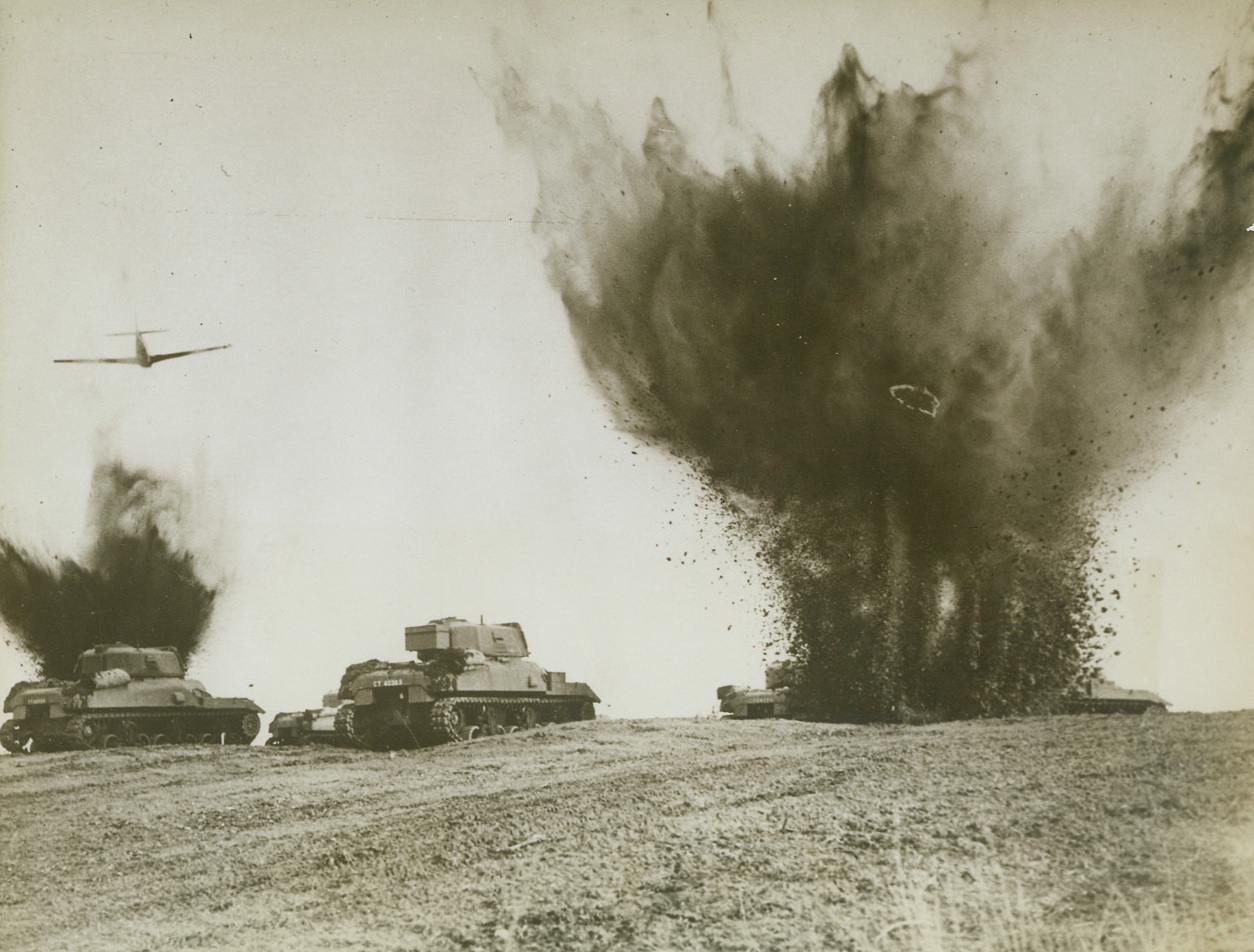
Dress Rehearsal, 1/14/1943. Somewhere in South England—This realistic dress rehearsal for their next big offensive against the enemy is carried out by Canadians stationed in England. Negotiating minefields, with mines exploding, Canadian tanks go through their grueling maneuvers with an aerial escort of mustang fighters constantly on the lookout for air attacks by the enemy. Passed by censor. Credit: ACME.;

Shipboard Fighters, 1/6/1943. NEW YORK - A line of Grumman "Wildcat" fighters stand ready to spread their folded wings and take off. They are the standard shipboard fighters of the Royal Navy as well as the U.S. Navy. The folding wing practically doubles the number of planes that American and British flat-tops can carry, thereby giving the United Nations a tremendous advantage over enemy carriers of equal tonnage.;
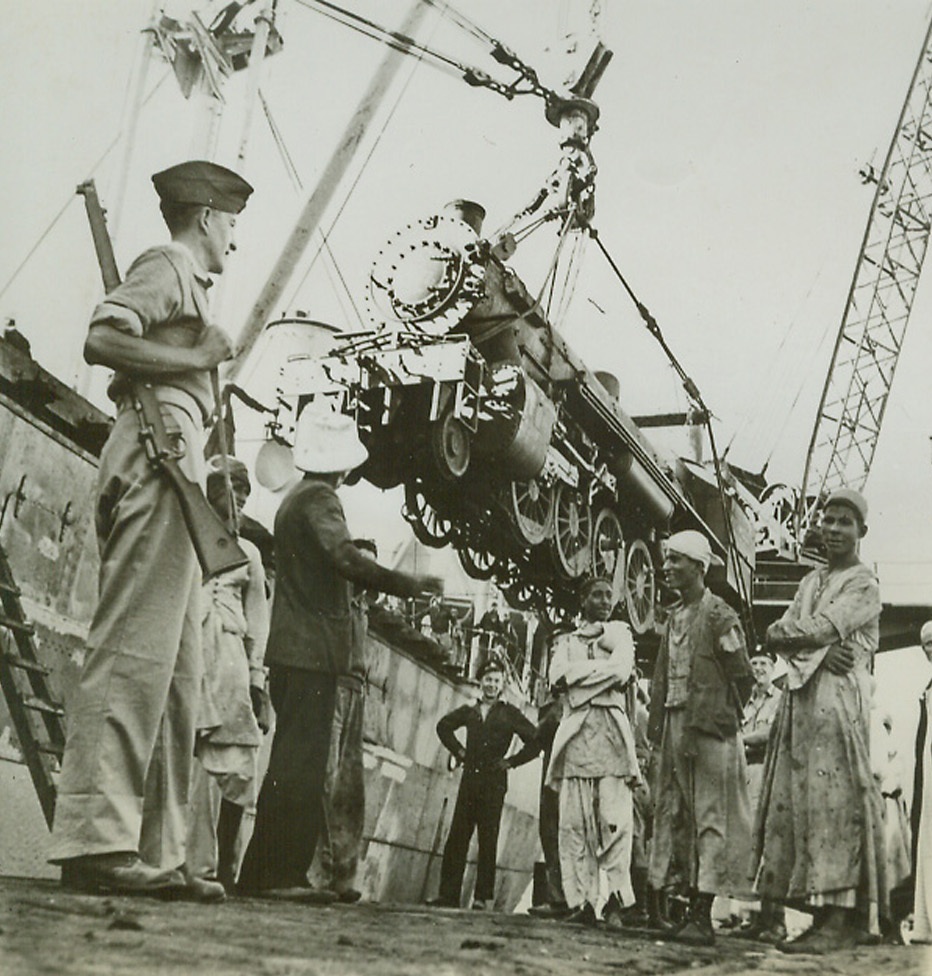
No Title, 1/19/1943. This American Baldwin locomotive, built specially for use in foreign lands, is loaded aboard ship. The engine had reached the port on another vessel and is being transshipped to another port. This photo has just been received in New York.Passed by censors.Credit: ACME.;
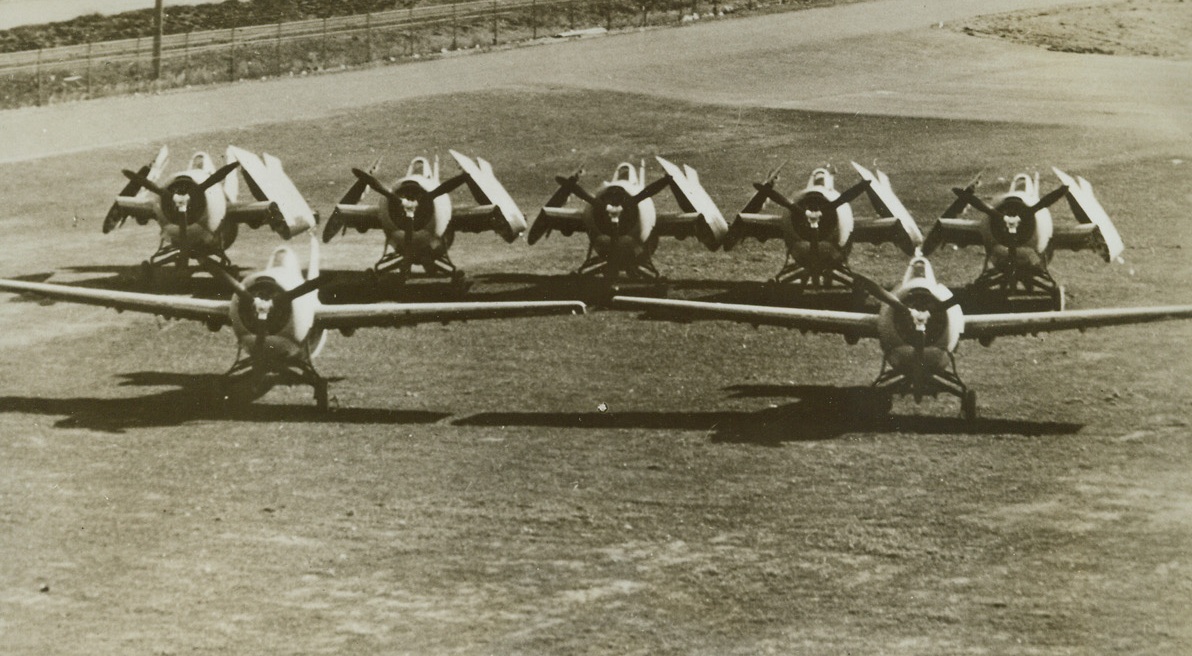
More Parking Space, 1/13/1943. New York—Seven Grumman “Wildcats” line up to give a graphic demonstration of the value of the plane’s famous folding wing. Photo shows how five planes with folded wings can be stored in the same space that two, with fixed wings, require. Adoption of the “Wildcats” for US Navy and Royal Navy Carriers has practically doubled the number of planes they can carry and has given both Navies a tremendous advantage over enemy carriers of comparable tonnage. Passed by censors.Credit: ACME.;
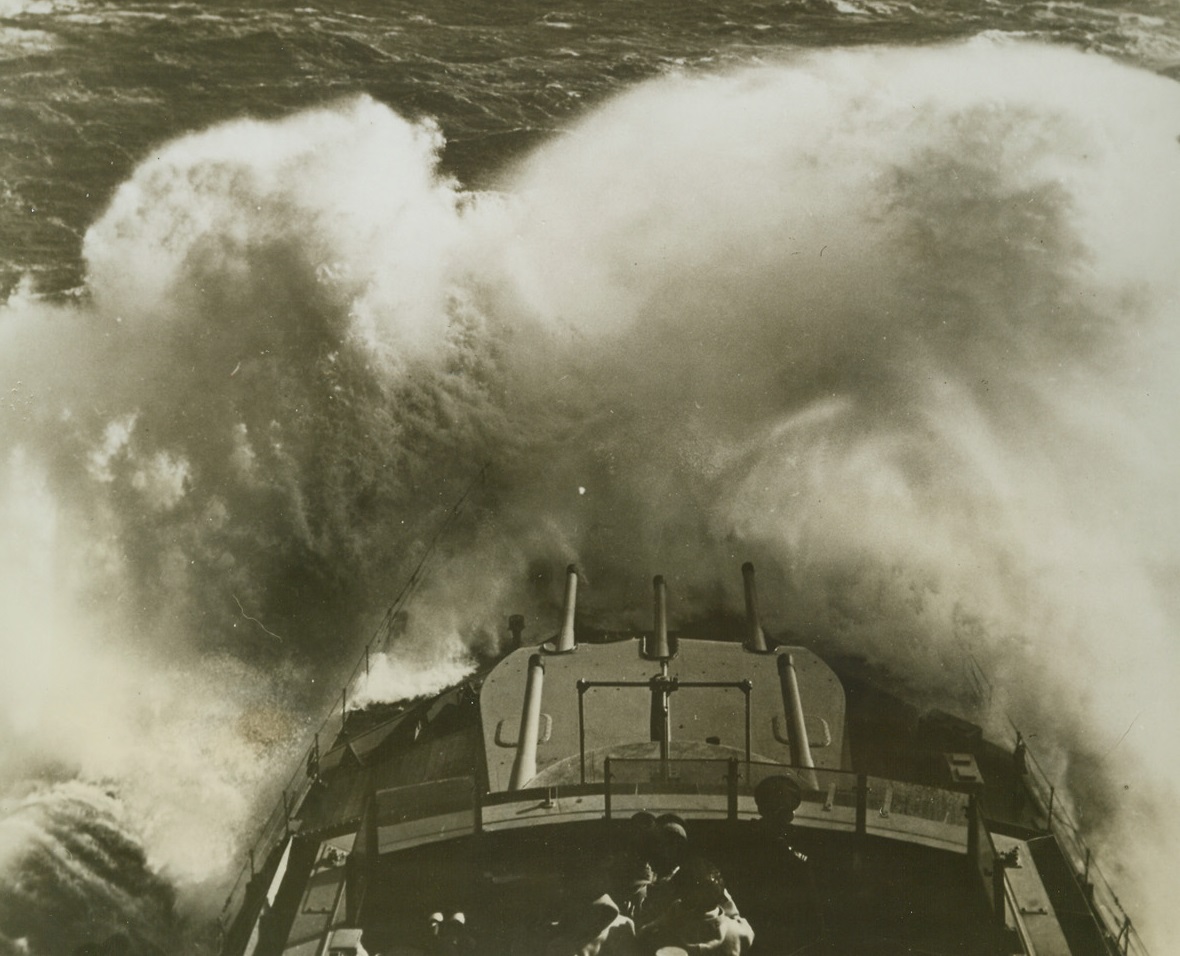
Bucks the Seas During Speed Test, 1/26/1943. In a bursting fountain of spray, a British Cruiser, repaired in a U.S. port under lend-lease, drives full speed ahead through heavy seas in a speed trial off the American Coast. The bow of the warship was almost entirely hidden by cascading salt water which threatened to engulf the entire forward structure. Officers checking the ship’s performance are on the bridge in the foreground. Credit: U.S. Navy official photo from ACME;
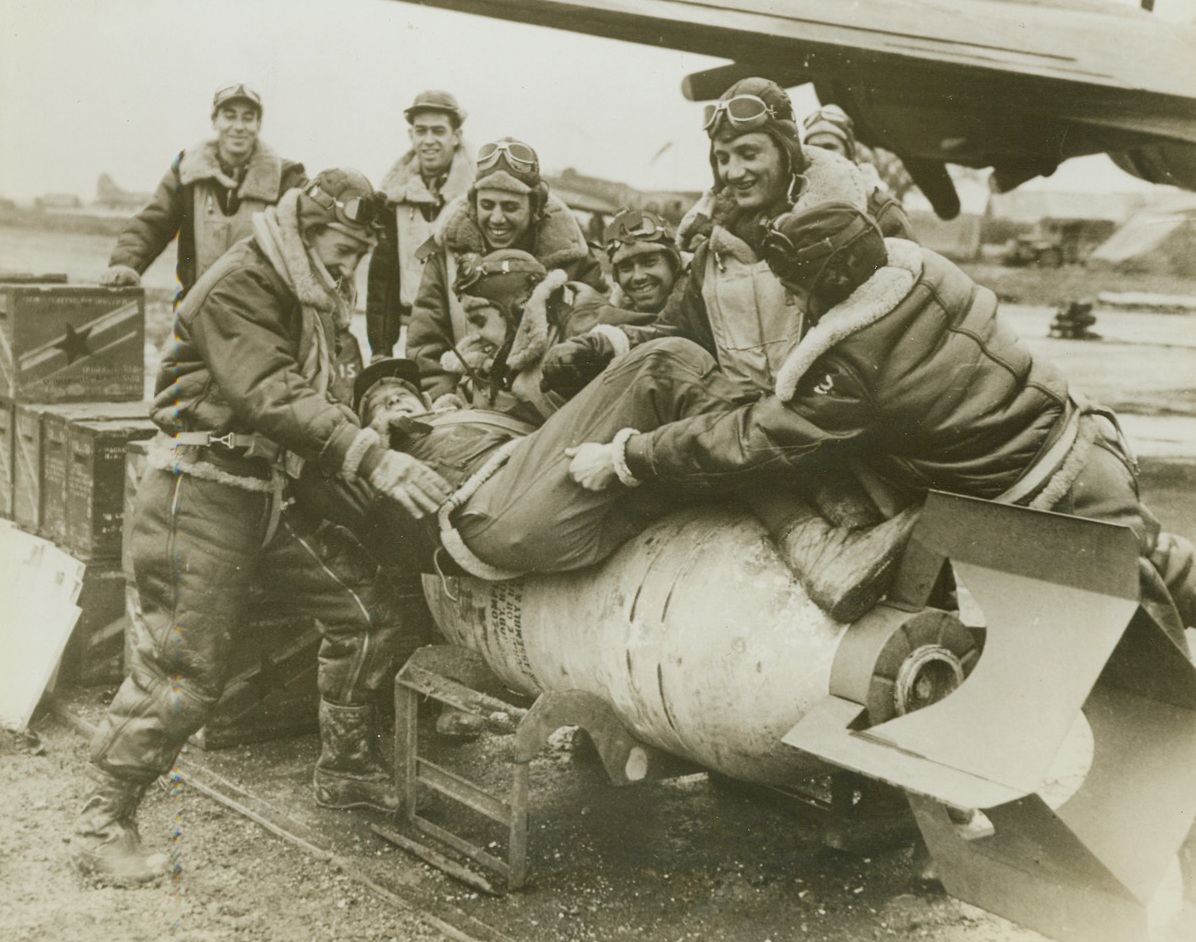
Want to Go See a Nazi?, 1/7/1943. Somewhere in England – Some of the Americans who recently shot down 19 enemy fighters in the greatest raid on Rouen threaten to fasten co-pilot Lt. Edward P. Maliszewski, of Grosse Point, Michigan, to a “block-buster.” The fighters shown here are the crew of Lt. Robert Riordan, who downed four Nazi fighters in the Rouen action. It was the second time Riordan was credited with four kills during a single battle, but he is better known for having brought his Fortress home so shot up that King George told him, “I don’t see how you did it.” This photo of the American aces at play is an exclusive ACME photo. Credit: ACME;

Thar’s a Sub Down Thar, 1/7/1943. Somewhere in the Atlantic – Depth charges from an RCAF Atlantic coastal patrol bomber rain down to the sea, churning the water all around the spot where the conning tower and afterdeck of a Nazi sub could be seen only a few moments before. Passed by censor. Credit: ACME;
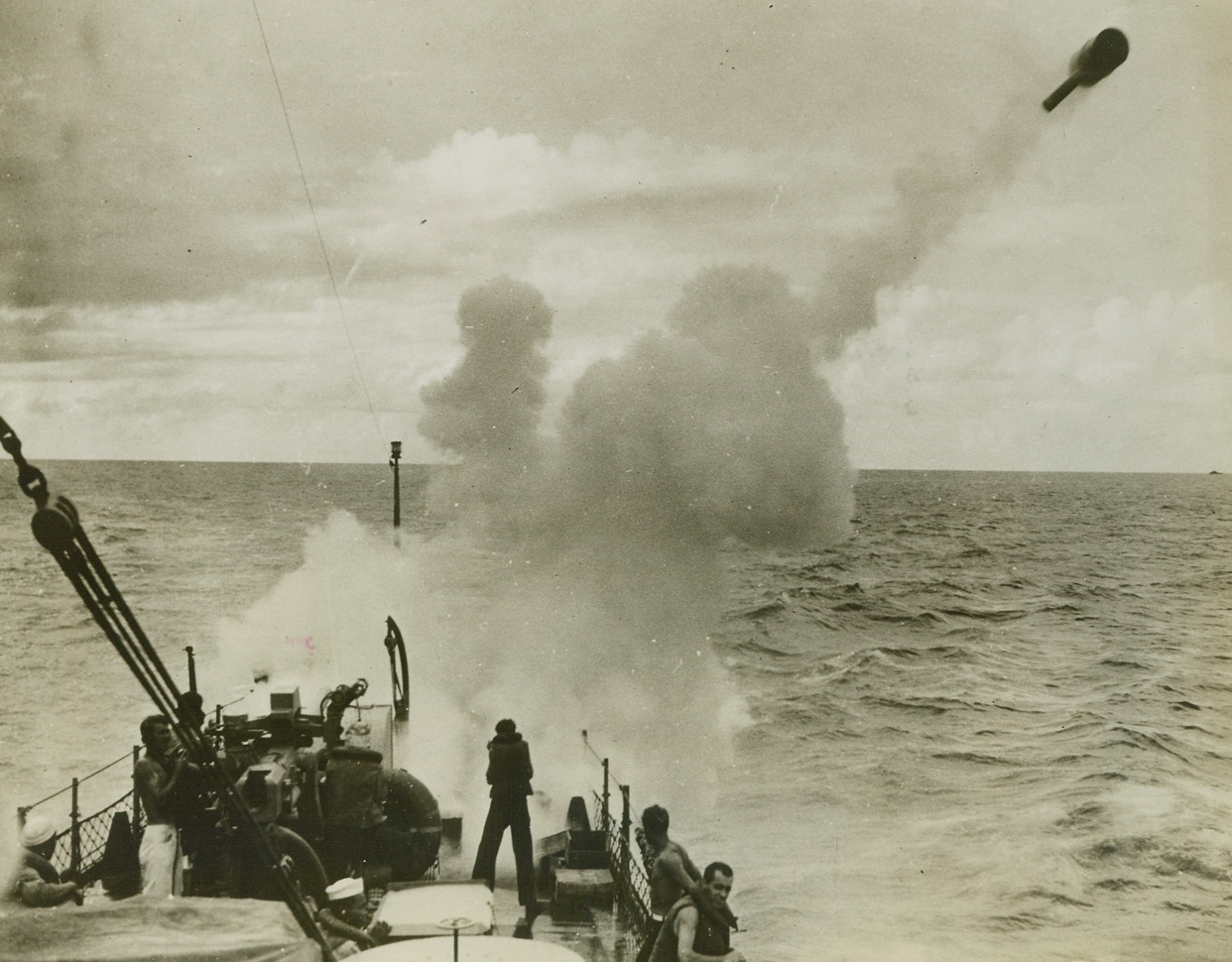
An “Ashcan” in Flight. 1/26/1943. A depth charge is fired from a “Y” gun by a RC boat patrolling the coast. Speedy, maneuverable submarine chasers like these are helping to cut the submarine shipping toll along the Atlantic coast. Credit: Official U.S. Navy Photo from ACME;
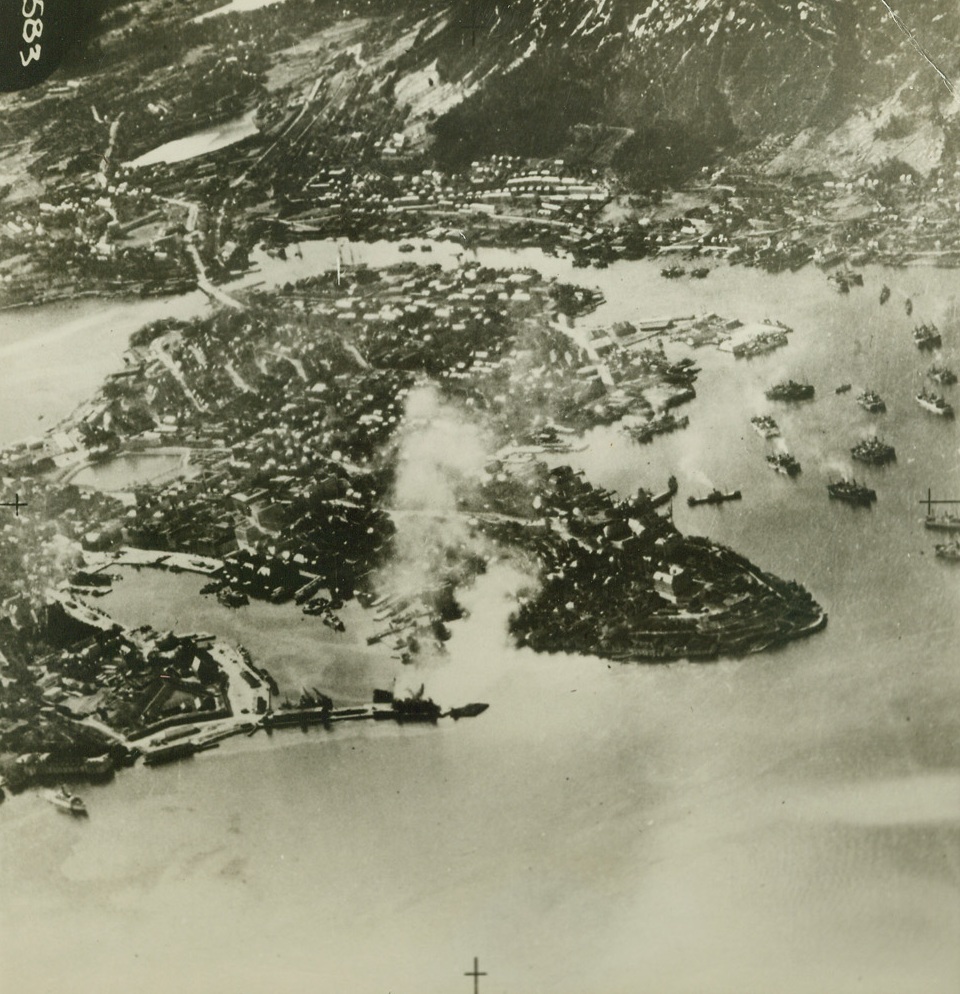
RAF Over Bergen Harbor, 1/13/1943. London, England – Photo was made by planes of the RAF coastal command, flying over Bergen Harbor during an RAF attack. The harbor is crowded with German transports and supply ships, one of which is burning at the quayside after the attack. Photo will soon be published in a book, showing the value of photographic reconnaissance work by the RAF coastal command, in the destruction of enemy equipment by the United Nations. Passed by censors. Credit: ACME;
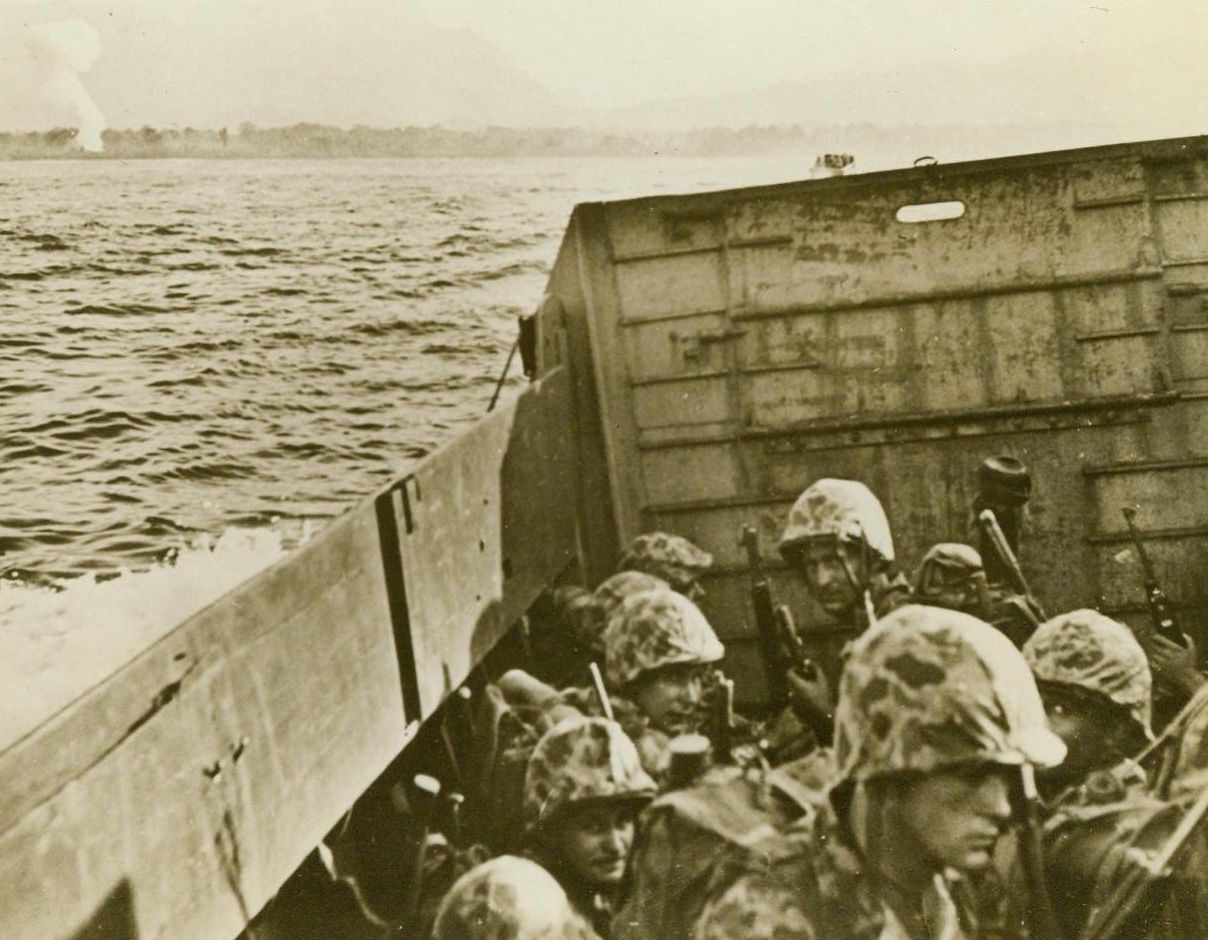
Ready For The Jungles Of Bougainville, 1/23/1943. South Pacific -- Crouching low in their landing craft, U.S. Marines approach Empress Augusta Bay, Bougainville Island, in the South Pacific. They are ready with camouflage suits for the jungle fighting that followed the rushing of the beaches. 1/23/43 (ACME);
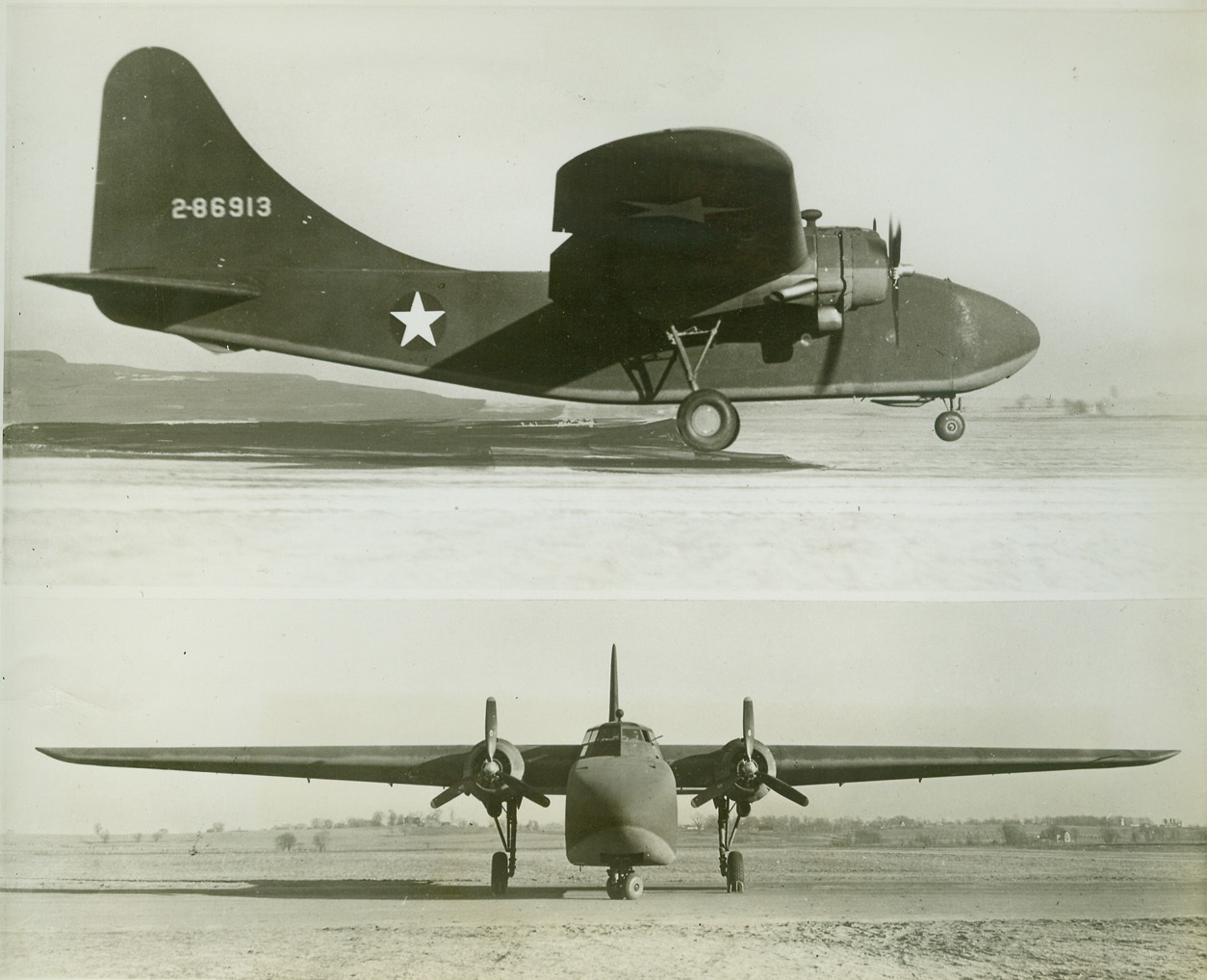
Wooden Army Air Freighter Passes Test, 1/6/1943. St. Louis—Two views of the Curtiss-Wright Caravan, America’s first military plane built specifically for carrying freight and made of plastic plywood, after a successful test flight at St. Louis. Credit: ACME;
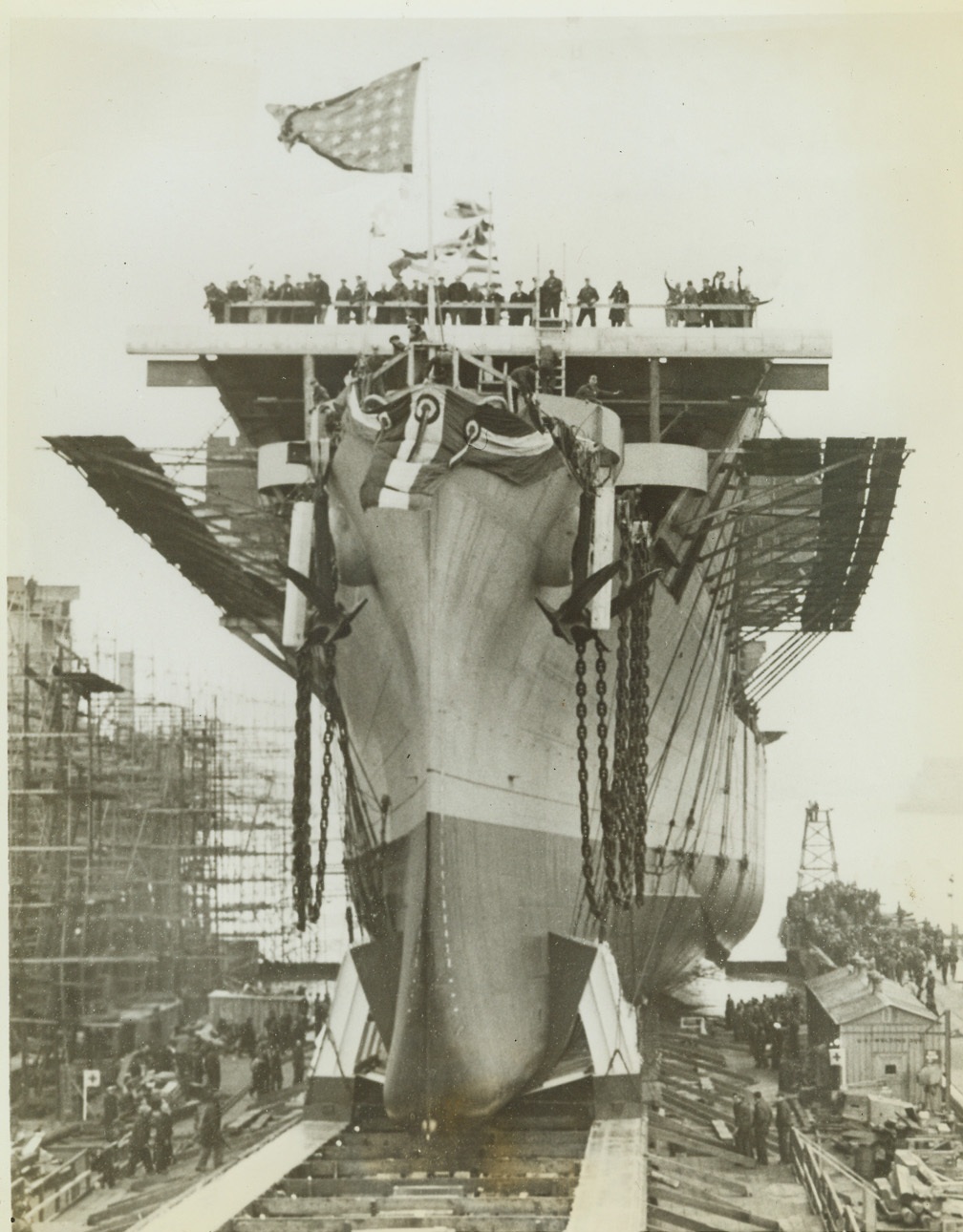
“Cowpens” Goes Down the Ways, 1/17/1943. Camden, N.J.—The U.S.S. Cowpens, an aircraft carrier named in memory of a Revolutionary War battle fought at Cowpens, S.C., goes down the ways at the New York Shipbuilding Corps Yards in Camden. Launched on Jan. 17, the Cowpens is the fourth carrier to be launched by the corporation in 20 weeks. Mrs. Preston Lea Spruance, daughter of Admiral William F. Halsey, sponsored the vessel. Credit: ACME.;
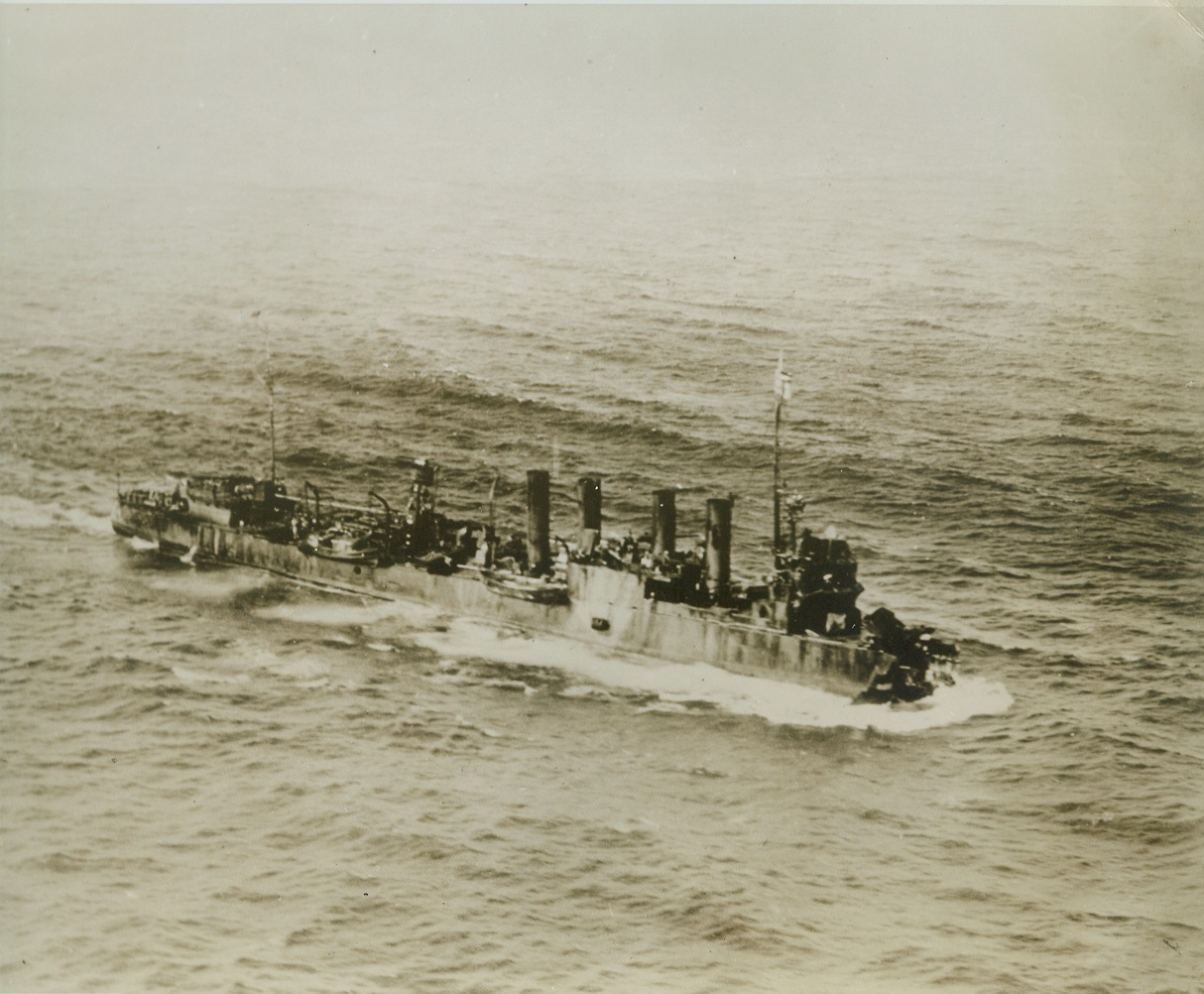
Minus a Bow-But Still Afloat, 1/7/1943. Somewhere in the Carribean—Minus a bow, but still afloat, the torpedoed U.S.S. Blakeley labors her way to a Carribean port for temporary repairs on her way home. Although she was one-fifth demolished when an enemy torpedo hit her last May, the old four-stacker destroyer is back at sea again, doing her job for Uncle Sam. Workmen accomplished a remarkable feat, repairing the vessel by cutting the entire bow off the Taylor, a sister ship to the Blakeley, and “grafting” it onto the bowless destroyer. Credit: U.S. Navy official photo from ACME.;
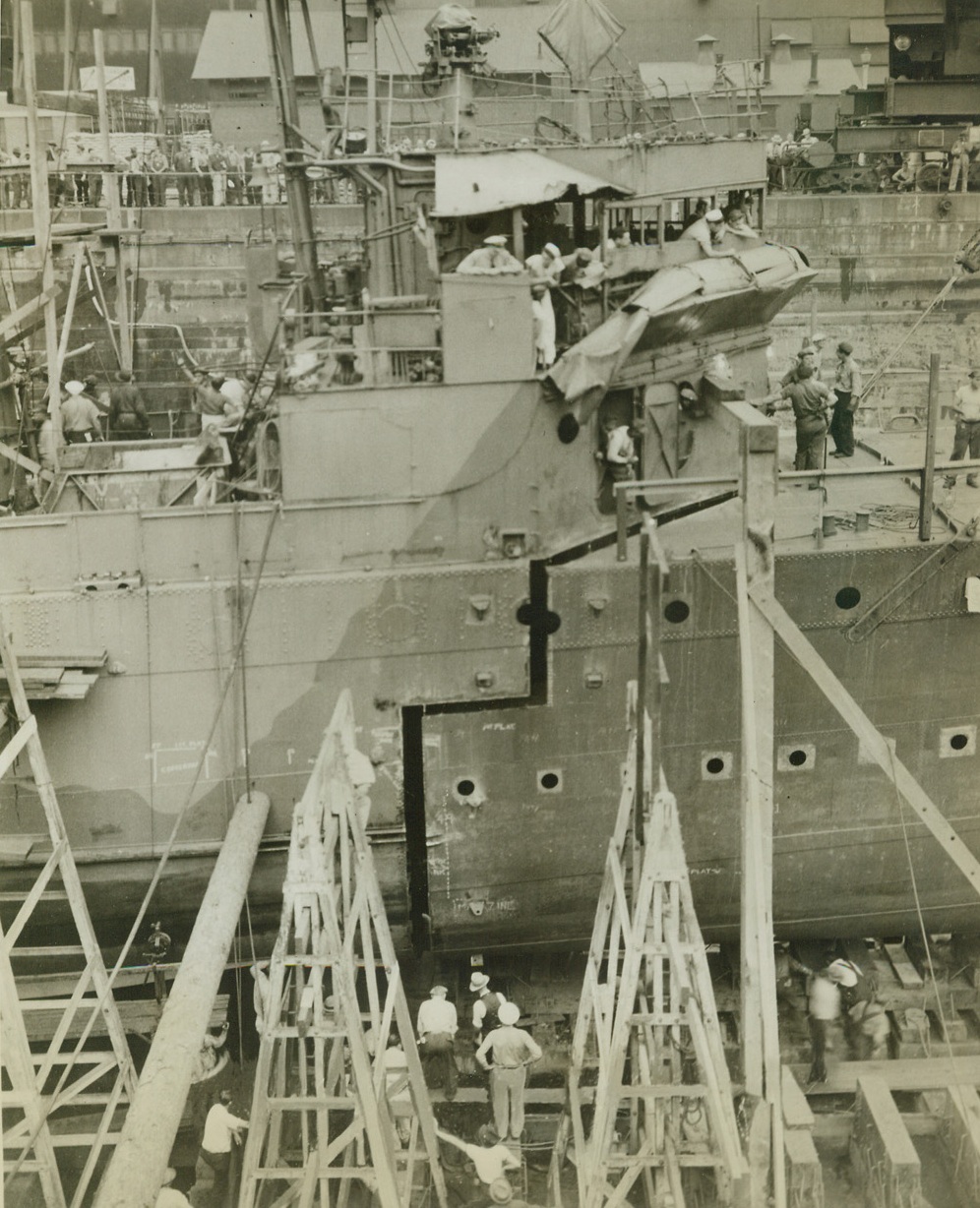
Jig-Saw Puzzle, 1/7/1943. Philadelphia, PA.—Fitting together as neatly as two parts of a jigsaw puzzle, the bow, cut from the decommissioned U.S.S. Taylor, is fitted to the U.S.S. Blakeley, her sister ship. The Blakeley, an old four-stacker destroyer, was badly damaged by an enemy torpedo last May. Grafting parts of her sister ship to the damanged destroyer, Navy workmen have turned the hardy vessel back to sea, good as new, with a greater firepower and cruising radius than she had before. Credit: Official U.S. Navy photo from ACME.;





 Trash & Recycling
Trash & Recycling
 Online Payments
Online Payments
 City Documents
City Documents
 Parks
Parks
 Traffic Court
Traffic Court
 CITY PARKS
CITY PARKS
 RECREATION
RECREATION
 Volunteer
Volunteer
 Home
Home TRANSLATE
TRANSLATE
